World Social Protection Report 2024–2026
Universal social protection for climate action and a just transition
Chapter 4. Strengthening social protection for all throughout the life course
For social protection systems to play their key role for climate action and a just transition, they need to provide adequate protection for everyone throughout their lives. Structured along the four social protection guarantees provided in Recommendation No. 202, this Chapter delves into income security for children and families (section 4.1), people of working age (section 4.2) and older people (section 4.3), while section 4.4 focuses on social health protection.
.4.1 Social protection for children and families
Key messages
-
It is time to up the ante. Progress in the extension of social protection has occurred, but access to inclusive and integrated social protection remains elusive for the vast majority of children – only 23.9 per cent of children aged 0 to 18 globally are covered by child cash benefits. This equates to 1.8 billion children of this age range missing out.
-
Given the well-recognized poverty reduction properties of social protection (on both monetary and multidimensional child poverty), this protection gap prompts deep concern considering that children make up more than half of the world’s extreme poor. Today, 333 million children are still living below the extreme poverty line, 1.4 billion children are living below the higher international poverty line and almost 1 billion children live in multidimensional poverty. Some 1.9 billion children – 80 per cent – are at high climate risk.
-
The positive impacts of social protection for children are beyond question. Extensive evidence shows that child-sensitive social protection reduces poverty while also contributing to income security in households, protects against child labour and has broader significance for child health, early childhood development, education and food security. However, in the absence of social protection, these basic conditions for well-being are less likely to be met during childhood, creating lasting conditions that are difficult to rectify in later life.
-
Children, especially those in poverty, are bearing the brunt of the climate crisis. This unfolding crisis is tantamount to “structural violence against children” and compromises their well-being and prospects. It also underscores the importance of making social protection systems more inclusive and resilient so that they continue to achieve their core objectives and support the additional needs that climate change is creating. Investment in social protection for all children is crucial for intergenerational solidarity and equity, and an essential investment to uphold the rights of future generations. It will also support the capability formation and requisite skills development of children that a green transition will demand.
-
To close protection gaps and achieve positive impacts for all children, expenditure needs to increase, especially in the early years. Analysis of age-related spending shows that all children – and the families in which they live – are underserved in terms of social protection, particularly in early childhood. On average, 0.7 per cent of GDP is spent on child benefits globally. Again, large regional disparities exist: the proportion ranging from 0.2 per cent in low-income countries to 1.0 per cent in high-income countries.
4.1.1 The role of social protection in addressing persistent poverty and socio-economic vulnerabilities for children, exacerbated by compounding crises, including climate
Social protection is an investment that contributes to children enjoying their rights and accessing the support they need. When social protection is absent, children are at a higher risk of multiple child rights violations and are exposed to the long-lasting impacts of child labour, disease, missed education, poor nutrition and poverty.
The unfolding climate crisis carries an extremely high poverty risk for children and has been deemed “a form of structural violence against children” (UN 2023e). One in four deaths among children under 5 years old worldwide is the result of avoidable environmental damage and the climate emergency (UNICEF Innocenti 2022). Children are especially vulnerable, owing to the spread of more deadly diseases, lower ability to regulate body temperatures in heatwaves, and malnutrition from greater food insecurity (UNICEF 2023b).
From an intergenerational equity and social justice perspective, readying children for even 1.5°C of warming alone should be sufficient motivation for policymakers to build social protection systems and other key services for all children. Evidence from global research conducted by UNICEF demonstrates that, globally, only 46 parties have included child-sensitive social protection commitments in their key climate policy documents (UNICEF, forthcoming). Ultimately, governments must escalate their SDG commitments to end extreme child poverty and increase social protection coverage of children.
Impact of COVID-19 on child poverty
In the last decade, there has been a large reduction in the absolute number of children living in extreme child poverty. However, during the period 2019–22, estimates suggest that poverty reduction has stalled, and that three years of progress have been lost, mainly because of COVID-19. Poverty would have increased even further without the central role of social protection in containing its impoverishing effects (ILO and UNICEF 2023).
COVID-19 is just one of the compounding crises experienced by children and their families in recent years, suggesting that other global concerns, such as the climate crisis, are likely to act as a drag on the progress needed for children.
Between 2013 and 2022, extreme child poverty rates fell from 20.7 to 15.9 per cent. In real terms, this meant that the number of children living in extreme poverty fell by 49.2 million. Notably however, rates were already at 15.9 per cent in the year before the COVID-19 pandemic. This points to “three years of lost progress” for children living in extreme poor conditions. Estimates suggest that, without this lost time, another 30 million children would have escaped extreme child poverty worldwide (Salmeron-Gomez et al. 2023).
The most recent figures from the World Bank and UNICEF show that 333 million children are still living in households with an income lower than US$2.15 per person (extreme poverty line). At the higher international poverty lines, a staggering 820 million children live on less than US$3.65 a day (lower-middle-income poverty line), and 1.4 billion children are living on less than US$6.85 a day (upper-middle-income poverty line) – or 3 in 5 children worldwide (Salmeron-Gomez et al. 2023). In addition, approximately 1 billion children experience multidimensional poverty, deprived of their basic rights to health, nutrition, water, sanitation, education and shelter (UNICEF 2021a).
Global figures hide the increased risk that many children experience when it comes to extreme child poverty. Not only are there large differences by regions of the world, national income levels and experiences of conflict and fragility, but personal and family attributes also play a role – for instance, children who experience disabilities or have family members with disabilities, or girls and women when compared to boys and men. Families who care for a person with a disability experience both a loss in earned income (lost earnings potential as care time increases) as well as higher living costs due to additional expenditures related to that care. Women and girls are over-represented globally among the poorest and are disproportionately impacted by multiple intersecting deprivations due to social and economic exclusion and restrictive gender norms and expectations. Yet, social protection often fails to incorporate and address gendered risks, needs and opportunities. Many other categories of children are at a higher risk of poverty – such as migrant or forcibly displaced children, indigenous children and children living in remote settings – and this must inform the design of social protection policies for children.
Child poverty risks and the climate emergency
The climate emergency represents a major threat to progress in reducing child poverty risks worldwide. The direct and indirect child poverty risks take different forms from sudden-onset events (for example, flash floods), slower-onset changes (for example, desertification) and environmental degradation (UNICEF 2021b).
Child poverty is both a driver of vulnerability and a result of overall climate risk. Firstly, children in poverty are more exposed to climate risks. Six out of ten children already living in multidimensional poverty are expected to experience at least one climate risk a year, and three out of ten children live in provinces with very high climate risks and a high concentration of multidimensionally poor children (Global Coalition to End Child Poverty 2023).
Secondly, lower-quality housing, poor water and sanitation facilities, existing food insecurity, health issues and inadequate access to information, mean that children in poverty are more likely to suffer harm once a climate shock hits. Poor families with children also have fewer coping capacities to respond to negative effects or adapt to a changing climate due to fewer financial resources. They also have limited social protection; children living in higher-risk environments have less access to social protection (see figure 4.5). In high-income settings, children in poorer households and other disadvantaged subgroups also experience the greatest environmental risk and harm (UNICEF Innocenti 2022).
Climate risks are disproportionally exacerbated for those vulnerable to intersectional inequalities relating to race, gender, caste, class and gender (Lankes, Soubeyran, and Stern 2022). These intersectional inequalities impact exposure to climate-related shocks and influence the strategies used to cope with the impact.
Finally, extreme weather events, slow-onset impacts and other climate-related shocks can exacerbate child poverty. They can directly impact families, children’s living standards and poverty risks, by destroying homes, farms and communities. This, in turn, affects productivity and increases the risk of illnesses, including poorer mental health. Indirectly, the disruption of public service provision, like health, nutrition, drinking water, sanitation and hygiene and education – all of which significantly impact children’s access to care, and the destruction of natural resources – have a knock-on effect on child poverty and development (Diwakar et al. 2019; Lankes, Soubeyran, and Stern 2022).
Since poorer people have higher exposure to natural hazards related to climate shocks, and fewer resources to respond effectively, the risks associated with climate-related shocks and stressors need to be addressed. This means protecting consumption, promoting asset building and productivity, and creating opportunities for families to diversify from activities they used to rely on for their livelihoods (Hallegatte et al. 2014) through short-run, rapid, inclusive, climate-smart and targeted adaptation interventions (Hallegatte et al. 2016).
Based on the aforementioned evidence and coverage concerns, social protection and essential services to support children exposed to climate-related risks and families living with climate emergencies are critically needed. Strengthening households’ resilience and coping strategies in response to climate shocks requires investing in robust social protection systems, and enhancing their shock responsiveness. Such systems can be scaled up in advance or in the aftermath of a (climate) shock (Global Coalition to End Child Poverty 2023).
Realizing the right of children to social protection is indispensable for combating child poverty and promoting children’s well-being
Social protection policies are powerful tools in alleviating poverty for children and their families. They protect families at risk of falling into poverty; they help all children connect to key services, such as health and education; and they protect children from other major risks, such as child labour (box 4.1). Overcoming these challenges is essential for realizing the rights and full potential of all children (box 4.2). Ensuring children’s rights to social protection and to an adequate standard of living, health, education and care, and achieving the 2030 Agenda, requires a conducive policy framework that prioritizes the needs and requirements of children and their participation in the process.
Box 4.1 Social protection, child labour and the climate crisis
|
Recent evidence compiled by the ILO and UNICEF (2022) shows that integrated social protection systems are powerful instruments to combat child labour (ILO 2013c). The climate crisis further emphasizes that strengthening social protection is a prerequisite for ending the scourge of child labour. Today, 160 million children are engaged in child labour. That is almost one in ten children worldwide (ILO and UNICEF 2021). The climate crisis will be an additional threat multiplier for child labour (ILO 2023m), primarily through increased poverty, but other channels will also heighten child labour risks. These channels include: changes to agricultural productivity; climate-related extreme weather shocks; climate-driven migration and conflict; health issues; and destruction or degradation of basic services infrastructure (ILO 2023m). The probability of increased child labour makes social protection all the more indispensable as a means to contain this risk. However, most children engaged in child labour lack social protection (ILO and UNICEF 2022). |
Box 4.2 The right of children to social protection
|
The right of children to social protection is underlined in Articles 26 and 27 of the United Nations Convention on the Rights of the Child, which stipulates that “States Parties shall recognize for every child the right to benefit from social security, including social insurance, and shall take the necessary measures to achieve the full realization of this right in accordance with their national law” (Article 26). The United Nations legal framework contains several provisions spelling out the various rights of children that form part of their right to social protection. These include: the human right to social security, taking into consideration the resources and circumstances of the child and people having responsibility for the child’s maintenance;1 the right to a standard of living adequate for the child’s health and well-being; and the right to special care and assistance.2 The International Covenant on Economic, Social and Cultural Rights further requires States to give the widest possible protection and assistance to the family, particularly with respect to the care and education of dependent children (Art. 10(1)). Complementing human rights instruments, international social security standards are also part of the United Nations normative framework, with specific guidance on coverage, adequacy and key policy principles at the heart of a rights-based approach. The comprehensive ILO Social Security (Minimum Standards) Convention, 1952 (No. 102), sets minimum standards for the provision of family (or child) benefits in the form of a periodic cash benefit, benefits in kind (including food, clothing or housing) or a combination of both (Part VII). The ILO Social Protection Floors Recommendation, 2012 (No. 202), emphasizes the universality of protection. It sets out that all children should have access to at least a basic level of social security – including access to healthcare and income security – allowing for access to nutrition, education, care and any other necessary goods and services to live in dignity. The basic social security guarantees of the nationally defined social protection floor should apply, at a minimum, to all residents and children, as defined in national laws and regulations and subject to existing international obligations (Para. 6), including under the Convention on the Rights of the Child, the International Covenant on Economic, Social and Cultural Rights and other relevant instruments. Representing a rights-based approach strongly focused on outcomes, Recommendation No. 202 allows for a broad range of policy instruments to achieve income security for children, including child and family benefits (the focus of this report), as part of a broader portfolio of interventions. Moreover, this framework provides valuable insight for implementing a life-cycle approach to social protection that is suitably holistic, comprehensive and adequate to address all child rights. 1 Universal Declaration of Human Rights, 1948, Art. 22; International Covenant on Economic, Social and Cultural Rights, 1966, Art. 9; United Nations Convention on the Rights of the Child, 1989, Art. 26. 2 Universal Declaration of Human Rights, Arts 25(1) and (2). |
4.1.2 The importance of ensuring child-sensitive social protection systems
Entitlement to child and family cash benefit schemes
Child and family cash benefit schemes constitute an important element of child-sensitive1national social protection systems and play an essential role in ensuring income security for families. The proceeding section provides an overview of the legal coverage of such schemes worldwide.
As of 2024 (see figure 4.1), more than two thirds (145) of the 213 countries or territories for which data is available provide statutory child or family benefits. However, non-statutory programmes may still exist in other countries. Recent child benefit reforms show further progress (see table 4.1). Of the countries or territories with statutory periodic child or family benefits, the latest analysis of legal coverage indicates the following schemes operating worldwide:
-
tax-financed universal or quasi-universal child benefits: 58;
-
contributory schemes only: 29;
-
contributory and tax-financed means-tested schemes (non-universal): 11;
-
tax-financed means-tested schemes only: 47.
Schemes anchored in national legislation are usually more stable in terms of financing and institutional frameworks, and provide legal entitlements to eligible individuals and households, thereby guaranteeing protection as a matter of right. Other schemes include at-scale non-statutory, non-contributory programmes operating elsewhere (see section 3.1, ILO and UNICEF 2023). Other programmes providing cash or in-kind support to children in need exist, which are often limited to certain regions or districts and are generally designed with the objective of reducing poverty. Others exist as a response to humanitarian crises or other non-typical circumstances. These are provided through the government, and/or supported by United Nations agencies, development partners, non-governmental organizations or charities.
Figure 4.1 Social protection for children and families (cash benefits) anchored in law, by type of scheme, 2024 or latest available year
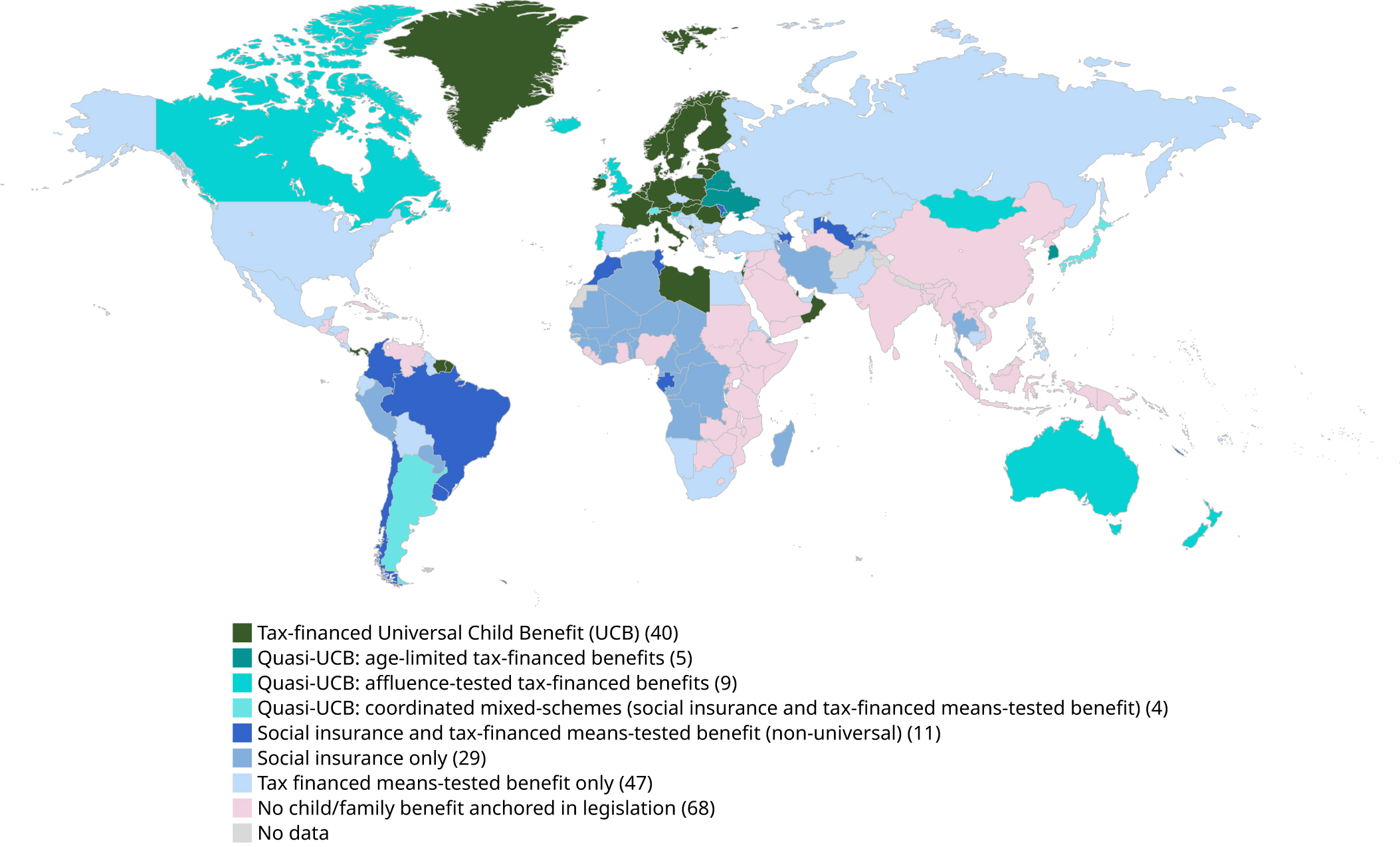
Disclaimer: Boundaries shown do not imply endorsement or acceptance by the ILO. See full ILO disclaimer.
Note: The universal child benefit count is higher than indicated in previous editions of the World Social Protection Report, owing to the inclusion of several territories. The number in parenthesis refers to the count of countries or territories.
Sources: ILO modelled estimates; World Social Protection Database, based on the Social Security Inquiry; ISSA Social Security Programs Throughout the World; ILOSTAT; national sources.
Table 4.1 Child social protection reforms, selected countries, 2021–24
|
Country |
Year |
Adopted or planned measure |
|
Brazil |
2023 |
New supplement in Bolsa Família for children under 6 years old. The Benefício Primeira Infância was introduced to supplement the Bolsa Família with an additional 150 Brazilian reais (US$28) paid each month to 8.9 million children aged 0 to 6 (Government of Brazil 2023b). |
|
Libya |
2021 |
Reactivation of universal child benefit for children under 18 years old. Libya effectively reintroduced its universal child benefit which had been suspended since 2013. A monthly benefit of 100 Libyan dinars (US$20) is paid for all Libyan children aged 0 to 18. |
|
Montenegro |
2022 |
New universal child benefit for children under 18 years old. The Government introduced a universal child benefit for children aged 0 to 18 at the end of 2022. A flat rate monthly benefit of €30 (US$32) is paid for each child. |
|
Oman |
2023 |
New universal child benefit for children under 18 years old. The Government introduced a universal child benefit in 2023 as part of a major reform of its social security system (ILO 2023h). A flat rate monthly benefit of 10 Omani rials (US$26) is paid for each child. |
|
Republic of Korea |
2022 |
Extension of age-limited quasi-universal child benefit, now for children under 8 years old. A quasi-universal child benefit for children aged 0 to 6 was introduced in 2018, extended to children aged 0 to 7 in 2019, and subsequently to children aged 0 to 8 in 2022. A monthly benefit of approximately 100,000 won (US$73) is paid for each child. |
Sources: Based on ILO and UNICEF (2023); ILO, UNICEF and Learning for Well-Being Institute (2024) and information from national sources except where indicated otherwise.
The importance of school feeding
School feeding programmes provide meals (including take-home rations) to school-age children and adolescents. They are critical for child well-being (see box 4.3). Currently, 418 million children worldwide receive free or subsidized daily school meals (WFP 2022). According to WFP (2022), there has been a global increase in government-led school feeding programmes, signifying heightened governmental commitment across different economic levels from 2020 to 2022, with the percentage of countries with school feeding policies increasing from 79 per cent to 87 per cent. This expansion has also created approximately 4 million direct jobs across 85 countries (WFP 2022). School feeding programmes also serve as comprehensive integrated programmes with over 80 per cent of countries incorporating complementary health and nutrition activities, reinforcing their pivotal role in promoting schoolchildren’s well-being.
Combining cash benefits and access to key services and information
Access to cash benefits and childcare services yields multifaceted effects on social mobility, family income and educational outcomes, and reduces deprivations. Recent research indicates enduring effects, particularly in early childhood care and education investments, resulting in sustained growth of family income by increasing women’s labour force participation, and improved life trajectories. Despite the positive impact of cash benefits, the limitations of cash alone are evident, emphasizing the need for complementary interventions to overcome non-financial and structural obstacles (Learning for Well-Being Institute, 2024). “Cash plus” programmes, which integrate cash benefits with other interventions, address multifaceted challenges and maximize transformative potential (UNICEF, Heart and UKAID 2022). Ensuring universal access to health and other services without hardship is also of critical importance for maximizing and sustaining the impacts of cash benefits. It is an essential component of child-sensitive social protection systems (see section 4.4). The role of social workers in promoting children’s well-being is key to connecting them with critical social services by challenging harmful norms that violate children’s rights.
Box 4.3 The role of school feeding in addressing poverty, socio-economic vulnerabilities and supporting adaptation to the climate crisis
|
School feeding programmes can contribute to ensuring children’s development – including nutrition, health and education (Sanfilippo, de Neubourg and Martorano 2012) – and foster long-term social and economic development. By providing a consistent supply of essential nutrients to children, they enhance human capabilities and generate savings equivalent to 10 per cent of the income for economically disadvantaged households – and even more for take-home rations (Bundy et al. 2018). They also help address the global food crisis and promote climate-smart and sustainable food systems. The estimated US$48 billion annual investment in these programmes offers a significant market for food producers, enabling the transformation of food systems and the increased sustainability of diets (WFP 2022). Homegrown school feeding programmes (Tette and Enos 2020) are integral to this transformation. They can support smallholder farmers (especially rural women and indigenous producers) by purchasing more local food, which increases local agro-biodiversity and strengthens local food security (Hunter, Martínez-Barón and Loboguerrero 2022). School meals programmes can help transform food systems through planet-friendly policies, delivering significant benefits for child health and wider society (Pastorino et al. 2023). In Armenia, solar power systems were installed in five schools and farms. The surplus electricity generated was sold back to the grid, and funds reinvested in school feeding programme and other social services. This stabilized farm produce demand and supply, and reduced food losses, electricity bills and carbon emissions. While there has been progress in expanding school feeding, challenges persist, particularly in low-income countries, with 73 million children still going to school hungry. Although these countries have increased domestic funding for school meals – from 30 per cent to 45 per cent between 2020 and 2022 – international support has declined (WFP 2022). Addressing this challenge requires a concerted effort from development actors. Closing the funding gap in low-income countries presupposes exploring innovative financing models like debt-for-school-meal swaps and support from development partners and international financial institutions. Ultimately, as countries continue to refine their social protection strategies, recognizing the inherent linkages with school feeding will be essential for ensuring child well-being. |
Tackling inequality from the start for girls and young women
Making social protection for children more gender-responsive focuses on how social protection can:
-
address gender-specific risks – that is, premature withdrawal of girls from school, gender-based violence, child marriage and forced labour, unpaid care work and discrimination against girls and young women; and
-
support sexual and reproductive rights for adolescents.
It also centres on how the presence and care needs of children in households impact the welfare and development of adolescent girls, and the labour force participation and autonomy adult women and mothers – including women with multiple and intersecting vulnerabilities, such as women with disabilities, from ethnic minorities or from rural areas (Razavi et al., forthcoming a).
Social protection systems are an essential mechanism for realizing children’s rights and can act as a powerful policy tool for the empowerment of girls and young women, particularly through gender-transformative approaches. This rights-realization and empowerment function can be especially pertinent for girls who, from the outset, experience gender inequalities in all its forms.
However, social protection for children remains woefully low and inadequate and much more needs to be done to enhance its gender-responsiveness (Razavi et al., forthcoming a). Social protection must work for girls and women, and address structural gender inequalities. This means getting the basics right: closing protection, comprehensiveness and adequacy gaps. But it also requires gender-based increments as affirmative action, supporting the development of young women’s capabilities – through age-extended child benefits, quality education and training opportunities – and access to sexual and reproductive health services.
Child benefits are not automatically “empowering” for mothers and women. For instance, conditional cash transfers can involve high transaction costs for women and some contributory family benefit schemes carry direct legal exclusion and differentiated and unequal treatment for men and women. Thus, child benefit design must support women’s engagement in formal employment. This presupposes accessible, affordable and quality social services and care services, which could be an area of decent job creation. Employers can help by adopting family-friendly policies (such as flexible working times, breastfeeding breaks and telework) to help working parents share work–care responsibilities. Enforcing compliance with child maintenance support payments would also help single parents, who are mostly women (Razavi et al., forthcoming a).
Enhancing adaptation and the responsiveness of social protection for children to climate shocks
Getting the basics of social protection right and reducing vulnerability ex ante is key for contending with the climate crisis. This presupposes having a comprehensive social protection system in place, providing adequate benefits to a large part of the population as part of an integrated set of social and climate action policies. Adaptation to the climate crisis implies benefit design and institutional capacity which allow for rapid extension, top-ups and advanced payments, and reaching children in remote locations.
Further adaptation could be made to increase shock responsiveness through adjustments and a systems-wide approach (see Chapter 3). For instance, when combined with disaster risk management approaches, this could mean additional or higher payments are triggered by metrological authorities when thresholds are passed (for example, too cold or hot, or flooding). For instance, UNICEF Bosnia and Herzegovina has supported a subnational shock-responsive social protection model which provides additional cash support for flood-affected children (UNICEF, forthcoming).
Given that climate risks impact the whole family, any protection designed to address a family’s resilience should take into account factors such as family size and specific risks such as child labour or child marriage. It should also address consumption needs, enhance asset building through in-kind support (such as drought-resistant crops), boost productivity by increasing parents’ access to decent work and higher earnings, and increase opportunities for diversified earnings and work opportunities. The latter requires social protection to help facilitate the transition of caregivers from sectors affected by climate mitigation policy (for example, brown-to-green) to unemployment support, or from high climate risk sectors of agriculture to less-affected agriculture sectors. This diversification of earnings promotes income security and resilience.
The removal of fossil fuel subsidies can expand fiscal space for child benefits whilst also contributing to wider climate change mitigation policies. Fossil fuel subsidies run counter to mitigating global heating and are often regressive. There has been growing interest in exploring how fuel subsidy reform frees fiscal space for social protection (section 2.1). There is also promising evidence that reforming subsidies would reduce child poverty. For example, simulations for converting Tunisia’s energy subsidy found that a universal child benefit would be both more progressive and more efficient in reducing poverty (Bouzekri and Orton 2019). Moreover, in 2010, the Islamic Republic of Iran cut its fuel subsidy and converted it into a quasi-universal basic income. Today, this effectively functions as an affluence-tested child benefit with a high coverage of 86.8 per cent (Kishani Farahani, Ali Khan and Orton 2019).
Furthermore, some countries are recognizing the need to offset the cost of greenhouse gas emission mitigation policies like carbon pricing. For instance, Canada’s Climate Carbon Rebate2 is a modest tax-free supplemental payment paid to families with children through the Canadian child benefit – approximately US$41–75 per quarter for one child, with increments for each additional child.
Recent experience also shows how national child benefit systems can function as powerful shock-responsive mechanisms and can be extended to protect children displaced by crises. The international response to the war in Ukraine shows how well-developed systems are inherently shock-responsive. Millions of displaced Ukrainian children were accommodated by OECD systems, and given access to national child benefits. Other promising examples are demonstrated by the Brazilian Government which has granted access to its flagship cash transfers for vulnerable and displaced Venezuelan families (ILO and UNICEF 2023). However, as section 4.1.3 shows, too many children remain uncovered and are not adequately protected against ordinary child life course risks or various crises.
A major push for universal child benefits
As social protection coverage for children slowly increases, momentum has gathered behind universal child benefits as a foundational policy for maximizing social protection coverage for all children. Recent evidence shows also how universal child benefits can effectively reduce absolute and relative income child poverty, while also acting as the foundation of a child-sensitive social protection system to unlock human capabilities for social and economic development and inclusive growth (ILO, UNICEF and Learning for Well-Being Institute 2024).
Figure 4.2 Simulated effects of universal child benefits (UCB) on child income poverty, selected countries and territories, latest available year (percentage)
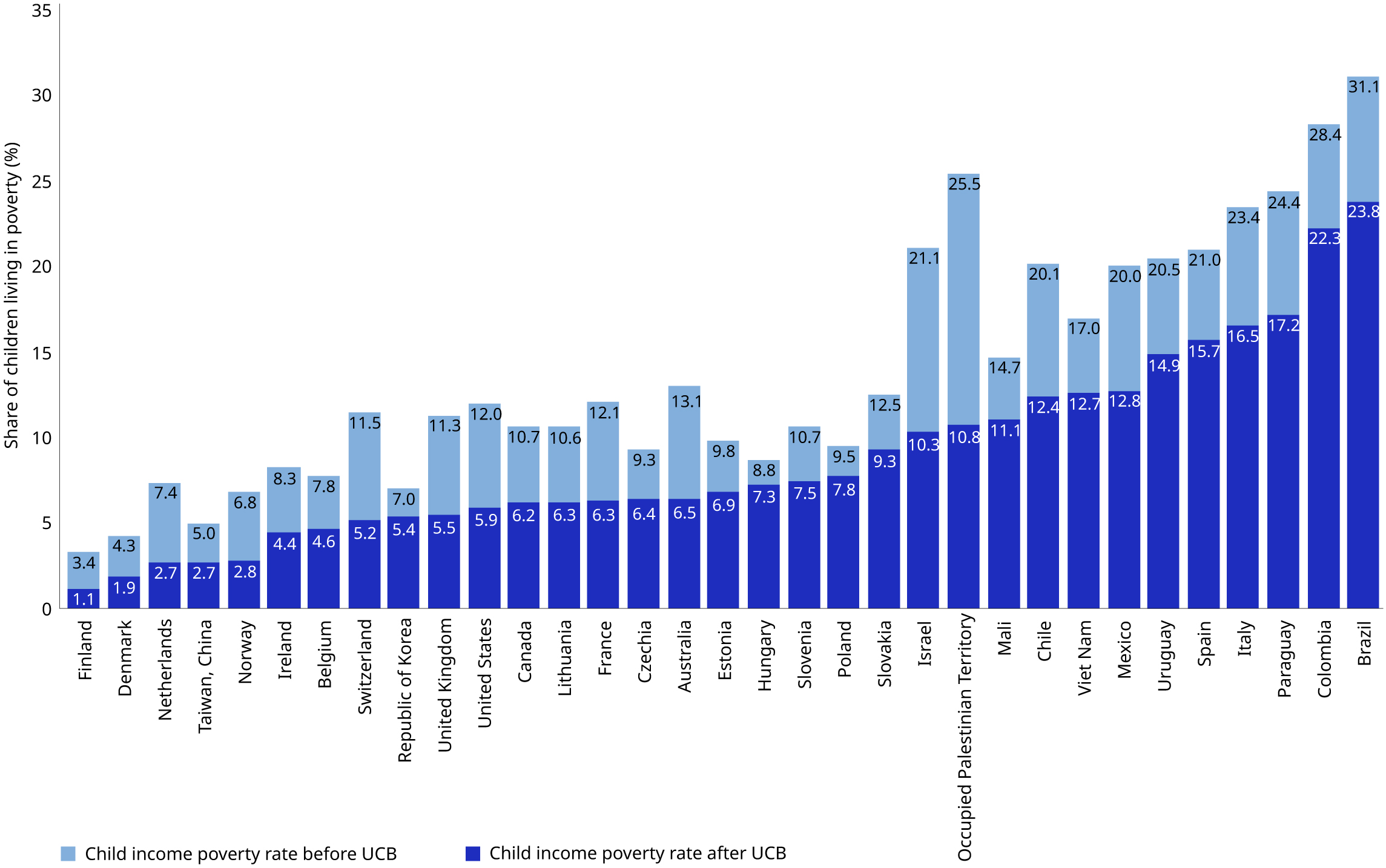
Notes: Relative child income poverty rates are calculated as the proportion of children living in households on incomes of less than 60 per cent of the median household income in the population. Household incomes are adjusted for comparison using the square root of the household size. These estimates are calculated on the assumption that all households take up the benefit.
Source: ILO estimates based on the LIS Database(multiple countries).
Figure 4.2 introduces a simulation of the effects of universal child benefits on child poverty in 33 countries and territories. The simulated estimates are calculated based on both the design of the policy (the delivery of a flat cash transfer for all children aged 0 to 18) and a benefit amount equivalent to the average payment per child per month in the 29 countries worldwide that presently provide universal child benefits (6 per cent of the average wage). The combined light and dark blue bars show relative child income poverty without a universal child benefit (and include the effects of any existing child social protection policies in place). The dark blue bars represent the relative child income poverty rate with a simulated universal child benefit policy (replacing payments for any existing child benefits). The light blue bars represent the decrease in poverty that could be achieved by a universal child benefit.
The results show that, in every country, a universal child benefit could reduce poverty more substantially than existing child policy efforts. The extent of the effect varies, with higher reductions in poverty in countries with higher pre-existing child poverty risks, and lower reductions in countries with pre-existing rates of around or below 10 per cent. Countries with universal child benefits already in place – such as the Nordic countries – have lower poverty rates overall; yet, increases in adequacy will improve anti-poverty effects overall.
On average across these countries, universal child benefits could reduce poverty by 5 percentage points, equivalent to a reduction of 39 per cent in the number of children experiencing poverty. In recent years, several countries have adopted universal child benefits, and many more are exploring the option (see table 4.1). Evidence would suggest that universal child benefits are a simple and effective way to address the dual challenge of maximizing social protection coverage for children, while addressing the persistent challenge of child income poverty risks.
4.1.3 The state of effective coverage for children
Current data on effective coverage indicate that only 23.9 per cent of children aged 0 to 18 are covered (see figure 4.3).3 This means the vast majority of children – 1.8 billion under 18 years old – are not covered. And fewer than one in ten (7.6 per cent) in low-income countries receive a child or family cash benefits, leaving millions vulnerable to missed education, poor nutrition, poverty and inequality, and exposing them to long -lasting impacts.
The proceeding trend data on effective coverage discussed below is currently available only for children aged 0 to 15. This data shows that, since the adoption of the SDGs in 2015, there has been a modest global increase in child benefit coverage, from 22.1 per cent in 2015 to 28.2 per cent in 2023.
Significant regional disparities continue to exist (figures 4.3 and 4.4). Effective coverage rates vary greatly across regions, and the same is true for improvements in coverage since 2015. In the Arab States, rates increased from 12.3 per cent to 14.2 per cent. In Europe and Central Asia, coverage has increased slightly from 74.4 per cent to 76.6 per cent. The Americas saw a more marked improvement, with rates increasing from 49.6 per cent to 54.9 per cent. In Africa, coverage has increased, from 9.2 per cent to 15.4 per cent. Asia and the Pacific experienced the largest increase from 14.3 per cent to 22.4 per cent. However, this progress should not detract from the fact that Africa and Asia and the Pacific still have enormous absolute numbers of children – 492.8 and 764.8 million, respectively – who remain uncovered.
In low-income countries, rates have increased from 4.5 per cent in 2015 to 8.7 per cent in 2023. While progress has happened, it is too slow and remains woefully insufficient. Low-income countries continue to be affected by protracted humanitarian crises and are on the front line of climate breakdown, locking children in a perpetual cycle of poverty. For the same period, lower-middle-income and upper-middle-income countries have made much more substantial progress, with coverage increasing from 15.0 per cent to 23.5 per cent and from 21.8 per cent to 27.8 per cent, respectively. High-income countries continue to edge closer to attaining universal coverage, with rates increasing from 76.8 to 80.5, yet still leaving one in five children uncovered.
The children least covered are those most susceptible to climate risks. Analysis shows that coverage rates for children in countries highly vulnerable to climate change are a third lower than those in countries not classified as being at high risk (ILO, Save the Children and UNICEF 2024).
Figure 4.5 by quadrant shows that all but one of the low-income countries experience high climate risk and low social protection coverage (top left). The majority of lower-middle-income countries are also found in this area. This patterning highlights a double concern for child poverty and inequality, both within and between countries, as social protection is least available in parts of the world where it is most needed.
Figure 4.3 SDG indicator 1.3.1 on effective coverage for children and families: Share of children receiving child or family cash benefits, aged 0 to 15 (2015 and 2023) and aged 0 to 18 (2023), by region, subregion and income level (percentage)
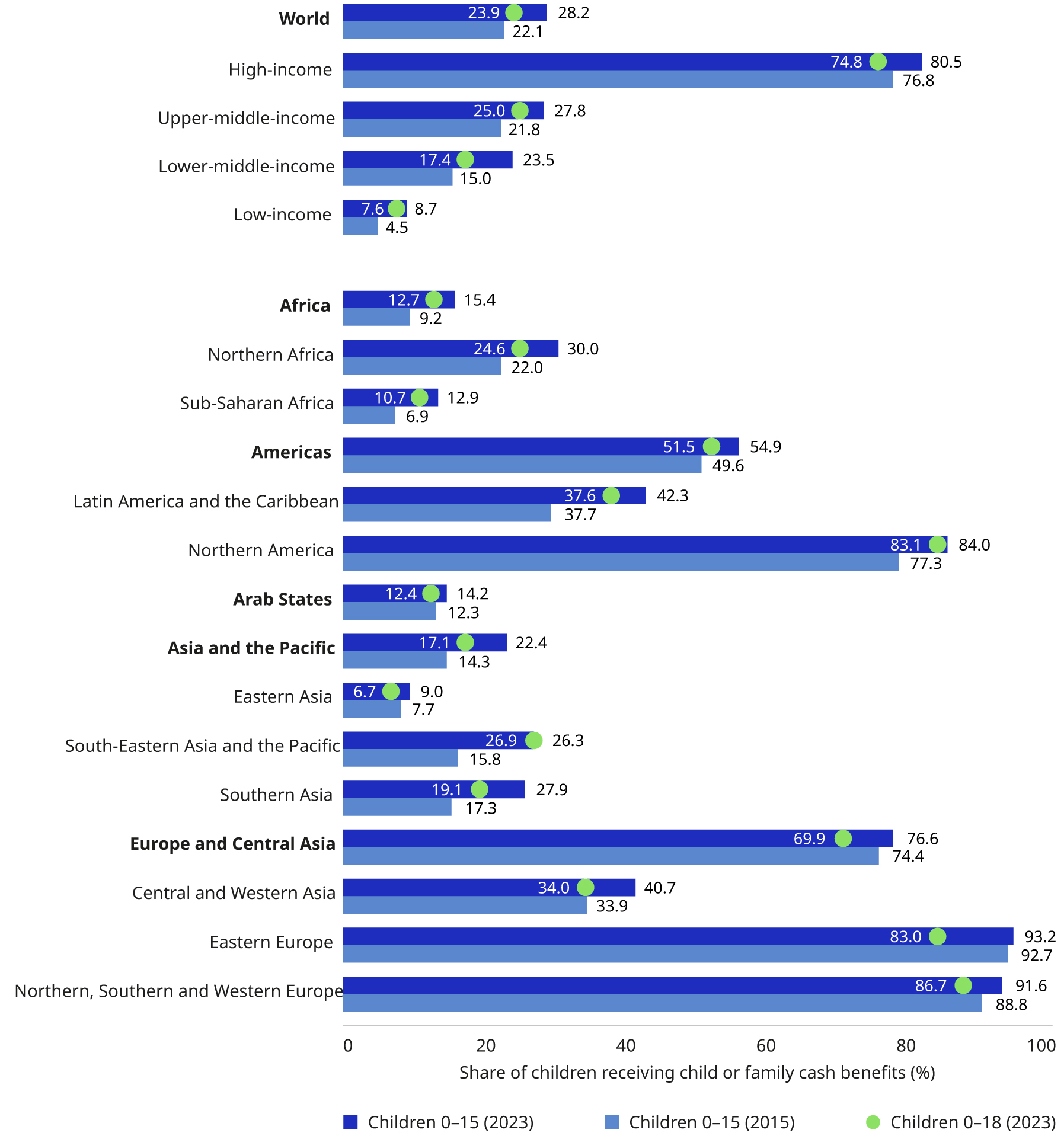
Notes: See Annex 2 for a methodological explanation. Data for coverage of children aged 0 to 18 is available for 2023 only. Global and regional aggregates are weighted by population aged 0 to 15 and 0 to 18. Estimates are not strictly comparable to the previous World Social Protection Report due to methodological enhancements, extended data availability and country revisions.
Sources: ILO modelled estimates, 2024; World Social Protection Database, based on the Social Security Inquiry; ISSA Social Security Programs Throughout the World; ILOSTAT; national sources.
Figure 4.4 SDG indicator 1.3.1 on effective coverage for children and families: Share of children aged 0 to 15 receiving child and family cash benefits, 2023 or latest available year (percentage)
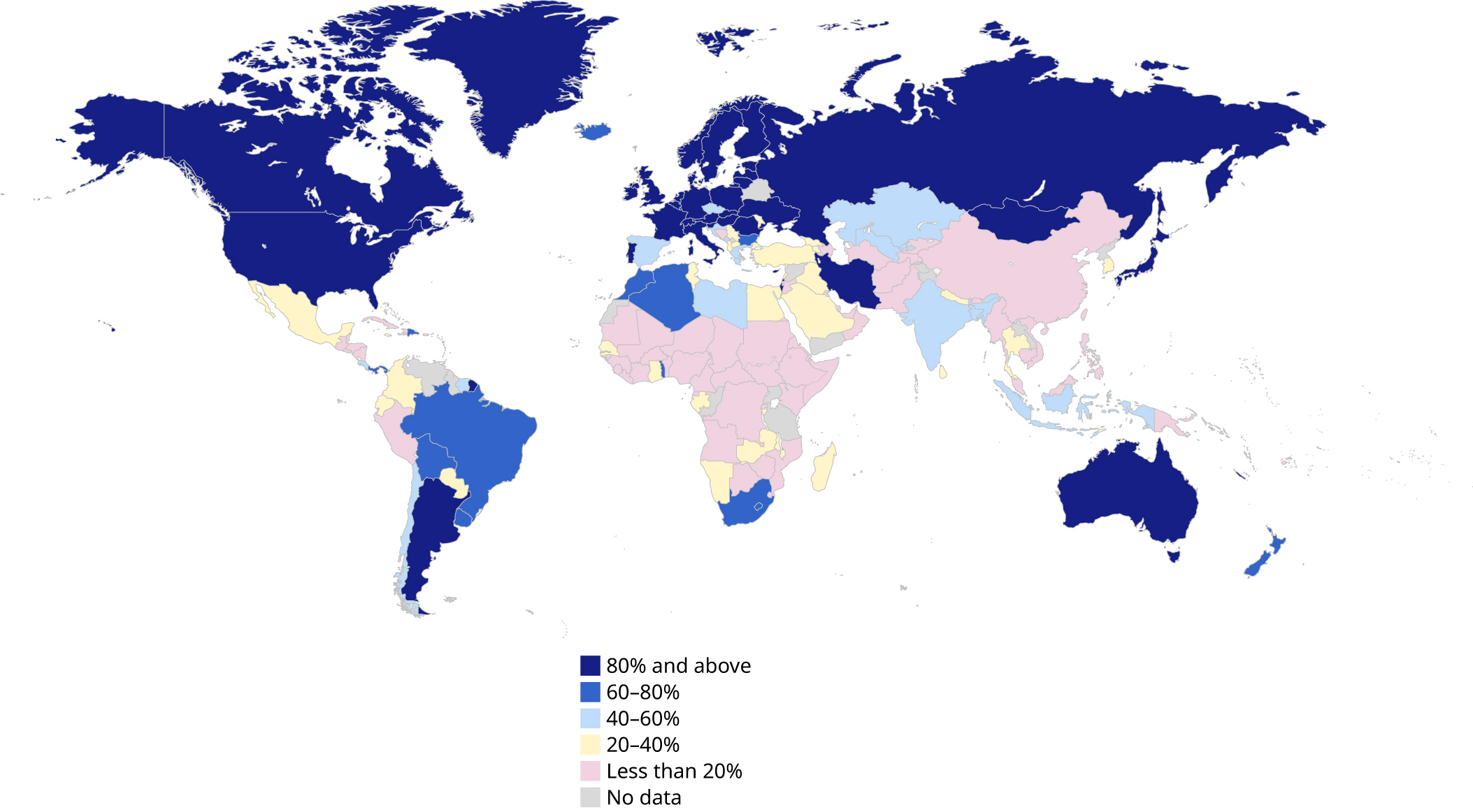
Disclaimer: Boundaries shown do not imply endorsement or acceptance by the ILO. See full ILO disclaimer.
Sources: ILO modelled estimates; World Social Protection Database, based on the Social Security Inquiry; ISSA Social Security Programs Throughout the World; ILOSTAT; national sources.
Figure 4.5 The Children’s Climate Risk Index compared with effective coverage for children and families: Share of children aged 0 to 15 receiving child or family cash benefits, by income level, 2023 (percentage)
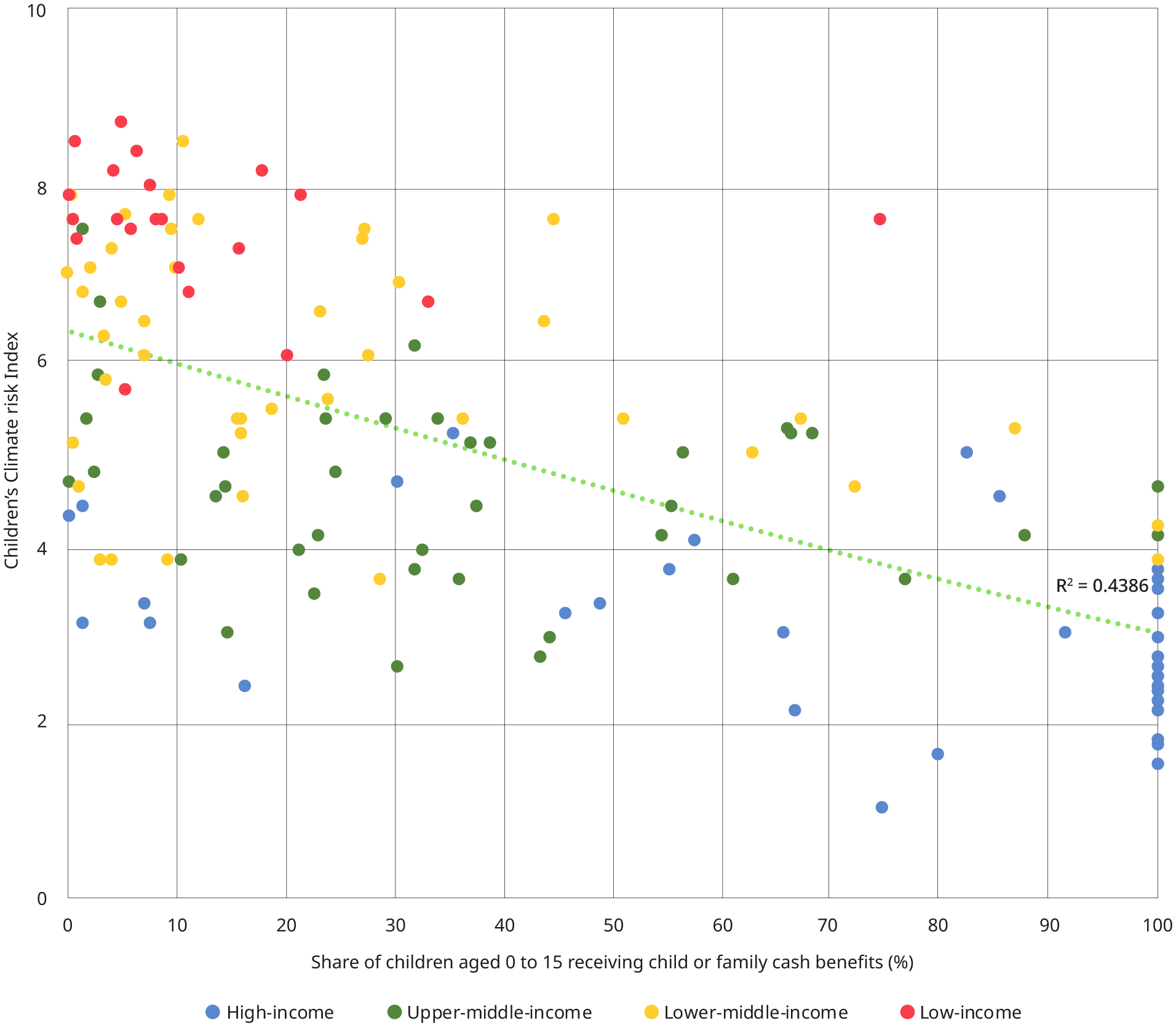
Source: Children’s Climate Risk Index, UNICEF (2023b) and ILO estimates, World Social Protection Database, based on the Social Security Inquiry; ILOSTAT; national sources.
4.1.4 Adequacy of social protection for children
Benefits should be enough to meet the stated goals of schemes (such as contributing to child-raising costs and nutrition goals). They should also be enough to meet the goals of the international social security standards – which stress the importance of adequacy – and their key principles which should inform the design and implementation of every social protection benefit, including regular indexation. Even when countries meet this specified minimum, where fiscal space permits, they should consider higher levels of expenditure on children – Convention No. 102 sets a minimum floor, not a ceiling. The ILO’s Committee of Experts on the Application of Conventions and Recommendations has also recently stressed the importance of more appropriate benchmarks, as benefit levels remain too low in many countries (ILO 2023d). This might imply the need for a higher international social security standard for the branch of family and child benefits.
Figure 4.6 Impact evidence of how child poverty and vulnerability risks are addressed through the nine life-cycle social protection functions
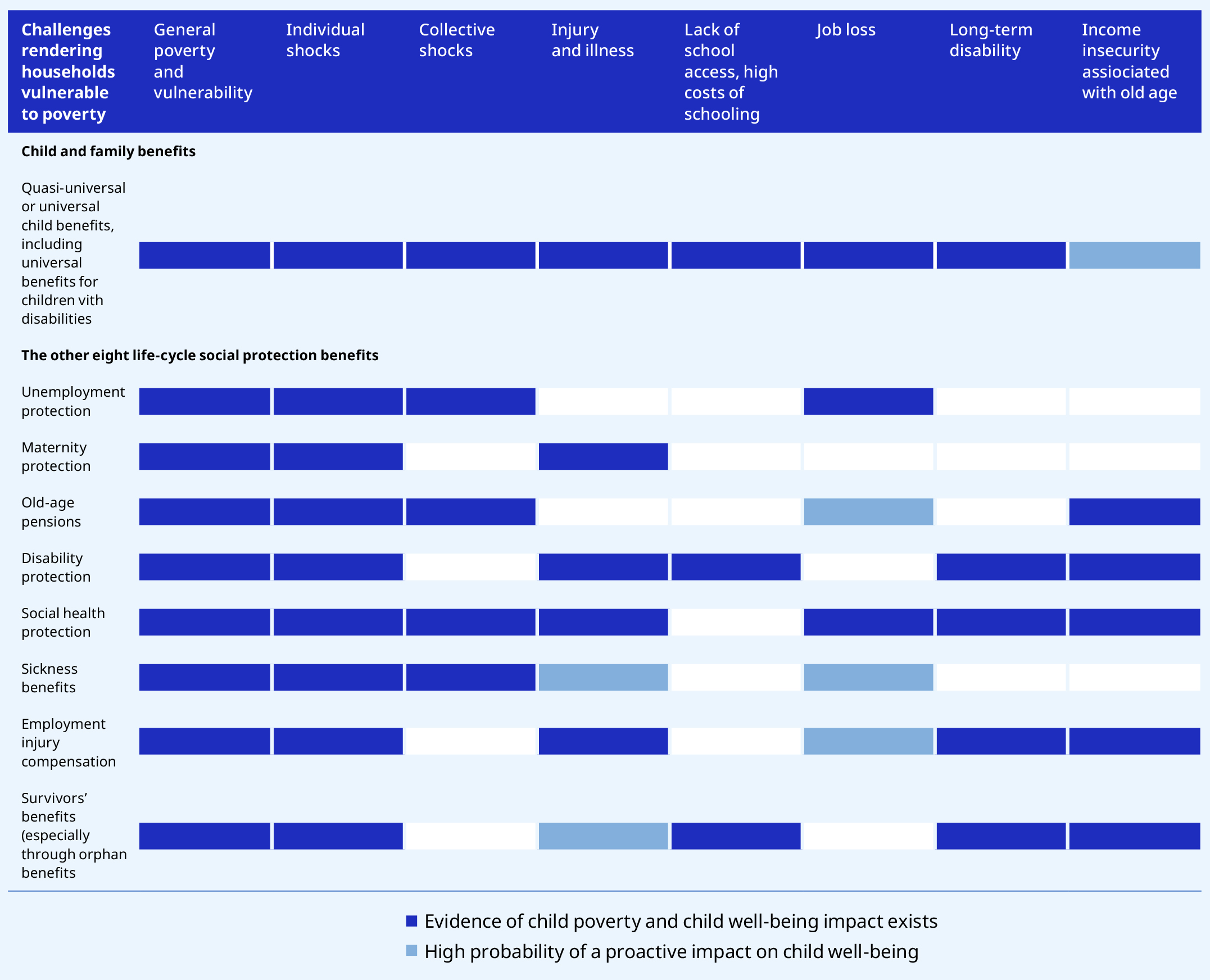
Note: Authors’ interpretation of findings from the sources cited below.
Sources: ILO (2011b); Bastagli et al. (2016); Davis et al. (2016); ODI and UNICEF (2020) 2020; Richardson (2015); Standing and Orton (2018).
Adequacy also requires countries to ensure that benefits are set at the right level for diverse family circumstances, taking into account age, family size, family structure and location, and are regularly updated to keep up with changes in the cost of living. Increments based on disability, gender, ethnicity and other proxies for high vulnerability may warrant consideration in contexts of systemic discrimination or disadvantage (see ILO, UNICEF and Learning for Well-Being Institute 2024).
Adequacy does not refer only to the value at which child and family benefits are set. It also refers to the adequacy of other benefits which can also positively impact child well-being (figure 4.6). Where there is a comprehensive range of adequate life-cycle protection for other groups, such as those of working age and pensioners in households with children, this also protects child well-being.
4.1.5 Filling the financial gap in social protection for children
Figure 4.7 Public social protection expenditure (excluding health) on children (percentage of GDP) and share of children aged 0 to 15 in total population (percentage), by region, subregion and income level, 2023 or latest available year
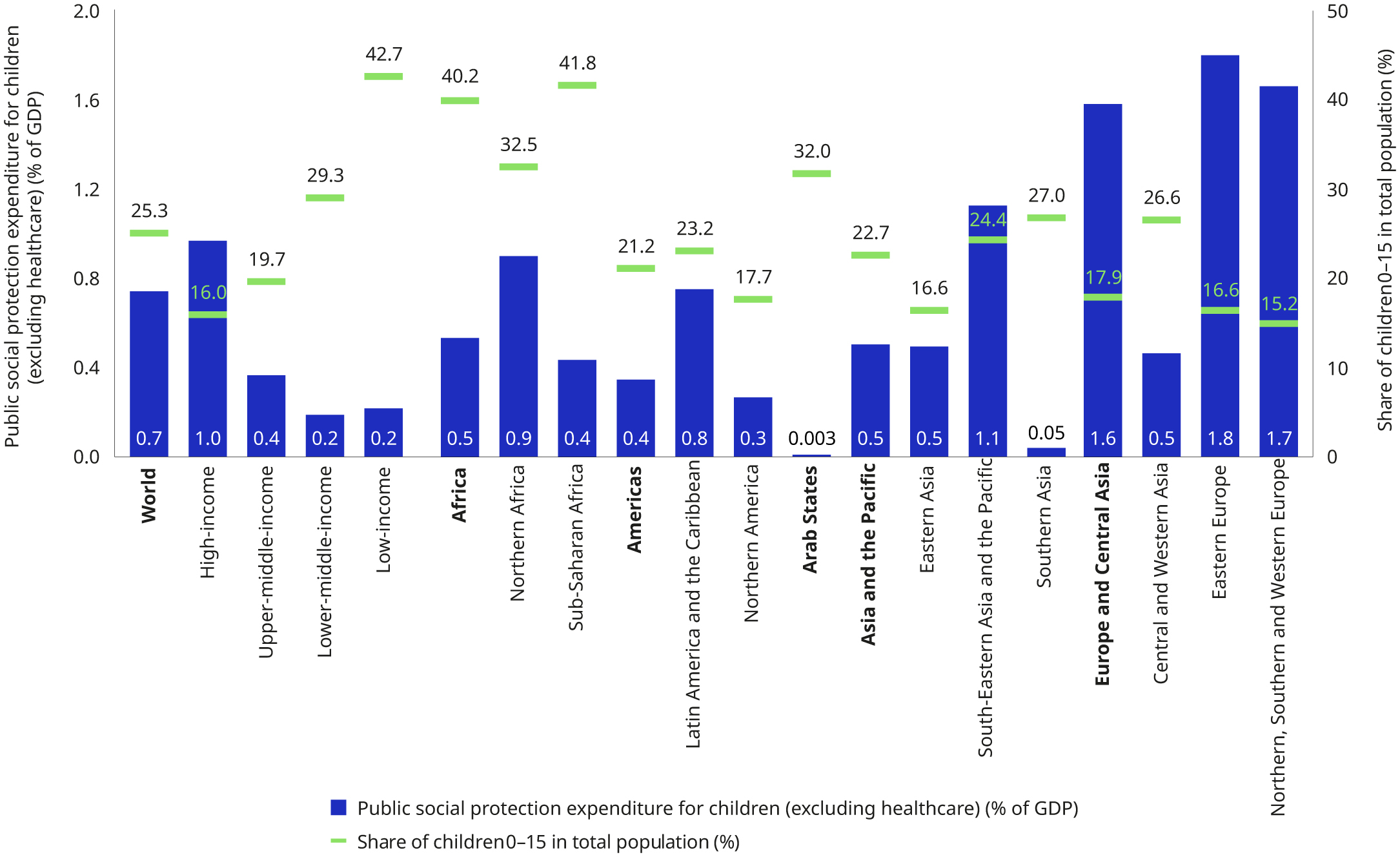
Notes: See Annex 2 for a methodological explanation. Global and regional aggregates for expenditure are weighted by GDP.
Sources: ILO modelled estimates; World Social Protection Database, based on the Social Security Inquiry; ADB, GSW, IMF; OECD; UNECLAC; UNWPP, national sources.
Ensuring adequate social protection requires sufficient resources to be allocated for children and families. Yet, average social protection expenditure for children (excluding health expenditure) across the world currently amounts to only 0.7 per cent of GDP (figure 4.7), with great variation across countries. While countries in Europe and Central Asia spend more than 1 per cent of GDP, expenditure ratios remain well below that threshold in other parts of the world. Regional estimates for Africa, Asia and the Pacific, and the Americas show expenditure levels of 0.5 per cent of GDP or below. An average expenditure level of only 0.2 per cent and 0.4 per cent of GDP in low-and upper-middle-income countries, respectively, lags behind the expenditure of 1.0 per cent of GDP in high-income countries.
Climate action to ensure social justice for children requires more equitable intergenerational expenditure and the filling of the financing gap. Currently, too little is spent on social protection. And too little of this expenditure is devoted to children, especially in the early years (ILO and UNICEF 2023). Globally, out of the total social protection expenditure, only 3.8 per cent is spent on children, contrasting with 33.0 per cent on healthcare, 38.7 per cent on pensions, and 24.6 per cent on working-age benefits. While children are indirectly protected by the benefits received by adult household members, this expenditure distribution is still hugely disproportionate and insufficiently focused on children.
The big challenge for closing protection coverage gaps for children lies in filling the social protection finance gap. To guarantee at least a basic level of social security for all children, lower-middle-income countries would need to invest an additional US$88.8 billion and upper-middle-income countries a further US$98.1 billion per year – equivalent to 1 and 0.3 per cent of GDP, respectively. Low-income countries would need to invest an additional US$59.6 billion, equivalent to 10.1 per cent of their GDP (Cattaneo et al. 2024). Options for expanding fiscal space are discussed in section 3.4.
There is also an opportunity to fill the financing gap and explore how climate financing can be leveraged for social protection. Given that children bear the brunt of the climate crises, despite contributing the least, and recognizing the role that social protection can play in climate action, climate financing could be considered to help fill the financing gap and contribute to closing coverage gaps. While several sources of climate finance can be considered – international public climate finance, international private investment, national and international carbon markets or domestic finance – international climate finance should not eat into the finance available for addressing development and humanitarian needs. Analysis indicates that, since 2018, more than half of the climate finance mobilized by developed countries was not additional to existing development assistance (Mitchell, Ritchie and Tahmasebi 2021).
4.1.6 Priorities, and recommendations
To respond to children’s ordinary life course needs, the climate crisis and a just transition towards environmentally sustainable economies and societies, social protection will be more crucial than ever. This requires:
-
Accelerating progress towards universal coverage and progressively covering all children . Almost all countries can improve their child benefit provision and there are different ways to achieve universal coverage. Countries can progressively realize their child benefit, introduce an age-limited benefit (for example, 0–2 years) and build gradually towards a more inclusive child benefit – ideally, a full universal child benefit for children between 0 and 18 years, and beyond. The recently launched Child Benefits Tracker4 provides an online platform to monitor children’s access to benefits and advocate for closing protection gaps.
-
Guaranteeing adequate benefit levels. For coverage to be transformative, it must deliver benefits set at values high enough to generate meaningful change in children’s lives and well-being. Providing increments for critical life course stages, such as the first two years of life, would be prudent.
-
Providing a comprehensive range of benefits . While social protection instruments directed at families with children are critical for ensuring children’s well-being, the evidence also points to the clear role of other social protection instruments across the life cycle. The combined power of life cycle protection leads to a stronger reduction of the drivers of diminished well-being through a system-wide approach.
-
Building social protection systems that are rights-based, gender-responsive and inclusive . Ensuring the well-being of children and addressing the conditions that adversely affect them require robust social protection systems and schemes. These need to be (a) anchored in law, rights-based and inclusive in all dimensions – including, but not limited to, gender, disability, migratory status, race and ethnicity – and (b) well coordinated with social services, care and family-friendly policies, and decent work opportunities for parents and caregivers.
-
Ensuring that social protection systems are linked with broader care and support services and decent work policies . Adequate social protection across the life cycle – together with childcare and education, and decent work for parents and other caregivers – is critical for the well-being of children. This also means extending social protection to workers in the informal economy and protection for workers in all types of employment.
-
Enhancing shock responsiveness is crucial for protecting children in a world riven by climate breakdown and other crises . Having in place comprehensive systems can enable countries to respond quickly; if necessary, align a humanitarian response with the national system-strengthening agenda; and address ordinary life-cycle challenges. Significant effort is therefore also needed to ensure that social protection systems and schemes are prepared before crises strike, while also channelling a rapid and effective response to shocks, to avert or lessen adverse child well-being impacts.
-
Ensuring sustainable and equitable financing for social protection systems. Mobilizing additional investment for social protection is key – tapping into loss and damage finance may be an option. It would compensate children for the climate threat they face and the fossil fuel excess of previous generations. It would also enable them to invest in the formation of capabilities required by a greener economy. Investment now would represent an act of intergenerational solidarity, and restorative and redistributive social justice, and would protect the rights of children yet to come.
.4.2 Social protection for women and men of working age
Key messages
-
A just transition to environmentally sustainable economies and societies requires adequate social protection for persons of working age to reduce their vulnerability, and support them in coping with shocks and slow-onset events, and in achieving their labour market transitions.
-
Yet, in many countries, persons of working age still face significant coverage gaps when it comes to life-cycle risks, such as sickness, maternity, disability, work injury, unemployment or death of a breadwinner. A lack of income security increases people’s vulnerability and erodes their capacities to adapt to changing conditions, including climate risks.
-
Social protection coverage is an essential element of decent work, and indispensable for people who are not able to work temporarily or permanently. Indeed, social protection coverage protects and promotes their capabilities, prevents poverty, enables them to navigate change and contributes to an inclusive recovery from crises.
-
Globally, 4.8 per cent of GDP is allocated to non-health public social protection expenditure for people of working age. While high-income countries allocate 6.3 per cent of their GDP to income security for people of working age, low-income countries can allocate only 0.4 per cent, leading to significant social protection gaps for their workers. Regional variation in social protection expenditure is large, ranging from 1.4 per cent of GDP in the Arab States to 7.1 per cent in the Americas.
-
Many countries still lack collectively financed social security benefit schemes that ensure income security in the event of maternity, sickness, unemployment and employment injury. Where the only available mechanisms are based on employer liability or private arrangements, results are often suboptimal in terms of coverage, equity and sustainability. Introducing mechanisms that are collectively financed through social insurance and/or general taxation can provide for wider coverage and more reliable benefits.
-
Effective coordination between social protection policies and employment, labour market, wage and tax policies is of critical importance to ensure an inclusive and job-rich recovery from crises.
4.2.1 Introduction: Making income security a reality
The ongoing transformations of economies and societies, whether related to the climate crisis, technological innovations or demographic change, require adequate social protection during working age. Adequate social protection is a key tool to reduce vulnerability and enhance resilience to enable people, societies and economies to adapt to change.
While gainful employment is the main source of income for people of working age, social protection has an important enabling role. It enables people to engage in decent and productive employment, protects and promotes their capabilities, facilitates a healthy balance between work and family responsibilities, and ensures a dignified life. According to the latest ILO modelled estimates, 60.5 per cent of people aged 15 and above are economically active and earn their livelihoods through income-generating activities; 72.9 per cent of men and 48.2 per cent of women (ILO 2024k). Yet, many find themselves in precarious and insecure employment arrangements, including in the informal economy, with limited job and income security and in poor working conditions (ILO 2023w). Globally, more than 2 billion people are in informal employment,5 representing 57.8 per cent of the workforce – 55.2 per cent of women and 59.6 per cent of men (ILO 2023w). Moreover, 241 million people are in extreme working poverty, that is, they live in extreme poverty despite being in employment (ILO 2023w). Another significant share of the global population, most of whom are women, perform unpaid care and household work, often in addition to paid work (ILO 2024a). All these persons of working age need social protection, whether in paid employment or not, whether working as employees or as self-employed, whether looking for a job, being temporarily or permanently incapable of working, or in education (ILO 2021m).
By partially or fully replacing lost incomes and providing income support to those affected, social protection systems have proven to be key in protecting and promoting human capabilities, smoothing incomes over people’s lives and stabilizing aggregate demand (ILO 2021o; 2020h; 2020k; 2020e). This includes income security6 in the event of maternity, sickness, work injury, disability, unemployment or death of the breadwinner (ILO 2021q; UN 2020), and helps people to find and sustain decent and productive employment. Social protection also facilitates effective access to healthcare and other services. Furthermore, it contributes to healthier lives by enhancing the social determinants of health (WHO, forthcoming, see also section 4.4) and to decent work in the care economy (ILO 2024a). Social protection systems are essential for protecting and promoting human capabilities, smoothing incomes over people’s lives and stabilizing aggregate demand (ILO 2021o; 2020h; 2020k; 2020e).
While some countries have heeded the lessons from the COVID-19 pandemic and other crises and invested in reinforcing their social protection systems, much more needs to be done to ensure that people of working age can enjoy the full protection that they need to:
-
engage in decent and productive employment,
-
benefit from income security also in times when they are not able to work temporarily or permanently, and
-
balance their work and family responsibilities.
Figure 4.8 Public social protection expenditure (excluding health) on working-age population (percentage of GDP) and share of population aged between 15 and 64 in total population (percentage), by region, subregion and income level, 2023 or latest available year
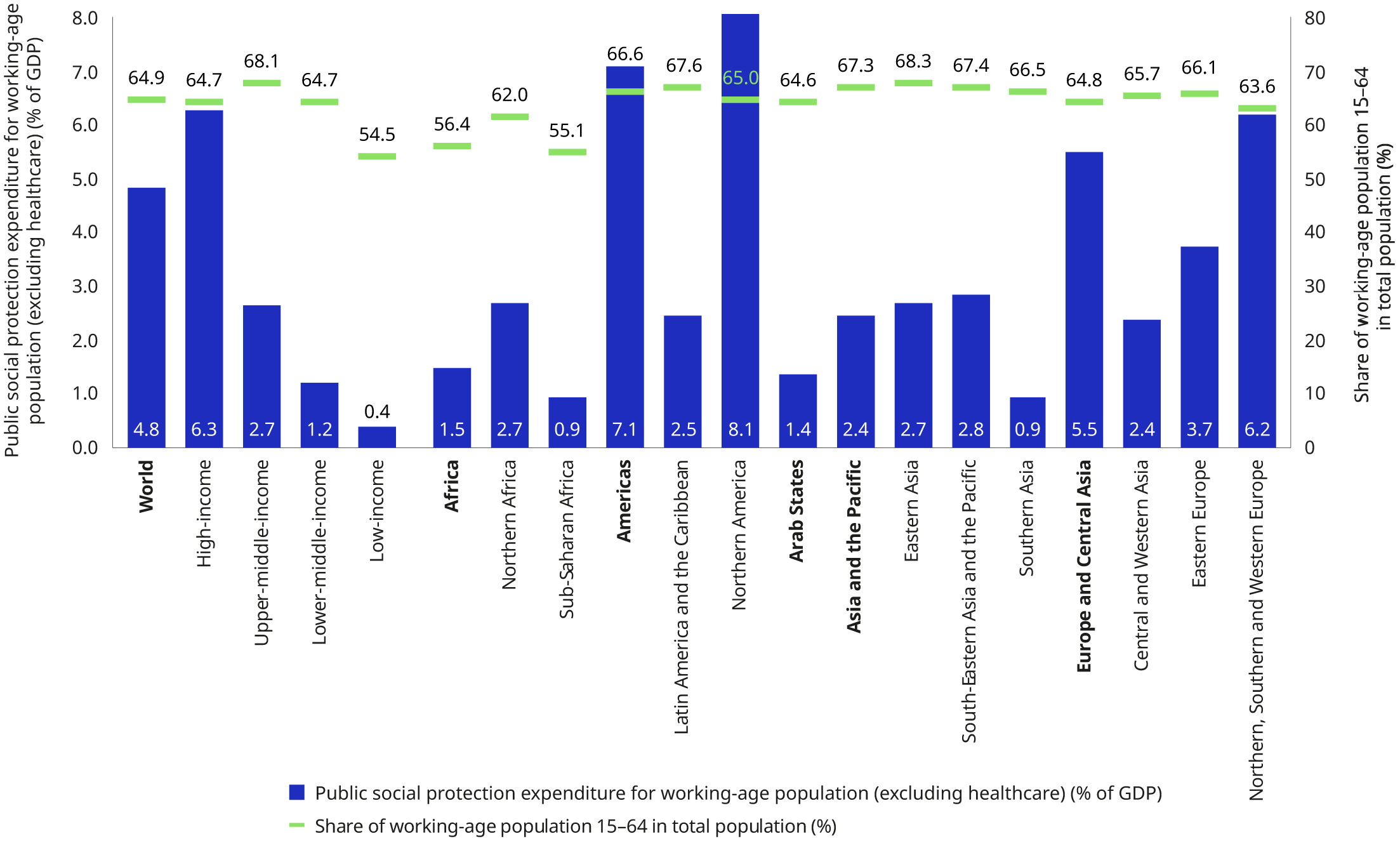
Note: See Annex 2 for a methodological explanation. Public social protection expenditure for working-age population (excluding healthcare) global and regional aggregates are weighted by GDP.
Sources: ILO estimates, World Social Protection Database, based on the Social Security Inquiry; ADB, GSW, IMF; OECD; UNECLAC; UNWPP, national sources.
Large coverage gaps are associated with significant underinvestment in social protection for people of working age, including maternity benefits, unemployment benefits, employment injury benefits, disability benefits, survivor benefits and general social assistance, but excluding healthcare (covered in section 4.4). Globally, countries allocate on average 4.8 per cent of their GDP to non-health social expenditure for persons of working age (see figure 4.8), ranging from 6.3 per cent of GDP in high-income countries, to only 0.4 per cent in low-income countries. Regional variations are also significant, ranging from 1.4 per cent of GDP in the Arab States, 1.5 per cent in Africa and 2.4 per cent in Asia and the Pacific, to 5.5 per cent in Europe and Central Asia, and 7.1 per cent in the Americas. The comparison with the share of the working-age population in the total population demonstrates that demographic factors can only explain part of the regional variation and the relative underdevelopment of social protection programmes for persons of working age.
While social protection plays an essential role in ensuring income security, it is clear that income security cannot be achieved by social protection systems alone. To promote decent work, social protection policies need to be well coordinated with policies in other areas, particularly labour market and employment policies (including active labour market policies), employment protection, occupational safety and health, wages (including minimum wages) and collective bargaining. Social protection policies would also benefit from being aligned with policies that support the formalization of enterprises and employment, policies to support workers with family and care responsibilities and policies to promote gender equality in employment.7 Such an integrated approach is essential for achieving the SDGs and ensuring decent work and social justice for all.
The remainder of this section of Chapter 4 is divided into five subsections, dealing in turn with the areas of social security that are most relevant to people of working age, namely:
-
maternity protection, paternity and parental leave benefits (section 4.2.2);
-
sickness benefits (section 4.2.3);
-
employment injury protection (section 4.2.4);
-
disability benefits (section 4.2.5); and
-
unemployment protection (section 4.2.6).
Each of these subsections discuss both contributory and non-contributory schemes, which together ensure universal coverage with adequate benefits, based on sustainable and equitable financing mechanisms. Although the primary focus is on cash benefits, the discussion will also take into account that benefits in kind – in particular healthcare, care and other social services8 (Martínez Franzoni and Sánchez-Ancochea 2015) – play a major role in ensuring income security for people of working age. Access to healthcare is discussed in more detail in section 4.4. Together, these schemes contribute to building national social protection systems, including floors.
4.2.2 Maternity protection, paternity and parental leave benefits
Key messages
-
Exposure to climate change hazards, such as extreme heat, weather events and air pollution, has consequences for maternal and neonatal morbidity and mortality, including gestational diabetes, hypertensive disorders of pregnancy, preterm birth, low birth weight and stillbirth but also exposure to vector-borne diseases. These impacts have implications for maternity protection, leading to increased demands on health and maternity care systems. Yet, inequalities in access to reproductive, maternal, newborn and child health persist, with significant differences within and between countries, depending on income, education level and place of residence.
-
Maternity benefits and maternity care provision are crucial to ensure that women in their final stages of pregnancy and after childbirth are not forced to keep working and do not expose themselves and their children to significant health risks. Such benefits directly support income security, therefore addressing some of the key social determinants of poor maternal and child health and early childhood development.
-
Only slightly more than a third (36.4 per cent) of women with newborns worldwide received a maternity cash benefit in 2023, a slight increase compared to 29.6 per cent in 2015. Coverage varies significantly across regions and income levels: coverage of childbearing women is close to universal in most of Europe, compared to a mere 2.6 per cent in low-income countries and 5.9 per cent in sub-Saharan Africa. Similarly, free maternity care is not universally available.
-
Maternity protection includes income security (through cash benefits), leave policies and effective access to free quality maternal and newborn healthcare services. In addition, employment and labour market interventions – such as employment protection and non-discrimination, childcare solutions after return to work, adequate occupational health and safety measures and breastfeeding facilities at the workplace – are important to give adequate protection to pregnant women and new mothers.
-
Adequate provision for paid paternity leave is an important corollary to maternity protection policies and contributes to a more equal sharing of family responsibilities and other unpaid care work. In 2021, 115 out of 185 countries surveyed by the ILO offered a right to paid paternity leave, with an average duration of nine days.
The importance of increased maternity protection in a changing climate
Maternity protection is crucial for preventing and alleviating poverty and vulnerability, enhancing the health, nutrition and overall well-being of mothers and newborns, fostering gender equality and promoting a dignified life for all from the very start. It encompasses provisions such as income support, access to maternal healthcare, paid maternity leave, time to breastfeed, safeguards against discrimination in employment, parental leave, right to return to work and childcare options upon returning to work. While these are mainly labour protection measures, this section focuses on maternity protection measures pertaining to social protection, that is, maternity cash benefits and free maternity care. Social protection systems are essential for minimizing the adverse impacts of the climate crisis on pregnant and childbearing women and their children.
As a fundamental element of maternity protection and social health protection, good maternal healthcare without hardship provides for effective access to adequate healthcare and services – including reproductive health services – during pregnancy and childbirth and beyond, lifting financial barriers to ensure the health of both mothers and children. As with social health protection in general (see section 4.4), a lack of coverage puts the health of women and children at risk and exposes families to significantly increased risk of poverty, and can act as an incentive to forgo care.
Climate change affects pregnant women directly and indirectly, in the long and short term, and can be caused by sudden- as well as slow-onset events. The threat of the climate crisis to livelihoods, particularly among vulnerable populations (see section 2.1), impacts the social determinants of health and increases the health risks of pregnant women related to income insecurity, poor nutrition, water, hygiene, sanitation and access to health services. Forced migration and displacement due to lost livelihoods or environmental shocks and disasters adversely impact the health of all members of affected communities (Chapter 2), but can be most life threatening for pregnant women, new mothers and newborns who are in critical need of adequate nutrition, access to healthcare, and sufficient rest. A large body of studies shows that the exposure to climate change hazards such as extreme heat, adverse weather events and air pollution have consequences for maternal and neonatal morbidity and mortality (including gestational diabetes, hypertensive disorders of pregnancy, preterm birth, low birth weight and stillbirth) but also exposure to vector-borne diseases. Both direct and indirect exposure to climate hazards can also affect mental health, increasing risk for stress, anxiety and depression – known risk factors for adverse perinatal outcomes (WHO, UNICEF and UNFPA 2023a). Women in the informal economy are particularly vulnerable to the risks of income insecurity and ill health because of discrimination, unsafe and insecure working conditions, lack of employment protection, often low and volatile incomes, limited freedom of association, lack of representation in collective bargaining processes and lack of access to social insurance (ILO 2016a).
In light of these increased risks, providing adequate maternity protection is paramount. Yet, evidence points to significant gaps in coverage, adequacy, comprehensiveness and financing for benefits and services to which pregnant women and their newborns should have access.
A comprehensive approach to maternity protection
According to international labour standards (see box 4.4), maternity protection includes not only income security and access to free maternal healthcare, but also the right to interrupt work activities, to rest and to recover around childbirth. It ensures the protection of women’s right to work and rights at work during maternity and beyond, through measures that prevent risks, protect pregnant women from unhealthy and unsafe working conditions and environments, safeguard their employment, protect them against discrimination and dismissal, and allow them to return to their jobs after maternity leave under conditions that take into account their specific circumstances, including the need for breastfeeding (Addati, Cattaneo and Pozzan 2022). From the perspective of equality of opportunity for and treatment of women and men, maternity protection takes into account the particular circumstances and needs of women, enabling them to enjoy their economic rights while raising their families (ILO 2014b; 2018e). For example, maternity protection starts even before conception, with the ability of women to freely determine the number of children they want to have, and the intervals at which they have them, through access to affordable and good-quality sexual and reproductive rights and services (Folbre 2021). In the absence of such services, women carry the social, economic and health consequences of unwanted pregnancies or unsafe abortions, which are especially severe in the case of adolescent mothers.
Maternity protection can also counteract the “motherhood penalty”, that is, the disadvantages faced by mothers of young children compared to fathers or to women without children. Mothers are less likely to be employed, receive lower wages and are less likely to work in managerial or leadership positions than women without children, fathers and men without children.
Box 4.4 International standards relevant to maternity protection
|
Women’s right to maternity protection is enshrined in the Universal Declaration of Human Rights (1948), which sets out the right to social security and special care and assistance for motherhood and childhood. The International Covenant on Economic, Social and Cultural Rights (1966) establishes the right of mothers to special protection during a reasonable period before and after childbirth, including prenatal and postnatal healthcare and paid leave or leave with adequate social security benefits. The Convention on the Elimination of All Forms of Discrimination against Women (1979) recommends that special measures be taken to ensure maternity protection, proclaimed as an essential right permeating all areas of the Convention. Since the adoption by the ILO of the Maternity Protection Convention, 1919 (No. 3), in the very year of its foundation, a number of more progressive instruments have been adopted, in line with the steady increase in women’s participation in the labour market in most countries worldwide. The Social Security (Minimum Standards) Convention, 1952 (No. 102), Part VIII, sets minimum standards as to the population coverage of maternity protection schemes, including cash benefits during maternity leave, to address the temporary suspension of earnings (see Annex 3, table A3.7). The Convention also defines the medical care that must be provided free of charge at all stages of maternity, to maintain, restore or improve women’s health and their ability to work. Further, it provides that free maternal healthcare must be available to women and the spouses of men covered by maternity protection schemes. The Maternity Protection Convention, 2000 (No. 183), and its accompanying Recommendation (No. 191), provide detailed guidance for national policymaking and action aiming to ensure that women:
In order to protect women’s rights in the labour market and ensure that maternity does not constitute a source of discrimination by employers, ILO maternity protection standards specifically require that cash benefits be provided through schemes based on solidarity and risk pooling, such as compulsory social insurance or public funds, while strictly limiting the potential liability of employers for the direct cost of benefits. Recommendation No. 202 calls for access to essential healthcare, including maternity care and basic income security, for people of working age who are unable to earn sufficient income owing to (among other factors) maternity. Cash benefits should be sufficient to allow women a life in dignity and without poverty. Maternal healthcare services should meet criteria of availability, accessibility, acceptability and quality (UN 2000a); they should be free and not create hardship or increase the risk of poverty for people in need of healthcare. Maternity benefits should be granted to all residents of a country. Reinforcing the objective of achieving universal protection, the Transition from the Informal to the Formal Economy Recommendation, 2015 (No. 204), calls for the extension of maternity protection to all workers in the informal economy. |
Access to reproductive, maternal, newborn and child healthcare
Effective access to appropriate prenatal and postnatal healthcare services without hardship for pregnant women and mothers with newborns is an essential component of maternity protection and social health protection alike. Making such services free helps lift the financial barriers of access to healthcare that may be particularly pronounced for women. It is important in order to improve maternal and child health, reduce maternal and child mortality, reach universal health coverage and achieve gender equality (SDG targets 3.1, 3.2, 3.8 and 5.6). Access to healthcare in general (SDG target 3.8) is discussed in detail in section 4.4.
This is all the more important, as many women suffer from pregnancy or childbirth complications. While the global maternal mortality ratio declined by 34 per cent between 2000 and 2020, 287,000 women (223 deaths per 100,000 live births) globally died from a maternal cause in 2020, equivalent to almost 800 maternal deaths every day, approximately one every two minutes. As many as 95 per cent of all maternal deaths occurred in low-and lower-middle-income countries (WHO, UNICEF and UNFPA 2023b).
Apart from access to free adequate health services, many socio-economic factors determine the health outcomes of pregnant women. These conditions are further impacted by climate change as maternal and newborn morbidity and mortality are expected to increase with an increased frequency of extreme weather events (Segal and Giudice 2022; Dodzi Nyadanu et al. 2024). The health impact of the climate crisis on pregnant women will increase demands on the health system. Therefore, it is important that health staff are trained to raise awareness of climate-related health risks for pregnant women. The needs of pregnant women should be integrated into climate-sensitive health policy planning to guarantee adequate access to essential sexual, reproductive, maternal, newborn and child health services. This will also require additional financing to meet current unmet needs and future increases in demand. However, trend analysis of the subindices of SDG target 3.8.1 on reproductive, maternal, newborn and child health (encompassing family planning, prenatal care, diphtheria tetanus toxoid and pertussis immunization, and acute respiratory infection care seeking) shows very slow progress in the availability of such services over the last two decades (period 2000–21) (WHO and World Bank 2023). The average annual changes have been below 1 per cent since 2000 and no changes have been observed since 2015. Furthermore, large inequalities between countries persist, with much better access to services in high-income countries while low-and lower-middle-income countries lag behind.
Similarly, inequalities within countries persist by economic status, education and place of residence (urban or rural). The analysis of a subset of 78–89 countries for which disaggregated data is available, shows that there is a striking social gradient in access to reproductive, maternal and child health services, with a difference of almost 15 percentage points between highest (median coverage of 73 per cent) and lowest quintiles (58 per cent) and an overall difference of 3–4 percentage points between each quintile. There are also inequalities between urban (70 per cent) and rural (63 per cent) populations and also between those without education (56 per cent) and secondary or higher education (71 per cent) (WHO and World Bank 2023). Patterns of inequality also prevail when considering intersectional discrimination. For example, women with disabilities are found to be regularly excluded from the provision of sexual and reproductive health services and face the additional risk of involuntary sterilization (UN 2019a). Particular efforts are therefore needed to ensure effective access for expecting women with disabilities, who face additional barriers in meeting their sexual and reproductive healthcare needs, including societal misperceptions and stereotypes around their sexuality, inaccessibility of services and/or information and fear of abuse.
A diversity of schemes providing maternity benefits
Globally, 157 out of 217 countries and territories have periodic maternity cash benefits anchored in national legislation, of which 142 have social insurance and 11 have tax-financed employment-related schemes (figure 4.9); 119 have social insurance as the only mechanism and 7 in combination with means-tested benefits; and 16 combine social insurance with employer liability. Four countries and territories have universal tax-financed maternity benefits, one of them in combination with employer liability. A total of 49 countries still only have employer liability mechanisms, which present challenges in terms of access and adequacy of protection.
The Maternity Protection Convention, 2000 (No. 183), recommends that countries introduce collectively financed maternity benefits (social insurance or tax-financed) rather than relying on employers’ liability provisions. This improves equality of treatment for men and women in the labour market because it shifts the burden of bearing the costs of maternity benefits from the individual employer to the collective, reducing discrimination against women of childbearing age in hiring and in employment, and the risk of non-payment of due compensation by the employer. Such reforms can also facilitate the coverage of women with low contributory capacities and interrupted employment histories, including those in part-time or temporary employment, and those in self-employment.
Figure 4.9 Maternity protection (cash benefits) anchored in law, by type of scheme, 2023 or latest available year
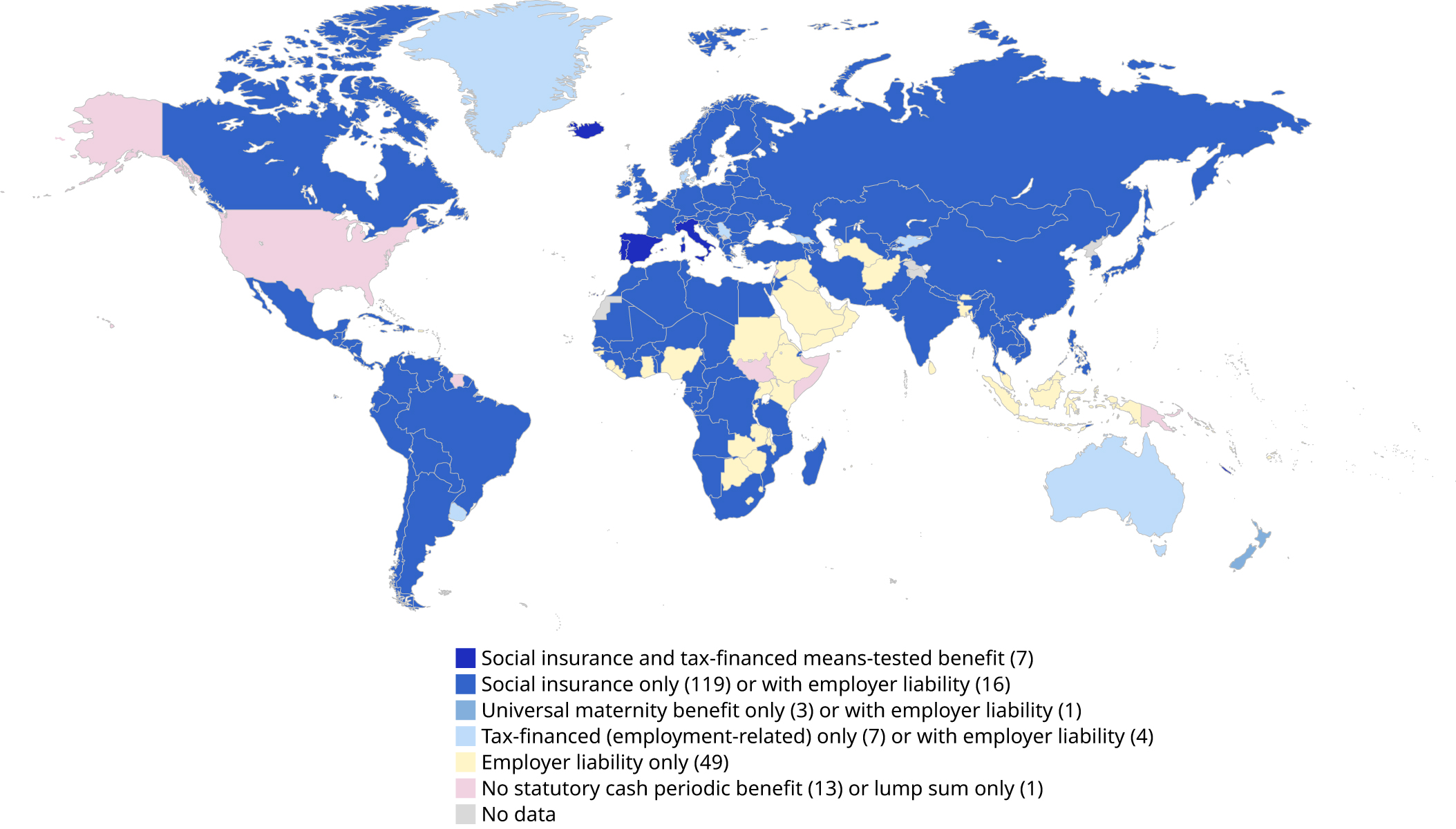
Disclaimer: Boundaries shown do not imply endorsement or acceptance by the ILO. See full ILO disclaimer.
Note: The number between parentheses refers to the count of countries or territories.
Sources: ILO modelled estimates; World Social Protection Database, based on the Social Security Inquiry; ISSA Social Security Programs Throughout the World; ILOSTAT; national sources.
Coverage of maternity benefits
Worldwide, only just above one out of three pregnant women receives a cash benefit to compensate for reduced income generation capacities around the time of childbirth. The effective population coverage of maternity benefits has increased modestly between 2015 and 2023, from 29.6 to 36.4 per cent, with massive regional differences (figure 4.10). All regions experienced progress but increases were much more pronounced in Asia and the Pacific (an increase of more than 13 percentage points, from 25.8 to 38.4 per cent) and less in Africa (from 4.3 to 6.7 per cent) and Europe and Central Asia (from 77.4 to 79.4 per cent). Progress has also been much slower in low-income countries (from 1.5 to 2.6 per cent) and fastest in lower-middle-income countries (from 25.9 to 36 per cent). The low overall coverage and slow progress in low-income countries illustrate the extent to which they are left behind and uncoupled from global trends.
Figure 4.10 SDG indicator 1.3.1 on effective coverage for maternity protection: Share of women giving birth receiving maternity cash benefits, by region, subregion and income level, 2015 and 2023 (percentage)
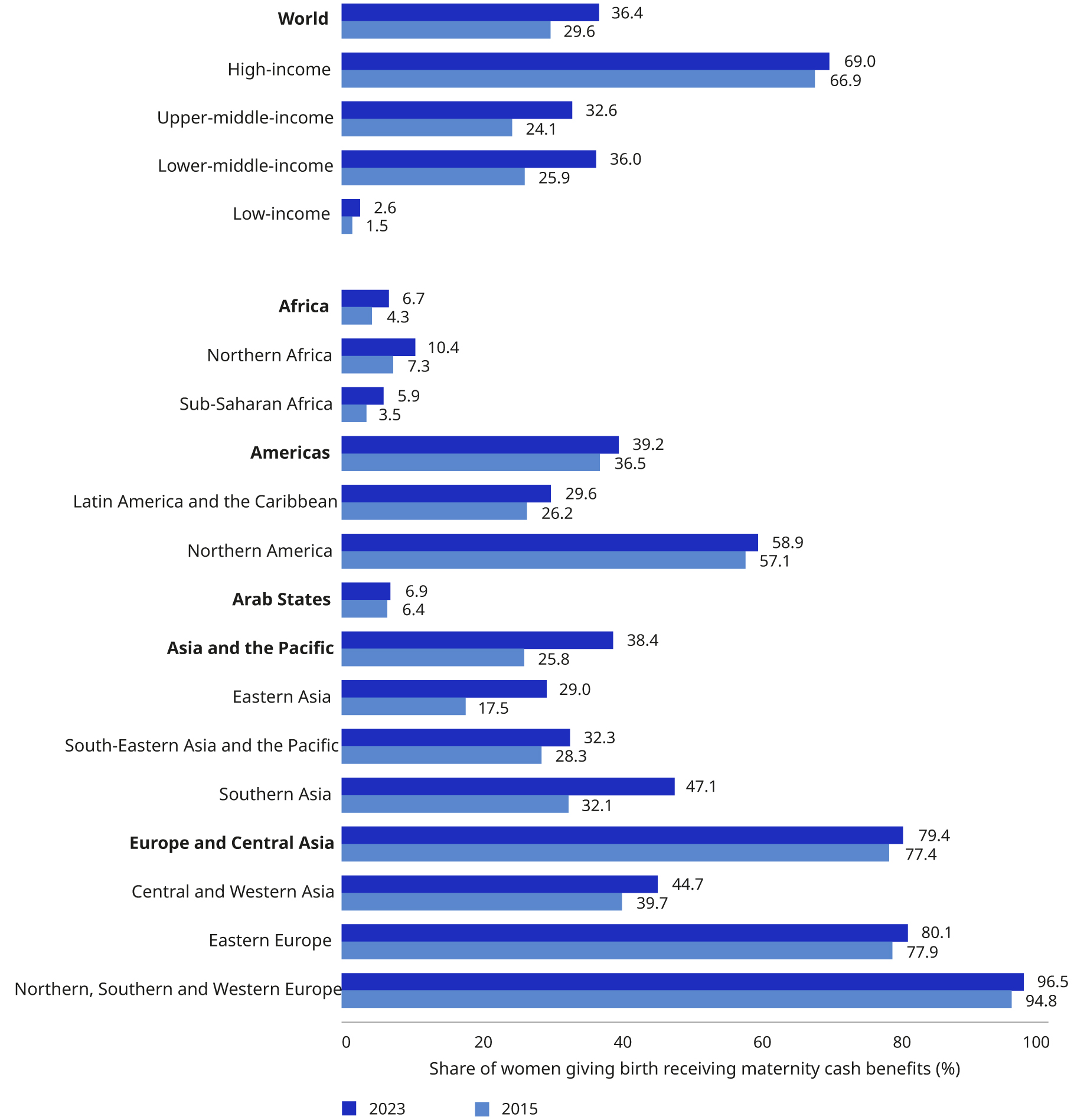
Notes: See Annex 2 for a methodological explanation. Global and regional aggregates are weighted by number of women. Estimates are not strictly comparable to the previous World Social Protection Report due to methodological enhancements, extended data availability and country revisions.
Sources: ILO modelled estimates, 2024; World Social Protection Database, based on the Social Security Inquiry; ISSA Social Security Programs Throughout the World; ILOSTAT; national sources.
Figure 4.11 SDG indicator 1.3.1 on effective coverage for maternity protection: Share of women giving birth receiving maternity cash benefits, 2023 or latest available year (percentage)
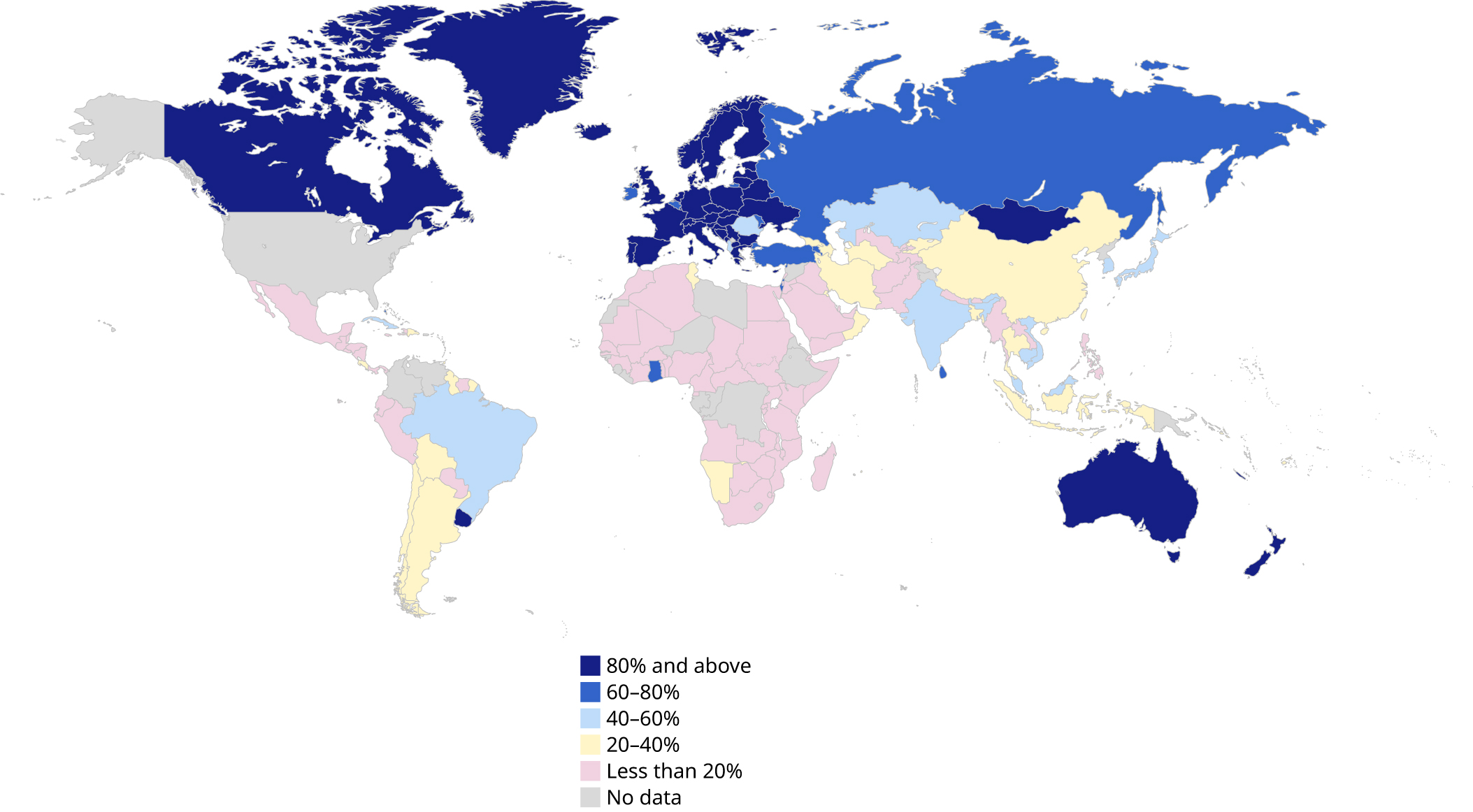
Disclaimer: Boundaries shown do not imply endorsement or acceptance by the ILO. See full ILO disclaimer.
Sources: ILO modelled estimates, 2024; World Social Protection Database, based on the Social Security Inquiry; ISSA Social Security Programs Throughout the World; ILOSTAT; national sources.
Thirty-nine countries have achieved close to universal coverage, with more than 80 per cent of pregnant women receiving maternity cash benefits, mainly high-income countries and mostly in Europe. Whereas in 63 countries (39 of them in sub-Saharan Africa), coverage remains at less than 10 per cent. Mongolia stands out as the only lower-middle-income country with universal coverage. While 69.0 per cent of childbearing women are covered in high-income countries, only 2.6 per cent of women are covered in low-income countries (figures 4.10 and 4.11). Coverage gaps largely relate to the prevalence of informal employment and the lack of appropriate mechanisms to cover women outside formal employment.
Legal coverage stands at 46.6 per cent (figure 4.12) when considering mandatory social insurance (26.7 per cent) and tax-financed benefits (19.9 per cent) together.9 The difference of 10 percentage points between legal and effective coverage suggests an enforcement gap and the existence of barriers for accessing benefits. Regional and income level variations are large, with legal coverage around 10 per cent in Africa, the Arab States and in low-income countries, and the highest coverage rates in Europe and Central Asia. Southern Asia stands out as the subregion with the highest legal coverage with tax-financed maternity benefits, which can be attributed to the fact that both India and Bangladesh have universal tax-financed maternity benefits that provide at least a basic level of income security. However, the much lower effective coverage figures for Southern Asia seem to suggest that the entitlement is not (yet) fully realized.
Figure 4.12 Legal coverage for maternity protection: Share of women in working age over 15 years old covered by maternity cash benefits, by region, subregion, income level and type of scheme, 2023 or latest available year (percentage)
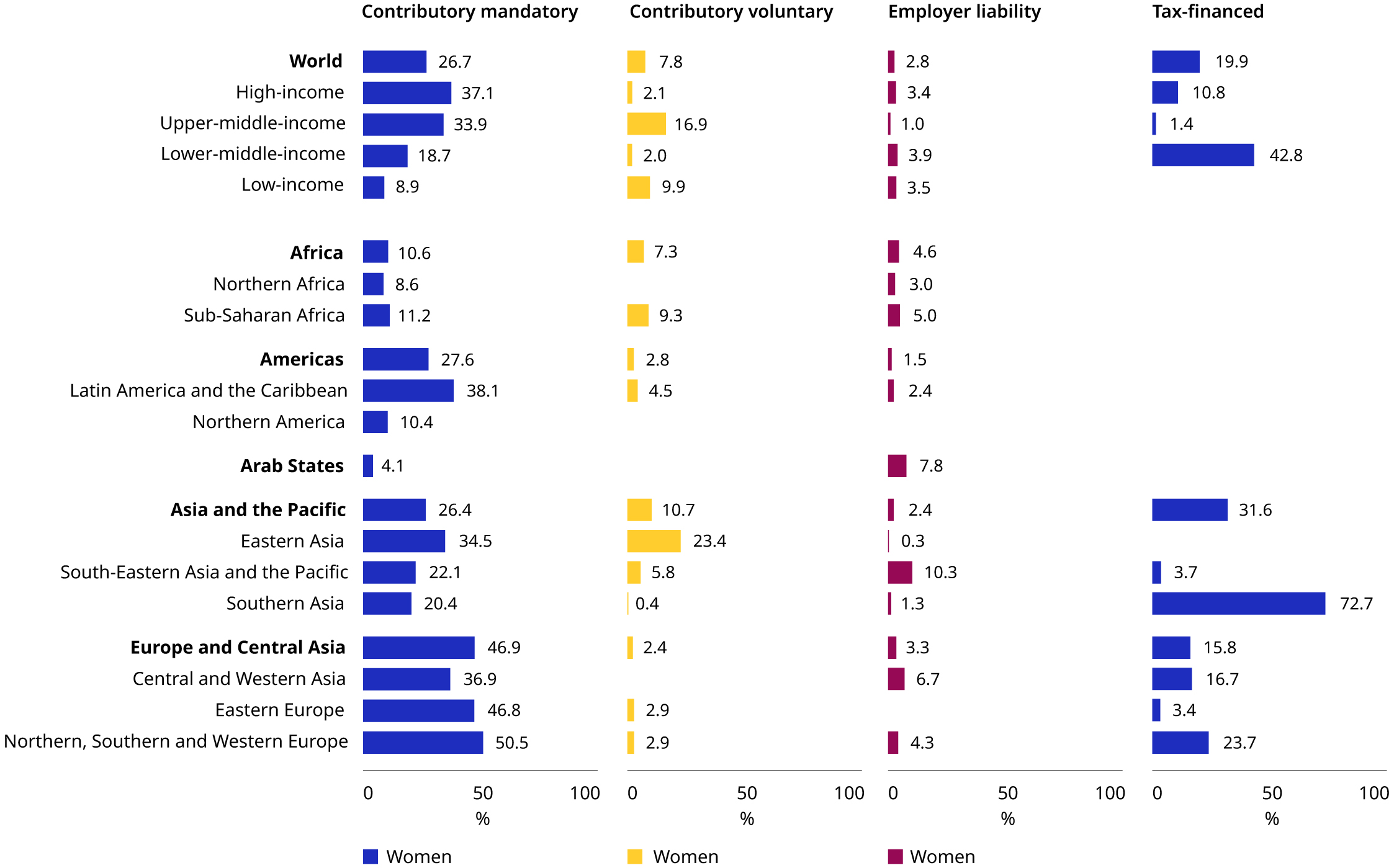
Note: Global and regional aggregates are weighted by the women in the working age. Estimates are not strictly comparable to the previous World Social Protection Report due to changes in the methodology.
Sources: ILO modelled estimates; World Social Protection Database, based on the Social Security Inquiry; ISSA Social Security Programs Throughout the World; ILOSTAT; national sources.
In 16 countries, pregnant and childbearing women can benefit from publicly financed cash transfer programmes. However, many of these programmes are not anchored in law and tend to cover only a small fraction of the population, with often very modest benefit amounts that do not allow women to withdraw temporarily from paid or unpaid work. As a result, women continue to work too far into pregnancy or return to work too soon after childbirth, with potentially negative effects on their own and their babies’ health. Finally, in many low-and lower-middle-income countries, these cash transfer programmes come with behavioural conditions which tend to reinforce the traditional division of paid and unpaid care work between women and men (ILO 2016c; 2016a; 2019a). For example, receipt of benefits may be conditional on uptake of pre-and postnatal care, skilled delivery or health checks-ups for and vaccination of the child, and sanctions may be applied if the conditions are not fulfilled. Unless those services are affordable, accessible geographically, of high quality and culturally acceptable for women, conditionality will result in women obtaining neither the cash benefit nor the needed health services.
Adequacy of maternity benefits, in duration and amount, to ensure income security
According to international standards, governments should provide income security for expecting women, at least so that “the woman can maintain herself and her child in proper conditions of health and with a suitable standard of living” (Convention No. 183). Minimum adequate benefit levels are nationally defined and “may correspond to the monetary value of a set of necessary goods and services, national poverty lines, income thresholds for social assistance or other comparable thresholds established by national law or practice, and may take into account regional differences” (Recommendation No. 202). For higher-level standards, the objective is not only preventing poverty but also being able to maintain a certain standard of living despite income loss around the time of delivery. International labour standards therefore also define minimum benefit levels as a share of previous earnings. These levels are set as a minimum of 45 per cent in Convention No. 102 and two thirds in Convention No. 183.
Out of 210 statutory maternity cash benefit schemes in 173 countries, 190 schemes pay benefits as a share of previous earnings; of which 124 schemes replace the full earnings, 41 schemes replace at least 66 per cent as required by Convention No. 183, and 21 schemes replace at least 45 per cent as required by Convention No. 102.
International standards also require a minimum duration of paid maternity leave, protecting women from having to work too long into their pregnancy or returning to work too fast before being fully recovered. The minimum duration is set at 12 weeks in Convention No. 102 and 14 weeks in Convention No. 183. A total of 121 of the 210 schemes meet the higher standard of 14 weeks or more, and 51 grant the benefit for at least 12 but less than 14 weeks. Thirty-eight schemes provide benefits for less than the recommended 12 weeks.
Paternity leave10
Adequate provision for paid paternity leave is an important corollary to maternity protection policies and contributes to a more equal sharing of family responsibilities and other unpaid care work (ILO 2019f). In 2021, 115 out of 185 countries surveyed by the ILO offered a right to paternity leave (see Table 4.2), with an average duration of nine days. Thirty-three countries introduced paternity leave between 2011 and 2022, which points to the increasing recognition of men’s caregiving role. However, almost two thirds of potential fathers11 (1.26 billion men) live in countries with no entitlements to paternity leave and are missing out on the unique opportunity to bond with their newborn children.
Paternity leave is paid in the majority of countries (102 of 115) that provide this entitlement. However, in 61 of these countries providing paid paternity leave, the cash benefit is granted through an employer liability. Due to the potential deterrent effect of employer liability schemes, some countries have reformed the source of funding for paternity leave cash benefits, abandoning full employer liability towards systems based on collective responsibility. Between 2011 and 2023, Luxembourg, the Netherlands, Oman, the Seychelles and Uruguay moved to a system where these benefits are collectively financed. Over the same period, Myanmar and South Africa moved from full employer liability to a system where fathers on paternity leave are fully paid by social protection.
Only 30 out of 115 countries with paternity leave have mandated paternity leave cash benefits for self-employed workers, and just 42 countries have paternity leave provisions applicable to adoptive fathers. Provision of paternity leave for same-sex couples is also scattered. Only 20 countries grant paternity leave to same-sex parents, with the majority of these countries in Europe and Central Asia, except Australia, Mexico, New Zealand and South Africa.
Table 4.2 Source of funding of paternity leave cash benefit, by region and income level, 2021 (number of countries)
|
Region/income group |
No statutory paternity leave |
Social protection |
Employer liability |
Mixed |
Unpaid |
|
World |
70 |
32 |
61 |
9 |
13 |
|
Africa |
22 |
4 |
25 |
1 |
2 |
|
Americas |
15 |
3 |
13 |
1 |
2 |
|
Arab States |
8 |
– |
3 |
– |
– |
|
Asia and the Pacific |
15 |
5 |
12 |
– |
1 |
|
Europe and Central Asia |
10 |
20 |
8 |
7 |
8 |
|
Low-income |
12 |
1 |
13 |
– |
2 |
|
Lower-middle-income |
22 |
5 |
17 |
– |
3 |
|
Upper-middle-income |
20 |
5 |
21 |
– |
4 |
|
High-income |
16 |
21 |
10 |
9 |
4 |
Source: Addati, Cattaneo and Pozzan (2022).
Despite the recent introduction of paternity leave provisions by a number of countries and the benefits associated with paternity leave, take-up rates remain low. Potential reasons include stereotypes about men as “breadwinners” while ignoring their role as fathers and caregivers. For this reason, Chile, the Islamic Republic of Iran, Italy, Luxembourg and Suriname have introduced obligatory paternity leave, while others (such as France, Portugal and Spain) have only required fathers to take a portion of existing parental leave entitlements (Addati, Cattaneo and Pozzan 2022).
Parental leave
In addition to maternity and paternity leave and benefits, in line with the ILO Workers with Family Responsibilities Convention, 1981 (No. 156) and Recommendation (No. 165), some countries have introduced parental leave that either parent can take subsequent to the paid maternity or paternity leave. In 2021, 68 out of 185 countries offer a statutory right to parental leave, 48 of them in Europe and Central Asia. In 21 of these countries, the leave is unpaid; 11 countries pay a share of previous earnings; all except one have a replacement rate above 45 per cent; and 7 pay a flat rate. The duration varies between 18 weeks to up to two years. Since take-up rates remain low for fathers, 15 countries reserve specific periods of leave for fathers to facilitate a more equitable sharing of care responsibilities (Addati, Cattaneo and Pozzan 2022). Some countries and employers also implement complementary measures to flexibilize the working time and accommodate childcare responsibilities, especially in the early years. Flexitime and teleworking can be important measures to allow women to combine work and family responsibilities without experiencing a pension penalty later in life (see Chapters 4 and 5). In contrast, long periods of parental leave for mothers have been shown to produce adverse effects for women’s employment and career opportunities (Semyonov and Mandel 2006)
In addition, the challenge of combining responsibilities to care for young children and responsibilities to earn a living is also recognized as a contingency. It is mainly covered through (a) family or child benefits; (b) the public provision of affordable, accessible, quality and acceptable childcare for preschool children (see section 4.1); (c) breastfeeding arrangements; (d) sickness benefits for sick children (section 4.2.3); and (e) tax policies designed in a way to promote gender equality at home and at work.
Maternity protection in an era of climate crisis and others
To a large extent, the lack of access to adequate maternity protection reflects persisting gender inequalities and discrimination that women experience daily around the world. For example, a recent World Bank report found that women enjoy two thirds of the legal rights available to men, with 37 countries granting half a billion women less than half of the legal rights of men (World Bank 2024). Biased norms around gender roles, related structural discrimination and resulting unequal opportunities for education, participation in the labour market, career opportunities, ownership of assets, financial and digital inclusion, voice, access to essential services, decision-making power and political representation, all contribute to women overall being less resilient. Thus, they are more at risk and more affected by climate hazards and have less capacity to recover (Sepúlveda 2024). These structural disadvantages hit pregnant women even harder, in light of their greater needs and vulnerability. Various actors have called attention to the need to build social protection systems that protect pregnant women also in view of increased vulnerabilities resulting from the climate crisis. In addition to ensuring social protection floors that guarantee access to free maternity care – as well as income security for all pregnant women and higher levels of protection for as many women as soon as possible – the WHO, UNICEF and the UNFPA have issued a call for action to better protect pregnant women, newborns and children from the impacts of climate change (WHO, UNICEF and UNFPA 2023a). Social protection systems which provide income security to ensure women can stop working before and after delivery, and which facilitate access to affordable reproductive and maternity care, including during times of crisis, are key to this endeavour. Especially in low-and lower-middle-income countries, the international community is failing women on its promise to leave no one behind, with 95 per cent of maternal deaths occurring in these countries.
4.2.3 Sickness benefits
Key messages
-
Sickness cash benefits are a critical tool for breaking the vicious cycle of poor health and poverty. Yet, they are legally guaranteed for less than two third of the global workforce, representing a little over a third of the working age population, mostly concentrated in high-and upper-middle-income countries. Over four in ten workers are left legally unprotected. Even when covered, adequacy remains an issue, as benefit level, duration and eligibility criteria (such as waiting periods) may create gaps in protection.
-
Almost a quarter of countries in the world provide paid sick leave exclusively through employer liability rather than collectively financed sickness benefits. Such arrangements tend to exclude some categories of workers, create discrimination against workers with chronic conditions and are not appropriate in case of public health crises, all of which are impacted by climate change.
-
Sickness benefits are essential to cushion some of the direct impacts of climate change on health and labour productivity. The related needs are projected to be most acute in countries and regions where sickness benefit coverage is at its lowest. To maximize their impact on health and well-being, sickness benefits may need to adapt their portability, eligibility criteria and disbursement modalities to changing national circumstances that may include more intense and frequent adverse climate events and health emergencies.
-
Sickness benefits are a central element of pandemic prevention, preparedness and response as they support public health and social measures. The COVID-19 crisis revealed the decent work deficits of the most vulnerable workers, including front-line workers and migrant workers. In response, some countries have transitioned out of employer liability mechanisms or are in the process of doing so. This effort needs to be sustained and extended.
-
More and better data are urgently needed. Shortage of data on sickness benefit effective coverage prevents its monitoring as part of the SDG framework.
The case for universal sickness benefits in a changing climate
To support the response to the climate crisis, sickness benefits need to be extended to all in need. Sickness benefits aim to ensure income security during sickness, quarantine or sickness of a dependent relative. As such, it is a social protection instrument with a public health objective (ILO 2020d). Sickness benefits allow individuals to stay at home until full recovery, thereby protecting their own health and, in the case of communicable diseases, the health of others. Sickness benefits contribute to the human rights to health and to social security (ILO 2017b), more important than ever when facing adverse health events for individuals and society alike. Key principles for their design are included in ILO standards (ILO 2020j) (see box 4.5).
The impact of climate change on health affects population groups unevenly. Impacts are stronger on those who are living with a disability or who are affected by long-term and chronic diseases. For instance, temperature rise affects the management of diabetes and other chronic diseases (He et al. 2020; Witt et al. 2015). Changes in the climate system affect non-communicable disease management, intensity and likely outcomes (Baldermann, Laschewski, and Grooß 2023; Breitner-Busch et al. 2023; Kjellstrom et al. 2010; Peirce, Espira and Larson 2022). People living with disabilities or with long and chronic illnesses already have additional costs of living related to their condition and the lack of adaptation of their living and working environments (WHO 2022a; 2023a). Some of those costs relate to working time lost seeking care, transportation costs and others, which may be heightened by not only the direct effects of climate change, but also some of the adaptation and mitigation policies to counter it. In this context, ensuring that all people can have income security when they or their dependent relatives need to seek care, quarantine, or recover from illness or healthcare intervention, will be instrumental.
Climate change is increasing exposure to heat stress, infectious diseases, extreme weather events, environmental pollution stress and other mental health strains (Flouris et al. 2018; Levi, Kjellstrom and Baldasseroni 2018; Bennett and McMichael 2010). It also reshapes the livelihood opportunities in many places, thus increasing exposure to undernutrition and malnutrition as well as impacting households’ financial capacities to cope with increased cost of healthcare (Bennett and McMichael 2010; Willett et al. 2019). Sickness benefits will need to adapt to those changes and the overall increase in the disease burden that directly impact working populations, their productivity and their capacity to work. Without sickness benefits in place, the risk of impoverishment is increased and adds to the vicious cycle of climate change and poverty.
Box 4.5 Key sickness benefit principles from international standards
|
The following international social security standards provide essential guidance on sickness benefits: the Income Security Recommendation, 1944 (No. 67); the Social Security (Minimum Standards) Convention, 1952 (No. 102); and the Medical Care and Sickness Benefits Convention, 1969 (No. 130) and the Medical Care and Sickness Benefits Recommendation, 1969 (No. 134). These instruments reflect an international consensus on the following principles:
|
Legal and effective coverage
Legal coverage
The ILO estimates that 56.1 per cent of the labour force in the world, representing 34.4 per cent of the working-age population, are legally entitled to sickness benefits (both contributory and non-contributory). This leaves more than four in ten workers without legal coverage (figure 4.13). There are wide regional differences, with high levels of legal coverage in Europe, Central Asia and Latin America and the Caribbean, and lower levels in the Arab States, Africa, and Asia and the Pacific.
Some categories of workers are often legally excluded from sickness benefits, such as workers in part-time and temporary employment, self-employed workers and jobseekers (ILO 2021i). In the context of climate change, additional efforts are needed to extend protection to all workers in the rural economy, whose occupation and health are both likely to be drastically impacted by the changing climate (for example, by higher exposure to heat stress in a number of countries, related risks of skin cancer, and cardiovascular issues) (ILO 2023o).
Sickness benefits should not be confused with paid sick leave as an employer liability (box 4.6). A total of 65 countries rely exclusively on an employer liability mechanism to compensate the loss of income during sickness (see figure 4.14), and 8.6 per cent of the global labour force is legally entitled to paid sick leave provided directly by their employer – called “employer liability”. Although legal protection can be provided by employer liability, sickness benefits offer a more robust way to provide income security in case of ill health, quarantine or sickness of a relative. Indeed, reliance on employer liability may have adverse effects. Coverage is limited, by definition, to salaried work only (self-employed people being their own employer) and it often also excludes specific categories of employees, such as casual workers and workers who are paid hourly wages. Solidarity in financing is further limited as individual enterprises are left to bear the costs of workers’ sickness. This may put pressure on workers not to take sick leave, and lead to discrimination in recruitment against individuals with declared medical conditions. Small enterprises may struggle with the financial implications and therefore have an incentive to employ workers in forms of employment that are not subject to statutory paid sick leave (ILO 2020d).
Since the COVID-19 pandemic, which brought into sharp focus sickness benefit coverage gaps and the limitations of employer liability, some countries have taken action to build sickness benefits into their national social protection systems, thereby increasing their comprehensiveness (box 4.7).
Figure 4.13 Legal coverage for sicknes4s. protection: Share of labour force aged 15 and over covered by sickness cash benefits, by region, subregion, income level, sex and type of scheme, 2023 or latest available year (percentage)

Notes: Global and regional aggregates are weighted by the labour force aged 15 and over. Estimates are not strictly comparable to the previous World Social Protection Report due to changes in the methodology.
Sources: ILO modelled estimates; World Social Protection Database, based on the Social Security Inquiry; ISSA Social Security Programs Throughout the World; ILOSTAT; national sources.
Box 4.6 Sick leave and sickness benefits: Definitions
|
Sick leave addresses the need to take leave when a person is sick and should be defined in labour law. Sick leave is an entitlement separated from other types of leave, recognized in both the Holidays with Pay Recommendation, 1954 (No. 98) and the Holidays with Pay Convention (Revised), 1970 (No. 132). Sick leave entitlements should be reflected in contracts and take into account equality of treatment for temporary and other types of vulnerable employment (ILO 2011a; 2019f). Each country defines instances in which there is a suspension of earnings during sick leave for salaried workers. Countries may also define a period, if any, during which there is a legal obligation for employers to cover the salary of workers (employer liability). Sickness benefits guarantee that an adequate income is provided when a person is ill and unable to earn an income. To maximize the impact of sickness benefit schemes, ILO standards provide guidance for their design features and financing structure (see box 4.5). Sickness benefits should be financed collectively based on broad risk pooling and solidarity – and should not be borne by the employer or worker alone. |
Figure 4.14 Sickness protection (cash benefits) anchored in law, by type of scheme, 2023 or latest available year
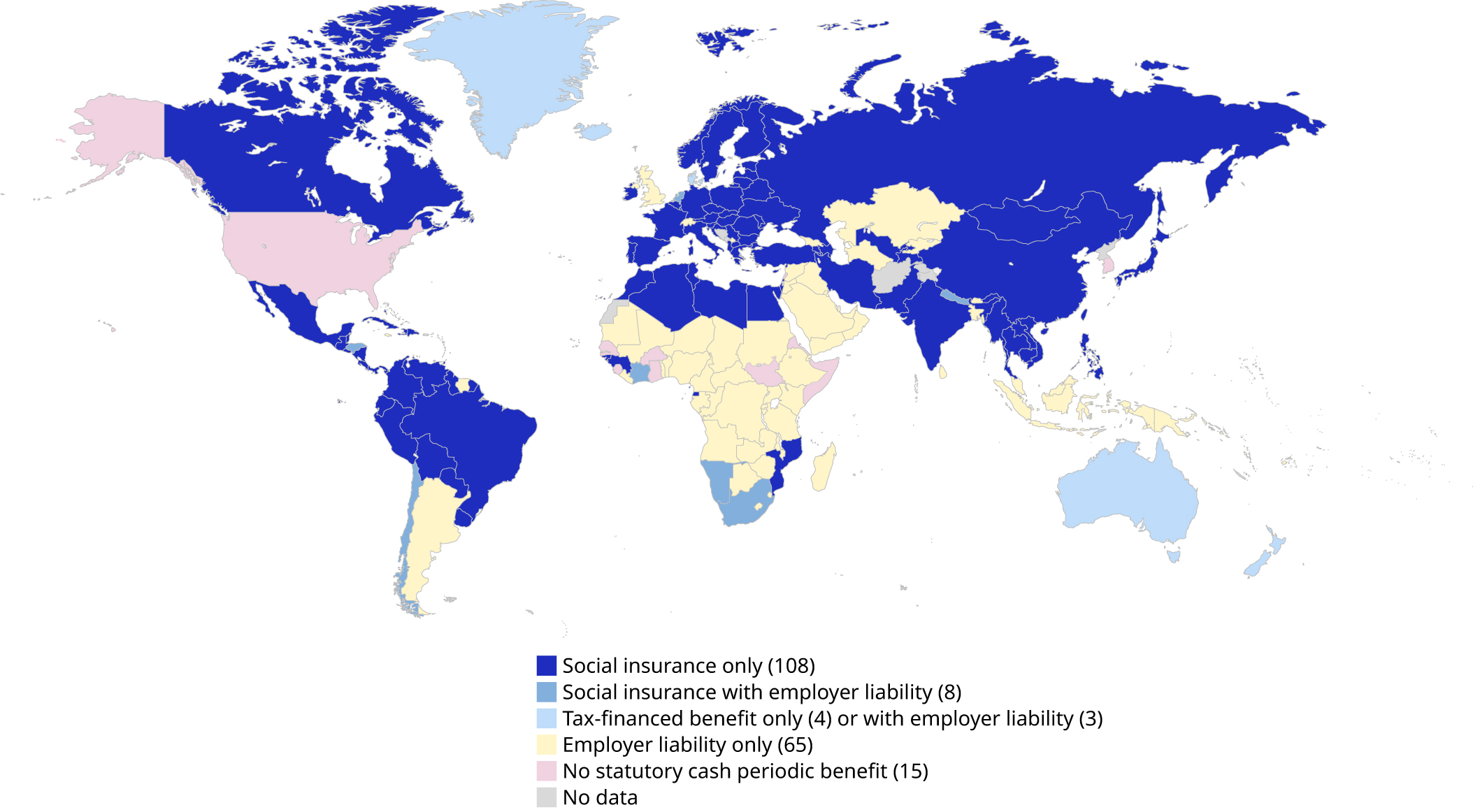
Disclaimer: Boundaries shown do not imply endorsement or acceptance by the ILO. See full ILO disclaimer.
Note: The number between parentheses refers to the count of countries or territories.
Sources: ILO modelled estimates; World Social Protection Database, based on the Social Security Inquiry; ISSA Social Security Programs Throughout the World; ILOSTAT; national sources.
|
Box 4.7 Introduction of sickness benefits in Oman In July 2023, Oman issued Royal Decree No. 52/2023 promulgating a new Social Protection Law, which unifies the social protection system in the country under a coherent legal framework, and creates new benefits, including sickness cash benefits. Until then, paid sick leave was an employer liability, which was not implemented uniformly across sectors and categories of workers, and which created a risk of discrimination against workers with pre-existing health conditions. The new law creates a sickness benefit for all workers, including migrants on par with nationals, in all sectors of activity with the notable exception of domestic work, where the migrant population is disproportionately represented. In addition, it increases the maximum period of sickness benefit to 26 weeks, in line with ILO minimum provisions under Convention No. 102. The introduction of the sickness benefit was an opportunity to extend provisions to support care responsibilities for sick family members up to 30 days a year. Such reform could be an inspiration for the rest of the Gulf Cooperation Council countries, most of which still rely on employer liability with low compliance among migrant workers, who make up the majority of the labour force (ILO 2023s). In a recent survey of Nepali workers returning from Gulf Cooperation Council countries, 76 per cent of respondents reported not being able to take sick leave every time they were ill, and 17 per cent were never paid when sick (ILO 2023b). The transition to a social protection mechanism for sickness benefits instead of employer liability is critical to enhance effective access for the most vulnerable workers. |
Effective coverage
Even if workers are legally covered for sickness benefits, they would only be effectively covered once they are affiliated to a scheme, are aware of their entitlements, understand access procedures, and effectively receive their benefits when needed. Several barriers can prevent effective coverage, including administrative or geographical barriers, and non-compliance with registration procedures or lack of awareness (Scheil-Adlung and Bonnet 2011; ILO 2014 c; 2017b; 2021q; 2021i). Despite its importance for public health, a lack of comprehensive and systematic data collection on the different aspects of effective coverage has led to income security during illness currently being excluded from SDG monitoring efforts12 (Lönnroth et al. 2020; Thorpe et al. 2020).
Adequacy of benefits
Benefit adequacy depends on the level of income support, the duration and the existence of a waiting period. When benefit levels are calculated as a percentage of past earnings, the existence of a guaranteed minimum benefit level is essential for low-income workers (ILO 2021a, 253). Out of 172 countries for which information is available, 51 have provisions for less than 60 per cent of past earnings.
Benefit duration is also important, as persons affected by long-term illnesses are in critical need of an income and may lose their job if there is no or insufficient sickness benefit provision. Similarly, a smooth transition to temporary or permanent disability benefits is needed, as such benefits are also affected by important coverage gaps (see section 4.2.5). In this respect, some countries have decided to create specific benefits for long diseases or even integrate chronic diseases into the eligibility criteria for disability benefit schemes. Globally, 75 countries provide benefits for a maximum duration lower than the minimum requirement of 26 weeks under Convention No. 102.
Table 4.3 National legal provisions on level and duration for sickness benefits
|
Benefit level and duration |
Number of countries |
|
At least 60 per cent of past earnings and 26 weeks |
71 |
|
At least 26 weeks but less than 60 per cent of past earnings |
26 |
|
At least 60 per cent of past earnings but less than 26 weeks |
50 |
|
Less than 60 per cent of past earnings and 26 weeks |
25 |
|
Total number of countries for which information is available |
172 |
Sources: ILO modelled estimates; World Social Protection Database, based on the Social Security Inquiry; ISSA Social Security Programs Throughout the World; ILOSTAT; national sources.
A minority of countries concentrated in the high-and upper-middle-income groups are compliant with the minimum sickness benefit level and duration in Convention No. 102 (see table 4.3). In the Arab States and Asia and the Pacific, less than a fifth of the countries reporting information have benefit levels of at least 60 per cent of past earnings and a duration of at least 26 weeks, while the proportion is around a third in Africa.
In some countries, sickness benefits are subject to a waiting period, which may hinder their public health impact on the prevention of diseases and/or their complications. In total, 61 countries have waiting periods and 28 countries have waiting periods greater than three days.
Sickness benefits should be granted including when a worker is undergoing preventive care and has to isolate for the purpose of quarantine, in line with ILO standards. A greater impact of such benefits on public health, health and well-being can be achieved through provisions for self-isolation or caregiving for dependants.
Climate-sensitive sickness benefits
Three important factors need to be considered in the design and implementation of sickness benefits to ensure their contribution to climate change adaptation and mitigation:
-
The capacity to work of workers in some sectors is affected and will be increasingly affected by weather conditions (ILO 2019g; 2024g), which makes it necessary to revisit the scope of the sickness benefits contingency and its coordination with unemployment protection and occupational injuries and diseases benefits (ILO 2024f).
-
The global burden of chronic, long-term and non-communicable diseases is increasing globally and with the climate crisis, the need for sickness benefits is likely to increase in geographical areas that are particularly exposed to adverse climate impacts (Bennett and McMichael 2010; ILO 2019g), which also tend to be those in which sickness benefits are non-existent or very limited, while in other places, such benefits may stagnate or be reduced (Lipponen et al. 2024).
-
The increase in health security threats due to the climate crisis has an impact on infectious and communicable diseases. It therefore calls for an adapted design for sickness benefits to maximize their contribution to epidemic and pandemic prevention, preparedness and response.
Sickness benefits design and implementation
Scope of the contingency, eligibility and benefit disbursement
Eligibility and benefit disbursement may need to be adapted to the changing climate for a number of professions. This is particularly the case for those who will not be able to work when the temperature is above a certain threshold, which will impact most severely the rural economy and outdoors occupations, such as construction (ILO 2019b).
Changes in labour capacity due to extreme weather exposure (measured in lost working hours) disproportionately affect countries ranking low on the Human Development Index, with low healthcare and sickness benefit coverage rates and nascent systems (ILO 2021q). Most of the measured losses relate to heat exposure. In 2022, an estimated 490 billion potential labour hours were lost and the biggest losses were concentrated in low-and middle-income countries (Romanello et al. 2023). For instance, in 2020, such losses were three times the global average in Bangladesh, India and Pakistan (Romanello et al. 2021). Highly climate-sensitive livelihoods, such as agriculture, show particularly prominent social protection coverage gaps. Without unemployment or sickness benefits, those lost working hours translate into income losses, with likely knock-on effects on the social determinants of health. Alternatively, workers will work at the risk of damaging their health, possibly incurring additional occupational accidents. This could lead to impoverishing consequences in countries where social health protection, occupational health services and compensation schemes are not guaranteed (see section 4.4), affecting workers’ capacity to work and earn an income.
Portability of benefits in the context of climate-induced migration and displacement
The erosion of natural resources in some regions, extreme weather events and socio-economic consequences of the climate crisis, including conflicts over resources, are driving population displacement and migration, while also hampering return opportunities for those already displaced (see sections 2.1.2 and 3.2.3). In this context, social health protection entitlements, both for healthcare services and income support, need to be portable and inclusive.
Identification and eligibility procedures during extreme weather events
Some flexibility and agility in identification and eligibility procedures are needed to continue to reach people during emergency situations – in particular, extreme weather events such as floods or cyclones. Indeed, in many countries that do not yet universally cover their population for sickness benefits, eligibility criteria can be narrowly defined (ILO 2021d) and may need to be relaxed in situations where vulnerability is generalized (ILO 2020g). Especially under such circumstances, grievance redressal mechanisms and consistent and regular monitoring are key to evaluate the modified schemes (ILO 2024f).
Sickness benefits and the global burden of chronic, long-term and non-communicable diseases in a changing climate
Non-medical costs,13 including income loss, increase the risk of poverty and reduce adherence to public health measures and treatment for patients and their families. The risks of impoverishment are even greater when healthcare benefits are not guaranteed and the cost of healthcare services must be borne out of pocket (see section 4.4). The impoverishing impact of long or chronic diseases, the burden of which is highly impacted by the changing climate, is well documented (WHO 2018). For example, national tuberculosis patients cost surveys show that patients face significant direct non-medical costs (mostly transport and nutrition) and income loss (which can represent the majority of the related costs), creating incentives to forgo care (WHO and ILO 2024).
Data analysis has shown that social protection spending levels are inversely associated with the prevalence of tuberculosis (Siroka, Ponce and Lönnroth 2016). Furthermore, the adequacy of benefit levels is strongly associated with health impact (Lönnroth and Weil 2014). The vicious cycle of poverty and poor health and the social gradient in health are particularly illustrated when it comes to tuberculosis. This disease affects most strongly low-and middle -income countries and, within countries, populations at the lower end of the income spectrum (WHO 2023a). Emerging evidence also shows that tuberculosis is a climate-sensitive disease, with a positive association between climate change and the five risk factors for the disease (HIV infection, diabetes mellitus, undernutrition, overcrowding and poverty) (Kharwadkar et al. 2022). Similar evidence on the need for and impact of social protection are emerging for a range of long-term or chronic diseases (such as HIV, diabetes and hypertension) and persons with comorbidities, illustrating the need for a systemic response (Jan et al. 2018; Kazibwe, Tran and Annerstedt 2021). New joint WHO–ILO guidance on social protection for people affected by tuberculosis recommend to progressively move away from social protection programmes targeted at single diseases (WHO and ILO 2024) and secure comprehensive social protection systems, which include sickness benefits and are based on rights, a necessary feature to avoid stigma (Ferreira et al. 2023).
Sickness benefits and epidemic and pandemic prevention, preparedness and response
Sickness benefits play a crucial role in supporting public health and social measures during health security crises. The COVID-19 pandemic, and previous public health crises such as SARS or MERS, had already put sickness benefit coverage gaps in the spotlight, illustrating how the lack thereof compelled people to work when sick or quarantined, increasing the risk of contagion (ILO 2020e; Drago 2010; James 2019). With a projected increase in health security threats in the new climate context, sickness benefits are a central policy instrument to incentivize preventive behaviours and cushion the socio-economic consequences (ILO 2020e).
The following measures should be taken, drawing on the lessons learned from previous epidemics:
-
Securing the existence of sickness benefits under comprehensive social protection systems and making them accessible to all. This may mean that sickness benefits need to be extended quickly in case of a health emergency in countries where universal access is not yet in place. For example, in Colombia, beneficiaries of the non-contributory social health insurance scheme, who were not covered for sickness cash benefits before the COVID-19 pandemic, were made eligible to receive lump sum benefit payments equal to seven days of the minimum wage in case of contracting COVID-19 (Government of Colombia 2020).
-
Ensuring that quarantine is systematically considered as part of the contingency, in line with Recommendation No. 134 (ILO 2020e). For instance, during the COVID-19 pandemic, in Japan, cash sickness benefits were extended to those in quarantine or diagnosed with COVID-19, while requirements to obtain medical certificates were waived simultaneously (ISSA 2020).
-
Including flexibility and agility in identification and eligibility procedures. For example, in El Salvador, the social security institute extended benefit payments to any worker who needed to quarantine, without waiting period and regardless of whether or not they fell ill, during the COVID-19 pandemic (El Mundo 2020).
-
In order to ensure continuity of health and care sectors operations during health emergencies, it is important to also ensure that sickness benefits are available and adequate for health and care workers. The COVID-19 pandemic and previous health emergencies shed light on the protection gaps for many front-line workers and those in essential occupations (ILO 2020a; 2023x). Looking forward, as the world is moving towards a strengthened international legal framework on pandemics and health security threats, the crucial need for social protection in general and sickness benefits in particular cannot be overlooked (Adebisi et al. 2023; Viegas, Ventura and Ventura 2022; Nikogosian and Kickbusch 2021).
4.2.4 Employment injury protection
Key messages
-
In the context of climate change, it is even more essential to accelerate the extension of employment injury protection for work-related injuries and occupational disease, which contributes to achieving SDG target 1.3. Despite some progress, only 37.4 per cent of workers worldwide are covered by employment injury insurance. In low-and middle-income countries, coverage is significantly lower, owing to labour market structures and weak enforcement of schemes where they exist.
-
Extending employment injury protection to workers in the informal economy remains of high importance as part of realizing the fundamental right to a safe and healthy working environment for all workers. This is particularly urgent for those prone to the risks of climate change, including rising heat stress and extreme weather events. Safety and health at work can benefit from policy synergies with employment injury benefits for all workers.
-
The cost of employment injury benefits and of safety and health at work, including prevention of injury or disease and rehabilitation of injured workers, is part of the overall cost of production and contributes to preventing injured workers, and the families of injured and deceased workers, from falling into poverty.
-
Occupational diseases are consistently under-reported and undercompensated. Given the impact of climate change, countries with a clear list of the diseases covered would need to regularly review the range of diseases against which their employment injury insurance schemes protect. This is because global heating and biodiversity destruction allow existing diseases to spread to new places and will most likely result in the introduction of new diseases. Having a comprehensive range of diseases covered by employment injury insurance would reduce pressure and cost transfer onto other branches, such as healthcare and disability benefits.
-
Adequate employment injury benefits take the form of periodic payments, with cost-of-living adjustments for long-term benefits – for example, in cases of permanent disability and for survivors’ benefits. Yet, although more countries are adopting and implementing employment injury insurance schemes in line with international social security standards, 16 countries still depend on direct compensation by employers, 22 countries provide only lump sum benefits and 18 countries lack any kind of employment injury insurance scheme for injured and disabled workers. Transitioning to collectively financed employment injury insurance schemes would improve effective coverage – in particular in hazardous occupations and in small and medium-sized enterprises – and enhance protection levels.
Protecting workers in the event of work-related injuries and diseases
Despite significant progress in occupational safety and health, 2.9 million workers die every year as a result of occupational accidents or work-related diseases. In addition to these avoidable deaths, many workers are victims of non-fatal work-related injuries: 395 million non-fatal work-related injuries each year result in more than four days of absence from work (ILO 2023a). Climate change is already contributing to worsening health conditions and, more specifically, more work-related injuries due to heat stress and other factors (ILO 2024g; 2024b; Filomena and Picchio 2023). Given the risk of further temperature rise and extreme weather events, such negative impacts are likely to intensify in the future, with significant human costs in terms of avoidable disease, death and impairment. If they have not done so already, countries need to start introducing laws and regulations to protect workers from increasing injuries and ill health owing to climate emergencies, for example, by introducing work time shifts for outdoor workers to avoid excessive heat (ILO 2024g).
These developments render effective employment injury schemes even more important. Well-established employment injury schemes provide benefits in cash and in kind. These include medical care, financial compensation, and physical and vocational rehabilitation to those affected by work-related injuries and diseases, regardless of whether the accidents or ill health are climate-related. In doing so, such schemes address one of the key challenges in modern workplaces and act as an automatic stabilizer of workers’ health and well-being. Employers have the responsibility of securing occupational safety and health for their workers, and for providing fair, equitable and effective compensation to injured workers and the families of deceased workers. Collectively financed employment injury schemes organized through social insurance constitute an important risk-pooling mechanism anchored in national legislation, providing greater reliability and predictability for both workers and employers.
Yet, where collectively financed (social insurance) employment injury schemes are not in place, the only hope of redress for injured workers or their survivors lies in direct compensation paid by their employer or obtained in a lawsuit against the employer through the courts. Lawsuits are usually lengthy, costly and stressful for victims; they are therefore rarely pursued, and compensation is often not paid.
Where the financial responsibility for compensation rests on individual employers, they often take out private insurance. However, the outcomes of these schemes are often suboptimal. The processing of an insurance claim involves the need to obtain relevant information and requires the injured person to undergo rigorous medical assessments, causing substantial delays in obtaining healthcare and other benefits. In addition, an employer may be reluctant to make a claim for fear of other legal implications and the cost of compensation. Moreover, since the employer may not continue in business and a private insurer may be reluctant to provide benefits for a lengthy period of time, benefits are usually disbursed either in the form of a lump sum or through periodic payments for a short period of time, without the necessary adjustment in line with the cost of living. In recognition of these drawbacks, many countries have replaced employer liability systems with social insurance.
In addressing work-related injuries and disease, social insurance relies on the following principles:
-
“no fault”: an injured worker or survivor(s) of a deceased worker should qualify for benefits without having to prove “fault” on the part of the employer;
-
collective sharing of liability among employers, so that employers collectively finance the scheme, allowing for risk pooling among them; and
-
neutral governance of administration of the scheme: the right to benefit is established outside the contractual relationship between a worker and their employer.
Employment injury benefits in most countries consist of:
-
medical and allied care for injured workers; and
-
earnings-related periodic cash benefits for disabled workers, or for dependants of deceased workers, including funeral grants.
Many national employment injury schemes also include a set of wider objectives, such as rehabilitation and re-employment of injured or sick workers, and the promotion and maintenance of safety and health at work. These objectives can only be achieved in the context of an integrated framework for comprehensive occupational safety and health measures, strong inspection and enforcement measures, and adequate cash and healthcare benefits accompanied by appropriate physical and vocational rehabilitation services.
A rating system according to which levels of contribution are calculated to reflect the past performance of employers in respect of employment injuries, provides employers with an incentive to prevent workplace injuries and facilitate the return to work of injured workers. For such a scheme to work effectively, a strong inspection mechanism should be in place to avoid the risk of employers hiding accidents.
For this reason, rating systems are mainly adopted in high-income countries.
Financially sustainable and administratively efficient employment injury schemes are a step towards preventing injured workers and families of injured and deceased workers from falling into poverty. Thus, they contribute to the achievement of SDG 1 on ending poverty in all its forms everywhere.
The fundamentals of employment injury protection are summarized in the United Nations and ILO international standards specified in box 4.8.
Box 4.8 International standards relevant to employment injury protection
|
The right to protection against employment injury is enshrined in the Universal Declaration of Human Rights, 1948, and the International Covenant on Economic, Social and Cultural Rights, 1966.1 According to ILO Convention No. 102 (Part VI), any condition that has a negative impact on health and is attributable to a work accident or an occupational disease, and the incapacity to work and earn that results from it, must be covered. Accordingly, the provision must include medical and allied care that is free of charge, and cash benefit to the injured person or their dependants. The Employment Injury Benefits Convention, 1964 (No. 121), and its accompanying Recommendation, No. 121, set higher standards and recognize the importance of an integrated approach in improving working conditions, limiting the impact of employment injuries, and facilitating the reintegration of people with disabilities in the labour market and in society (for more details on the minimum requirements, see annex table A3.5). The approach taken by Recommendation No. 202 is different, reflecting its focus on preventing or alleviating poverty, vulnerability and social exclusion through income security guarantees and access to at least essential healthcare for all in need, irrespective of the origin of the disability or ill health giving rise to the need for income security and care. Basic income security and access to essential healthcare can be ensured through a variety of approaches, combining contributory and non-contributory schemes and different types of benefits. Particularly relevant to employment injury protection is the Recommendation’s further call for combining preventive, promotional and active measures with benefits and social services, and the coordination of social protection policies with policies that promote, among others, secure work within a decent work framework. 1 Universal Declaration of Human Rights, Art. 25(1); International Covenant on Economic, Social and Cultural Rights, Arts 7(b), 12(b) and (c). See UN (2008). |
Types of employment injury protection schemes and legal coverage
The majority of countries adopt a social insurance approach, although some countries retain elements of an employer liability approach so that workers who are not covered by social insurance schemes are compensated directly by employers.
Figures 4.15 and 4.16 illustrate the patterns of legal coverage for disability cash benefits worldwide. The information for medical and allied benefits is not available and additional efforts are required to collect comparable data at all levels. As figure 4.15 shows, the emphasis on social insurance, as opposed to employer liability, is higher in the Americas, Europe and Central Asia, and the Arab States; and lower in Africa and in Asia and the Pacific. In Asia and the Pacific, an employer liability system is still in place in countries such as Bangladesh, Brunei Darussalam, Fiji and Sri Lanka. Legal coverage levels show considerable gaps, especially in Africa and in Asia and the Pacific. Legal coverage of women is lower than for men in some parts of the world, especially in Africa where the gender gap is particularly prominent. A number of countries are exploring how to extend coverage to self-employed workers, although setting up specific alternatives for such groups presents challenges.
In Africa, employer liability provisions are still in place in many countries, including Botswana, Eswatini, Gambia, Ghana, Kenya, Lesotho, Malawi, Morocco, Sierra Leone and Uganda. However, some of these countries, such as Kenya and Malawi, are making efforts to introduce a social insurance mechanism for providing employment injury benefits (ILO 2021q). In Africa, the choice of employers between direct compensation to employees or purchase of private insurance represents a high proportion of the total legal coverage. Undesirable consequences of this form of coverage include prevalent lump sum payments instead of appropriate periodical payments, moral hazard, unwillingness or inability of employers to compensate, unwillingness of private insurance companies to compensate, and failure of private insurers to cover high-risk sectors. In order to minimize these consequences, compulsory coverage for the majority of workers and voluntary coverage for limited categories of workers though social insurance mechanisms should be considered.
Figure 4.15 Employment injury protection (periodic disability cash benefits) anchored in law, by type of scheme, 2023 or latest available year
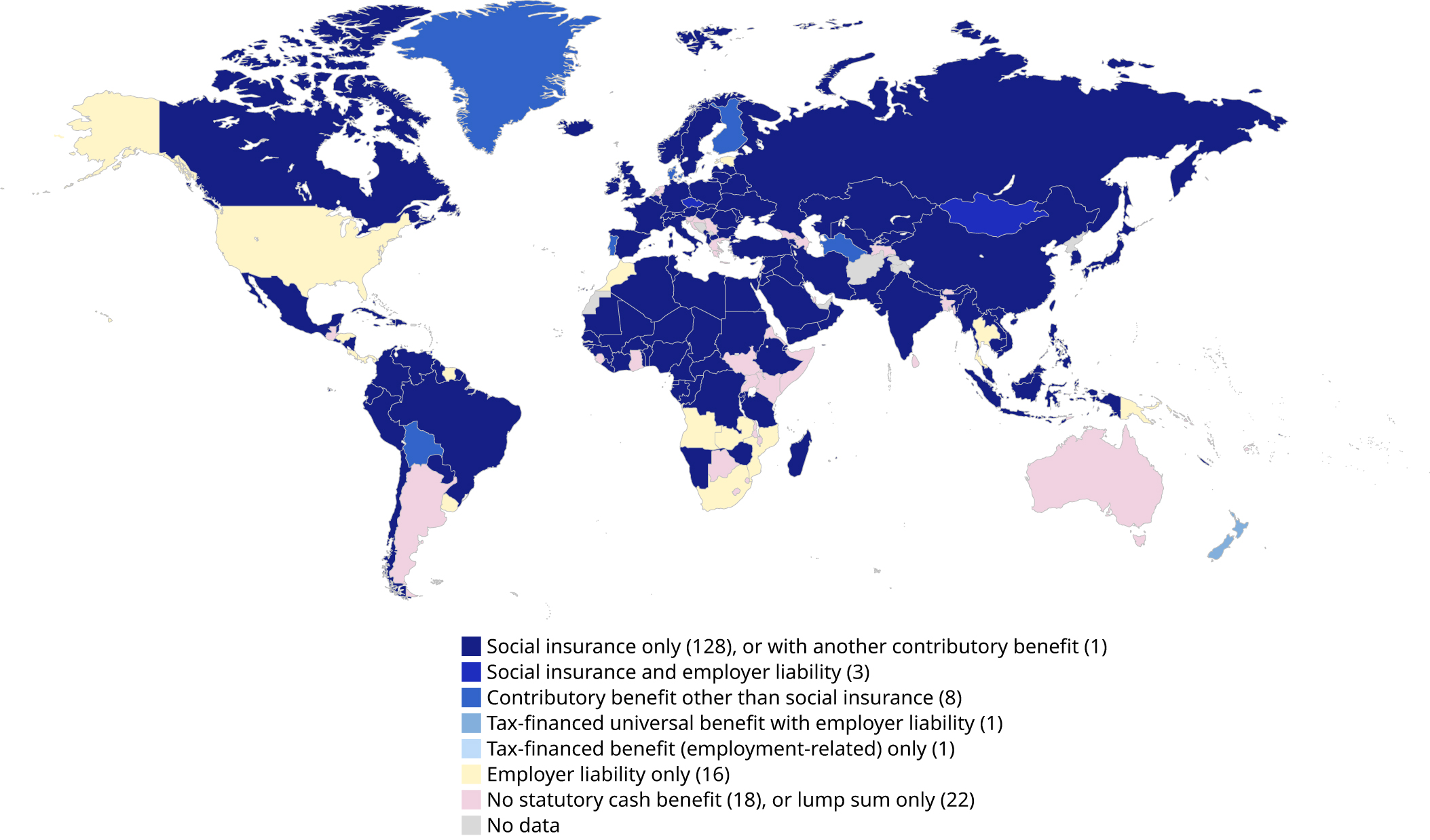
Disclaimer: Boundaries shown do not imply endorsement or acceptance by the ILO. See full ILO disclaimer.
Note: The number between parentheses refers to the count of countries or territories.
Sources: ILO estimates; World Social Protection Database, based on the Social Security Inquiry; ISSA Social Security Programs Throughout the World; ILOSTAT; national sources.
Figure 4.16 Legal coverage for employment injury protection: Share of persons in labour force aged 15 and over covered by cash benefits in case of employment injury, by region, subregion, income level, sex and type of scheme, 2023 or latest available year (percentage)
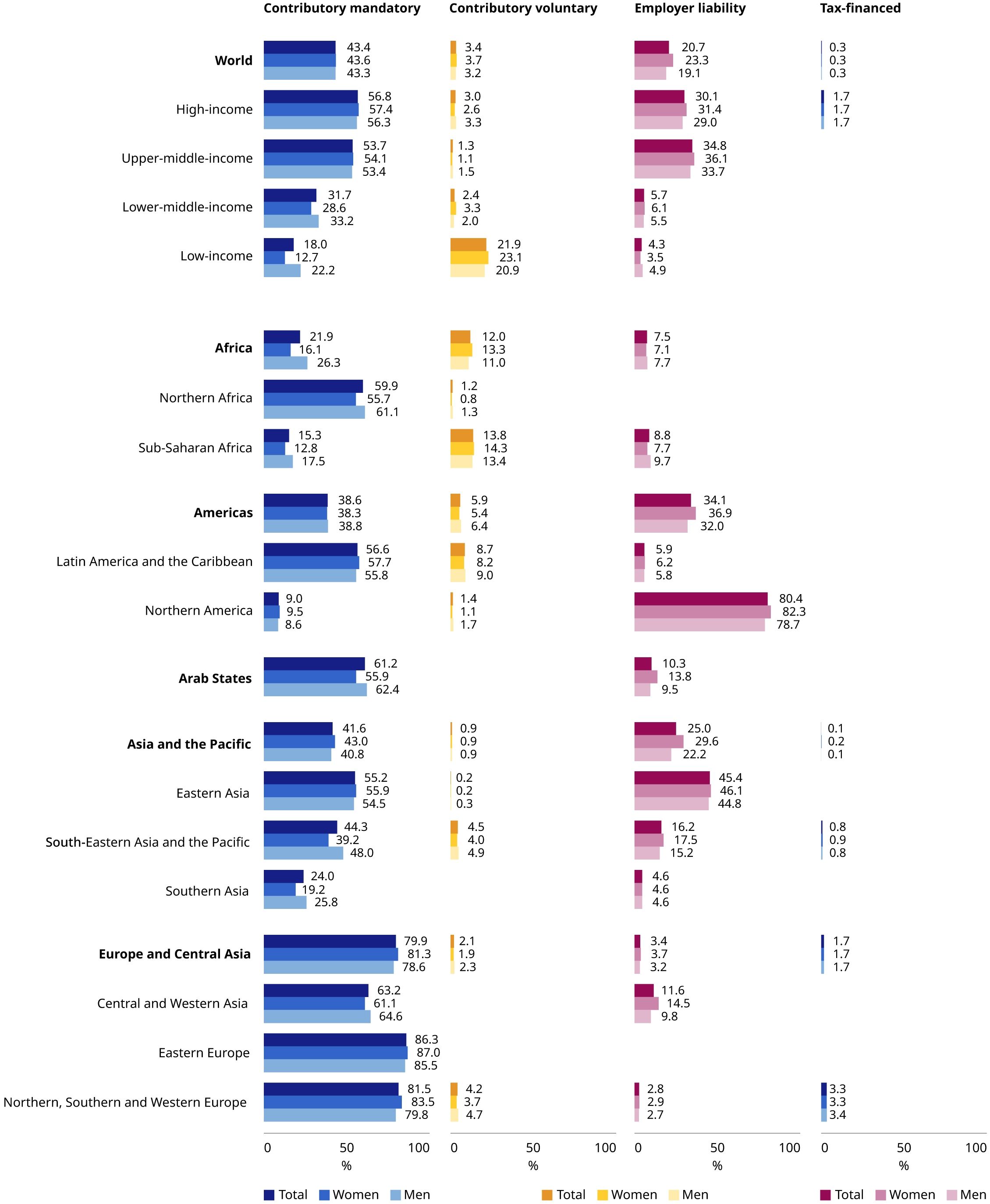
Notes: Global and regional aggregates are weighted by labour force aged 15 and over. Estimates are not strictly comparable to the previous World Social Protection Report due to changes in the methodology.
Sources: ILO estimates; World Social Protection Database, based on the Social Security Inquiry; ISSA Social Security Programs Throughout the World; ILOSTAT; national sources.
Effective coverage
Despite efforts to extend coverage, in many low-and middle-income countries, the number of workers effectively registered in employment injury schemes is much lower than that of workers covered by law (figure 4.17). Effective coverage monitoring at the global level thus far includes only cash benefits. The information for medical and allied benefits is unavailable, and additional efforts are required to collect comparable data at the national and global levels. The low effective coverage in some parts of the world stems from substantial informality, labour and social security inspection mechanisms with low enforcement capacity, low contributory capacity on the part of employers, a lack of understanding of social insurance, a mismatch between benefits and needs, and complex administrative procedures.
Effective coverage figures show that 37.4 per cent of workers globally received benefits in the event of employment injury in 2023. However, there are significant regional disparities. While 79.3 per cent of workers in Europe and Central Asia, and 60.8 per cent in Americas receive benefits, this is the case for only 28.5 per of workers in Asia and the Pacific, 25.7 per cent in the Arab States and 16.5 per cent in Africa. As shown in figure 4.18, effective coverage rates are under 20 per cent in many countries, mainly in Africa and Asia and the Pacific. While the trend is a gradual increase in the effective coverage rate for the world and all regions, it remains modest, with a 4.6 percentage point increase for the world between 2015 and 2023.
Despite low effective coverage in Asia and the Pacific, in the Arab States and in Africa, new employment injury insurance schemes are gradually being introduced. For example, the United Republic of Tanzania introduced an employment injury insurance scheme in 2015 that covered around 6 per cent of the labour force (ILO 2019). Cambodia’s employment injury insurance scheme was first launched in November 2008 to provide coverage for employees in private sector companies employing eight or more workers. Coverage has grown from an initial 327 enterprises in 2008 to 21,430 enterprises and 3.12 million workers, of whom 57.6 per cent are women, in 2024.14
Figure 4.17 SDG indicator 1.3.1 on effective coverage for employment injury protection: Share of persons in labour force aged 15 and over covered by cash benefits in case of employment injury (active contributors), by region, subregion and income level, 2015 and 2023 (percentage)
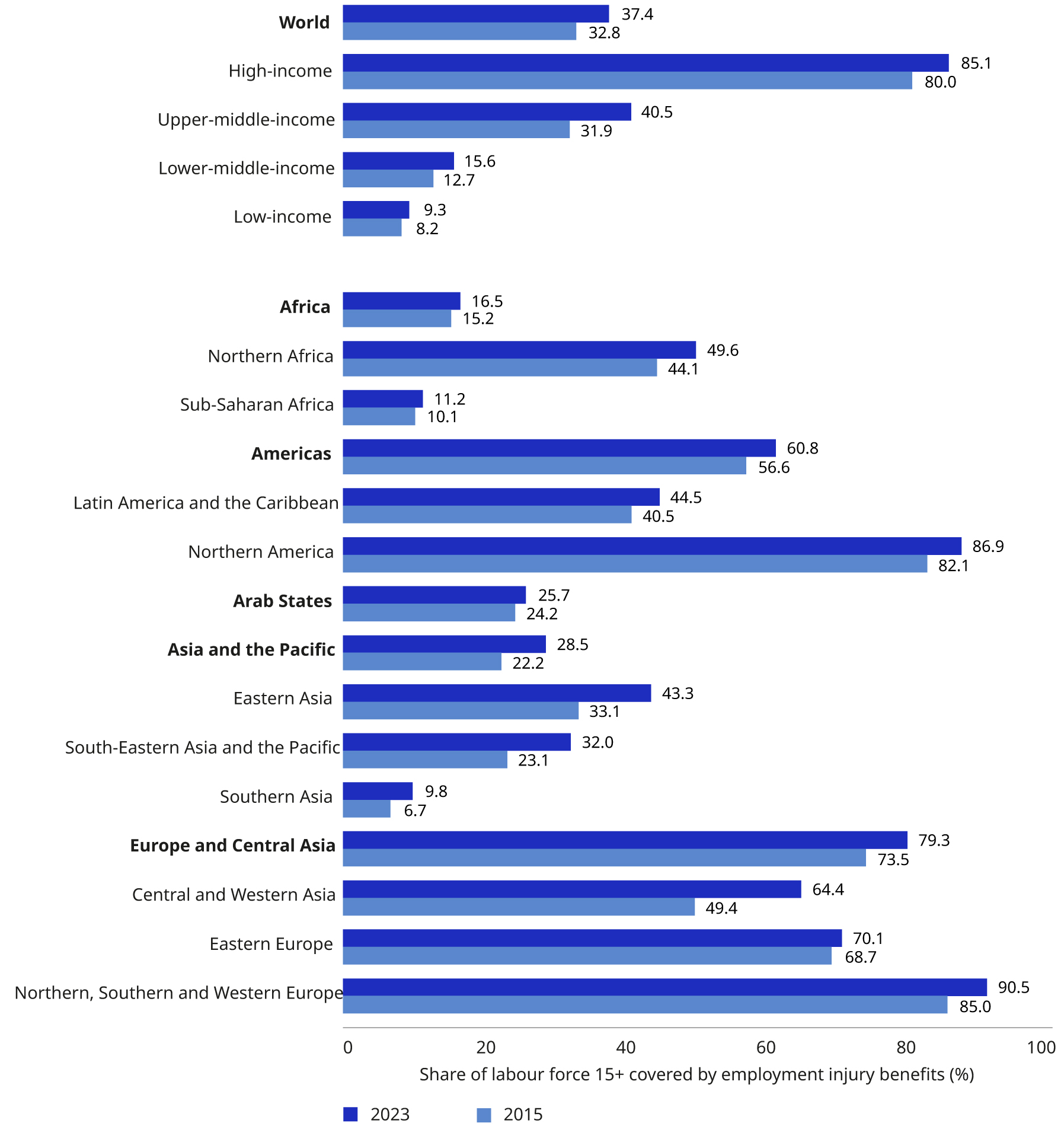
Notes: See Annex 2 for a methodological explanation. Global and regional aggregates are weighted by labour force aged 15 and over. Estimates are not strictly comparable to the previous World Social Protection Report due to methodological enhancements, extended data availability and country revisions.
Sources: ILO modelled estimates, 2024; World Social Protection Database, based on the Social Security Inquiry; ISSA Social Security Programs Throughout the World; ILOSTAT; national sources.
Figure 4.18 SDG indicator 1.3.1 on effective coverage for employment injury protection: Share of persons in labour force aged 15 and over covered by cash benefits in case of employment injury (active contributors), 2023 or latest available year (percentage)

Disclaimer: Boundaries shown do not imply endorsement or acceptance by the ILO. See full ILO disclaimer.
Sources: ILO estimates; World Social Protection Database, based on the Social Security Inquiry; ISSA Social Security Programs Throughout the World; ILOSTAT; national sources.
Adequacy of benefits
Cash benefits of employment injury insurance schemes are usually disbursed in the form of periodic payments, with cost-of-living adjustments for long-term benefits such as permanent disability and survivors’ benefits. Replacement rates, defined as benefits as a percentage of earnings before injury, differ considerably, as shown in figure 4.19. The replacement rates are higher than non–work-related invalidity and survivors’ benefits in many countries and exceed the level stipulated in ILO Conventions Nos 102 and 121.
The interpretation of replacement rates as set out in national legislation requires careful attention. Certain technical aspects of schemes, which may not be explicitly expressed in the legislation, may lead to the substantial erosion of benefits. One example is the ceiling placed on wages to limit insurable earnings, that is, earnings subject to calculations of contributions and benefits. A ceiling which is too infrequently adjusted, and therefore becomes too low, leads to low benefits and contributions, as seen in the Workers’ Compensation Fund in Zambia, although efforts are being made to increase it.15 In many developing countries, the wage ceiling adjustment is not systematically done in line with the average wage increase and requires considerable consensus, as the rise in the ceiling leads to an immediate increase in contributions for employers. Another example is the exclusion of certain benefits from total insurable earnings that the worker receives as part of job remuneration, which also leads to lower benefits and contributions.
Figure 4.19 Replacement rates of employment injury schemes for permanent and temporary disability benefits, selected countries, 2023 or latest available year (percentage)
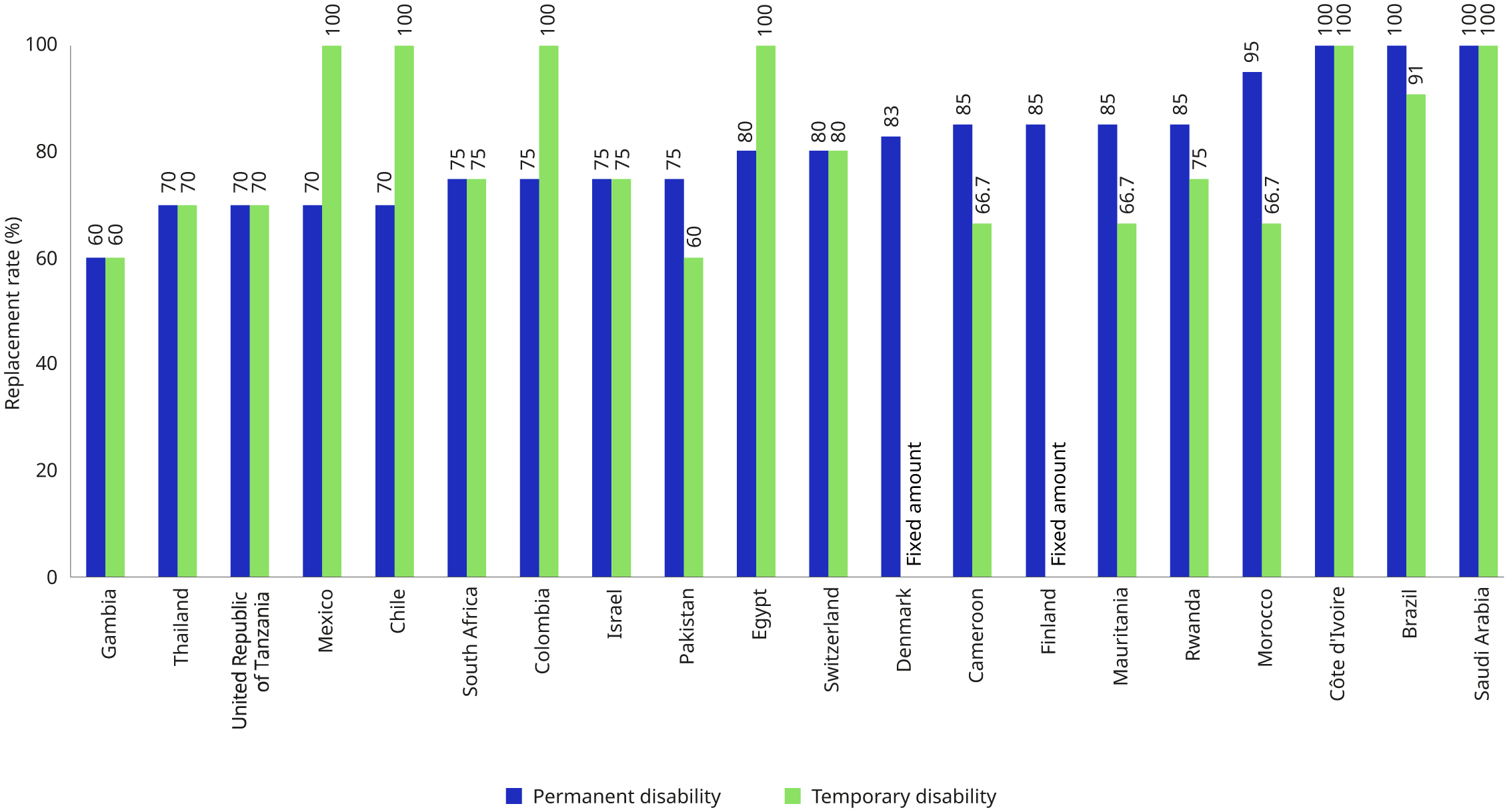
Sources: ILO estimates; World Social Protection Database, based on the Social Security Inquiry; ISSA Social Security Programs Throughout the World; ILOSTAT; national sources.
Recent developments: Extending employment injury insurance
Given that employer liability schemes contain minimal provisions for benefits and services and provide limited protection especially for workers in small and medium-sized enterprises,16 a number of developing countries are keen to establish an employment injury insurance scheme or have recently introduced one. For example, in the United Republic of Tanzania, the Workers’ Compensation Fund was established on 1 July 2015 (ILO 2021q).
While countries in Eastern and South-Eastern Asia – including Japan, Malaysia, the Philippines, the Republic of Korea and Thailand – have a long history of implementing these schemes, they are progressively expanding coverage in cases of employment injury. For example, Malaysia introduced the Self-Employment Social Security Scheme in 2017. Initially, the scheme covered only self-employed workers in the passenger transportation sector, but was extended to 19 other sectors in 2020.17 In order to facilitate the participation of self-employed workers, the Malaysian Government provides contribution subsidies to some categories of workers, financed out of general tax revenues.
In many other countries, efforts are under way to extend protection to workers on digital platforms under social insurance schemes through different approaches (ILO 2022i; 2024e). Countries use a combination of approaches to ensure adequate labour and social protection coverage for these workers. This includes:
-
classifying platform workers as dependent when they actually are, so that the social protection levels for that category of worker become applicable to them;
-
providing a minimum level of social security regardless of the workers’ employment status, which would have to be funded mainly from general taxation;
-
extending contributions and protection against certain contingencies, especially industrial accidents, to these workers; and
-
introducing a responsibility for platforms to pay the social contributions of all workers, whether dependent or self-employed (ILO 2022c, 104).
In many countries, these issues are still under consideration by governments, parliaments and courts.
In the Republic of Korea, since 2008, coverage has been gradually extended to different categories of workers whose work is not based on labour contracts but rather on outsourcing contracts. The employment injury insurance contribution is borne equally by these workers and the business owner (ILO 2022i).
China has also recently started a pilot to cover workers in specific platform companies in several provinces (box 4.9).
Migrant workers form a group that is particularly vulnerable to discrimination, and often find themselves in low-skilled, temporary, seasonal and casual work, frequently in informal employment. They are often excluded from social security coverage because of restrictive legislation and a lack of enforcement, even though the type of work in which they typically engage carries a higher risk of accidents. When migrant workers are included in social security coverage, they often receive lower benefits than those of national workers. In Malaysia, a reform in 2019 included migrant workers in the national employment injury insurance scheme on the same terms as nationals, ending a practice of covering them separately under a special private insurance scheme that provided substantially lower benefits.18
Box 4.9 The occupational injury protection pilot scheme for platform workers in China
|
Recognizing the challenges of occupational safety and health for workers on digital platforms, China launched a public pilot scheme to provide occupational injury protection for platform workers in seven prominent platform companies across seven provinces in 2022. The pilot scheme has achieved substantial progress, covering 6.68 million individuals by September 2023. The pilot scheme aims to protect platform workers who engage in travel, takeaway, instant delivery and same-city freight transport services. Platform enterprises contribute a flat-rate amount for each order to a separate account under the Employment Injury Insurance Fund, while workers do not make any contributions. The scheme provides workers with a range of benefits, including medical treatment, disability and death benefits in the case of occupational injuries. The pilot scheme protects workers engaged with these platforms. Yet, there are some challenges. As the overall risk of the insured population is higher than that of other workers, the flat-rate contributions may not fully reflect the varying levels of risk associated with diverse types of platform work, raising concerns about the longer-term financial sustainability of the pilot scheme. |
Source: Based on
Such reforms are key to enhance protection and reduce vulnerability and informality. Further efforts in ensuring employment injury protection of vulnerable groups will help to achieve SDG target 1. 3. In the context of rapid climate change, more effort should be made to reduce work-related injuries and diseases. Employment injury schemes can contribute to improving safety and health at work through financial allocations of some part of their contributions and coordination of recording and reporting of data on work-related injuries and diseases.
Considering the important function of an employment injury insurance scheme as an automatic stabilizer of workers’ health and well-being, it is essential to accelerate the extension of social security coverage, including employment injury protection, in the face of increasing risks of injuries and ill health due to climate change. Vulnerable workers and their families are more prone to heightened risks of injuries and ill health – for example, those working in the agriculture and construction sites exposed to sunshine and ultraviolet radiation for long hours in more risk-affected geographic areas, such as in Asia and Africa. Extending effective coverage to them is therefore essential.
4.2.5 Disability benefits and other measures to promote the full and effective inclusion of persons with disabilities
Key messages
-
As climate change increases the vulnerability of persons with disabilities, ensuring that social protection systems provide adequate services and benefits to ensure the full and effective inclusion of persons with disabilities becomes even more challenging.
-
Strong social protection systems for persons with disabilities: (a) ensure access to adequate benefits and services; (b) provide income security and coverage of disability-related extra costs across the life cycle regardless of employment status; (c) have participatory and inclusive policy formulation and implementation mechanisms; and (d) ensure access to needed healthcare, rehabilitation and assistive devices.
-
Despite some progress, coverage of disability benefits remains low. Worldwide, only 38.9 per cent of persons with severe disabilities receive a disability benefit, with great variations across countries and regions, ranging from 8.1 per cent in Africa and 30.7 per cent in Asia to 74.2 per cent in the Americas and 91.5 per cent in Europe and Central Asia.
-
In addition, the social protection benefits and services to which persons with disabilities have access are insufficient to meet their diversity of needs. In particular, in addition to ensuring income security, most societies struggle to develop quality, accessible and affordable care and support services that respect the rights, dignity and needs of both those who receive and those who provide it.
-
The global mortality rate of persons with disabilities during disasters is estimated to be four times higher than for the rest of the population. Disasters disrupt access to health and support services and emergency response measures – including social protection benefits – and are often not sufficiently tailored to accommodate their difficulties to move, communicate, hear and see.
-
It is crucial to hear the diverse voices of persons with disabilities as well as ensure meaningful participation for the organizations of persons with disabilities to design inclusive social protection systems, address additional emerging challenges and make just transition measures inclusive of persons with disabilities.
Social protection systems to ensure the four core functions for persons with disabilities
Social protection benefits and services play a crucial role in facilitating a fairer green transition for persons with disabilities and promoting their empowerment and participation in economic, social, political and cultural life in general. To this end, social protection schemes need to ensure access for persons with disabilities to both mainstream and disability-specific schemes, fulfilling the following core functions: (a) income security and adequate standards of living; (b) effective access to healthcare and financial protection (coverage of healthcare costs), including early intervention, rehabilitation and assistive devices; (c) coverage of disability-related costs, including access to support services; and (iv) facilitated access to early childhood development, education and economic empowerment programmes (UNICEF and ILO 2024).
Persons with disabilities often face marginalization and experience higher levels of poverty, limited economic opportunities and limited participation in society, along with fewer educational opportunities (UN 2019a). They also incur additional costs related to their disabilities, such as for care and support, increased healthcare services, transportation and other daily activities. Moreover, persons with disabilities frequently encounter discrimination and exclusion. Women and girls with disabilities face additional challenges compared to women and men without disabilities and men and boys with disabilities.
Recent societal changes, including those brought about by climate change, further intensify the challenges faced by persons with disabilities. Droughts, extreme heat, rainfall volatility, landslides, water shortages and air pollution can greatly impact their lives, their health and their ability to access needed health and support services. Heat extremes are linked with elevated emergency room visits, hospital admissions and mortality for individuals with mental health, cardiorespiratory and other disabilities. In addition, pre-existing psychosocial disabilities triple the risk of death during heatwaves (Stein and Stein 2022).
Moreover, economic losses from climate change make it more difficult for persons with disabilities to find work, and they are more likely to be laid off (Hasan 2019). Persons with disabilities are still under-represented in the emerging clean industry, while their pre-existing jobs have already been impacted by climate change. For example, in the Pacific Islands, many persons with disabilities who worked in the fishing industry are unable to continue due to difficulties in adapting to the new climatic conditions (Kelly-Costello 2023).
Extreme weather conditions can also affect the mobility of persons with disabilities, increase the risk of accidents and contribute to a loss of accessibility (such as the destruction of wheelchair ramps, elevators or even extensive damage to infrastructure, which can take years or decades to repair), or serious damage to their assistive devices (ILO and Fundación ONCE 2023). Extreme weather events have also been shown to increase the incidence and prevalence of disability (ILO and Fundación ONCE 2023).
Despite these challenges, the participation of persons with disabilities in policymaking remains limited, and more data and evidence should be generated regarding these intersectional issues. Their representation in climate change policies in particular is minimal. As a result of this, only 39 out of 195 parties to the Paris Agreement make some reference to persons with disabilities in their nationally determined contributions, and only 15 parties include concrete measures for disability inclusion in their nationally determined contributions (IDA and IDDC 2023).
In light of these intensified challenges, it has become even more important to realize the human right to social security for persons with disabilities (box 4.10).
Box 4.10 The international normative framework for the right to social security for persons with disabilities
|
The international normative framework has progressively elaborated the right to social security of persons with disabilities and the obligations of States to secure this right in ways that foster access to socio-economic participation on an equal basis with others. The 2006 United Nations Convention on the Rights of Persons with Disabilities emphasizes the critical role of social protection in supporting the full and effective participation and inclusion of people with disabilities across the life cycle. The Convention on the Rights of Persons with Disabilities sets out the obligations of States parties to:
International social security standards complement this framework. ILO Convention No. 102 (Part IX) sets minimum standards for the provision of income security in relation to disability (see annex table A3.8). Furthermore, the Invalidity, Old-Age and Survivors’ Benefits Convention, 1967 (No. 128), in Article 13(1), sets higher standards for disability benefit schemes, including the provision of rehabilitation services to enable persons with disabilities either to resume their employment or to perform another activity suited to their aptitudes. Its accompanying Recommendation No. 131 (Para. 5), broadens the definition of the contingencies that should be covered under national schemes by including partial disability, which should give rise to a reduced benefit. This is complemented by the Employment Injury Benefits Convention, 1964 (No. 121), which stipulates the provision of additional benefits for people requiring constant support by a third person. Although medical care, including medical rehabilitation, is dealt with under separate provisions in Convention No. 102 (Part II), the Medical Care and Sickness Benefits Convention, 1969 (No. 130), expands the provision of required medical care and rehabilitation, including access to assistive devices, that should be “afforded with a view to maintaining, restoring or improving [their] health … and [their] ability to work and to attend to [their] personal needs” (Art. 9). ILO Recommendation No. 202 puts forward an integrated and comprehensive approach to social protection, according to which persons with disabilities should enjoy the same guarantees of basic income security and access to essential healthcare as other members of society through national social protection floors. In addition, the Recommendation requires that social protection systems be designed in line with the principles of non-discrimination, gender equality and responsiveness to special needs, as well as respect for the rights and dignity of people covered by the social security guarantees. |
Types of disability benefit schemes
Countries deploy a diversity of schemes and measures to support persons with disabilities, including contributory (mainly social insurance) and non-contributory (usually tax-financed) cash and in-kind benefits, subsidies or tax reliefs. In-kind benefits or concessions include free or subsidized access to healthcare, public transport, housing, utilities, and care and support services. Combining different schemes will facilitate the coverage of all persons with disabilities, regardless of their employment status, contributory history, poverty status or other characteristics.
Worldwide, 176 countries and territories provide statutory disability cash benefits, of which 153 have a social insurance scheme. Of these, 84 have a social insurance scheme only, whereas 69 combine social insurance with a non-contributory universal scheme (7), a means-tested tax-financed benefit (52), both (5), or with another type of contributory scheme (5). Twelve countries have only tax-financed schemes, either universal (4), means-tested (6) or both (2). Sixteen countries do not provide any periodic cash benefit, of which 11 provide lump sum benefits (see figure 4.20).
Effective and legal coverage of cash benefits of persons with disabilities
Population coverage of disability benefits, like for other contingencies, has gradually increased since 2015, with accelerated growth during the COVID-19 pandemic in 2021–22. However, many were only temporary measures. Worldwide, effective coverage for persons with severe disabilities increased by 6 percentage points, from 32.8 to 38.9 per cent. Asia stands out as experiencing the highest increase, in particular Eastern and Southern Asia, where coverage increased by around 13 percentage points to 44.7 and 19.2 per cent, respectively (figure 4.21). Overall, inequalities remain significant across regions and income levels, with 3.3 per cent and 19 per cent of persons with severe disabilities in low-and lower-middle-income countries, respectively, receiving a benefit, compared to 50 and 85.6 per cent in upper-middle and high-income countries, respectively. In line with the income distribution, figure 4.22 illustrates that Europe, Northern America, parts of Latin America and Asia achieve high coverage rates whereas other parts of Latin America, Southern Asia and most of Africa have coverage rates below 20 per cent.
Figure 4.20 Disability protection (periodic cash benefits) anchored in law, by type of scheme, 2023 or latest available year
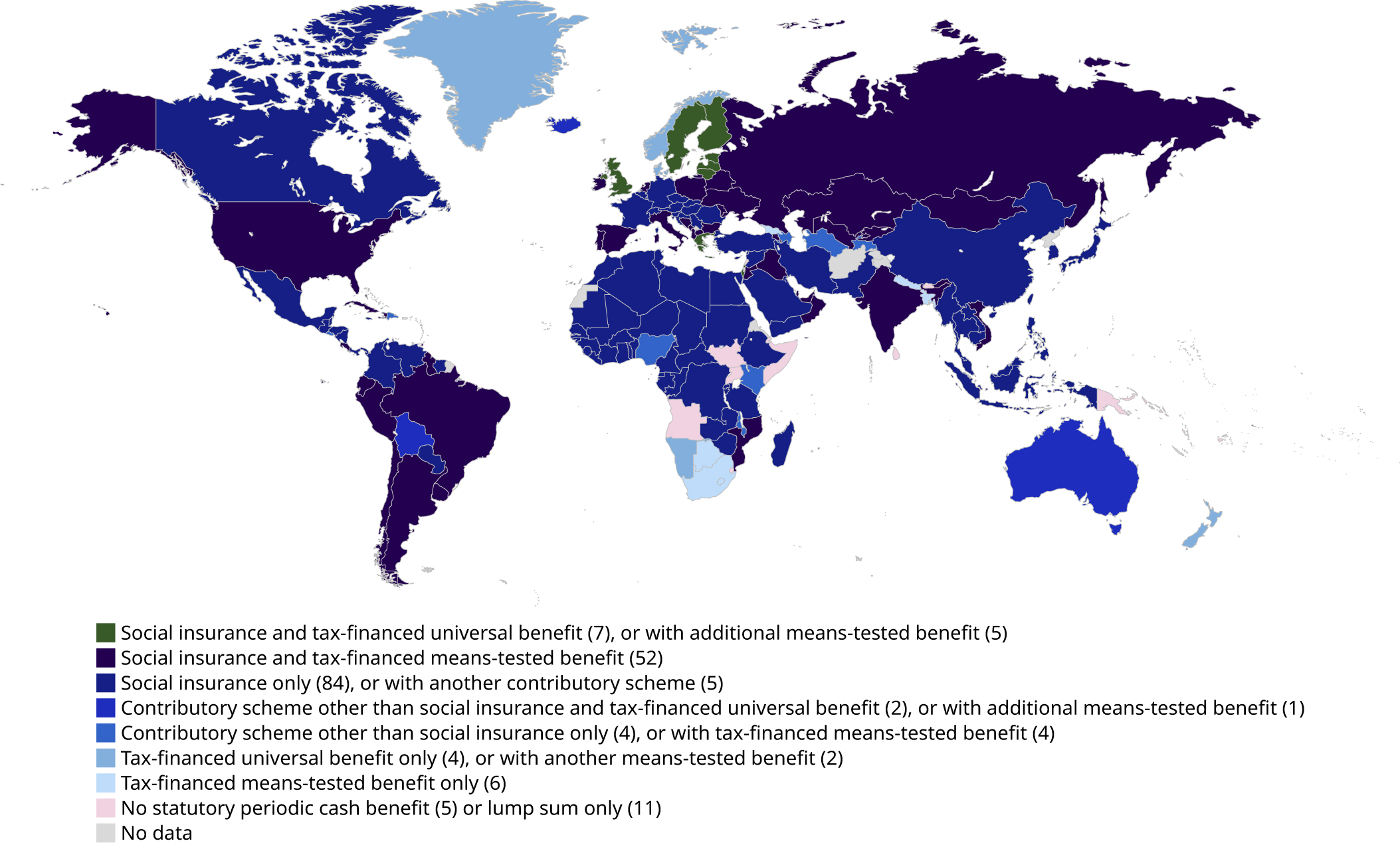
Disclaimer: Boundaries shown do not imply endorsement or acceptance by the ILO. See full ILO disclaimer.
Note: The number between parentheses refers to the count of countries or territories.
Sources: ILO estimates; World Social Protection Database, based on the Social Security Inquiry; ISSA Social Security Programs Throughout the World; ILOSTAT; national sources.
Figure 4.21 SDG indicator 1.3.1 on effective coverage for disability protection: Share of persons with severe disabilities receiving cash benefits, by region, subregion and income level, 2015 and 2023 (percentage)
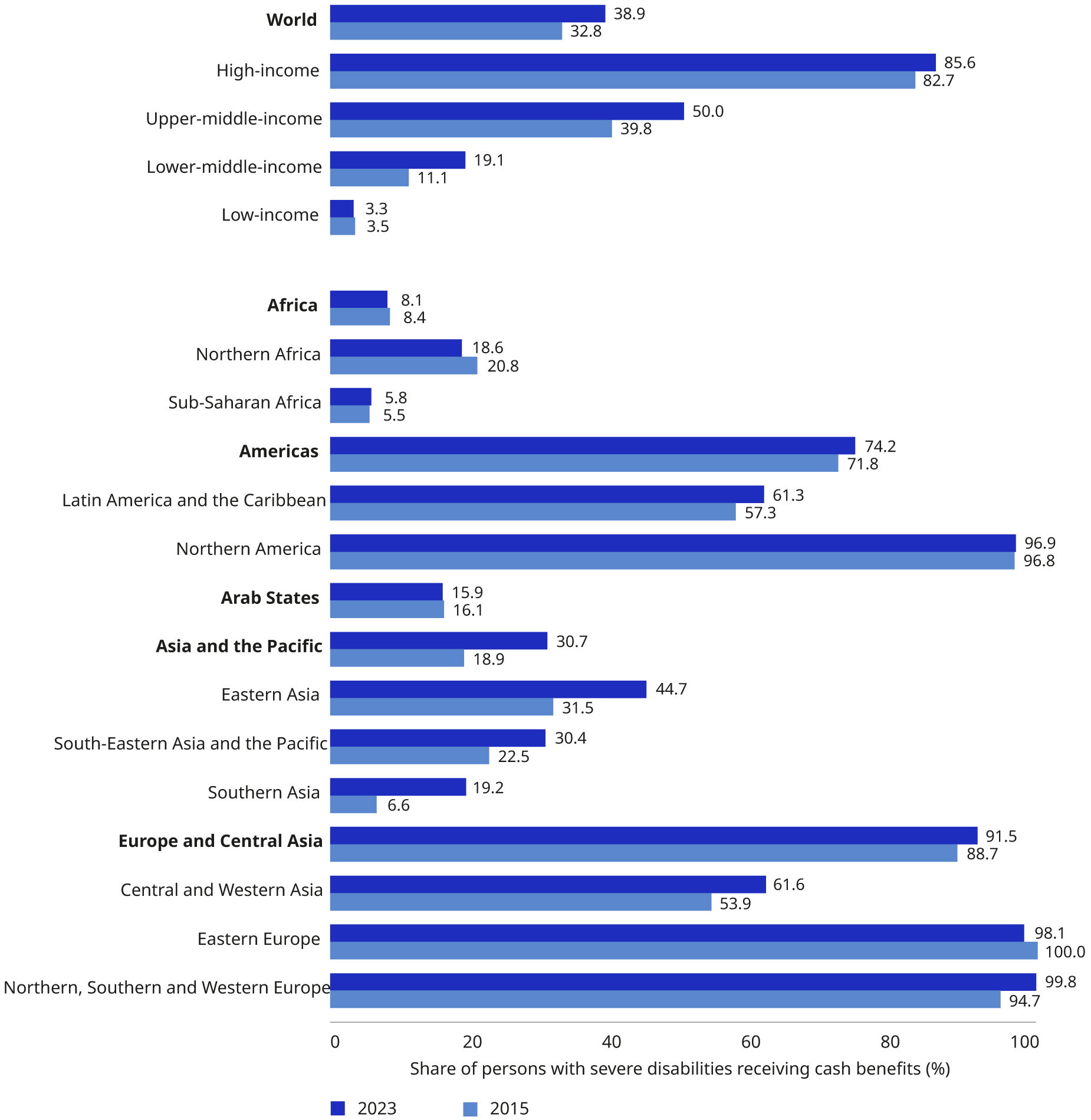
Notes: See Annex 2 for a methodological explanation. Global and regional aggregates are weighted by population. Estimates are not strictly comparable to the previous World Social Protection Report due to methodological enhancements, extended data availability and country revisions.
Sources: ILO estimates; World Social Protection Database, based on the Social Security Inquiry; ISSA Social Security Programs Throughout the World; ILOSTAT; national sources.
Figure 4.22 SDG indicator 1.3.1 on effective coverage for disability protection: Share of persons with severe disabilities receiving cash benefits, 2023 or latest available year (percentage)
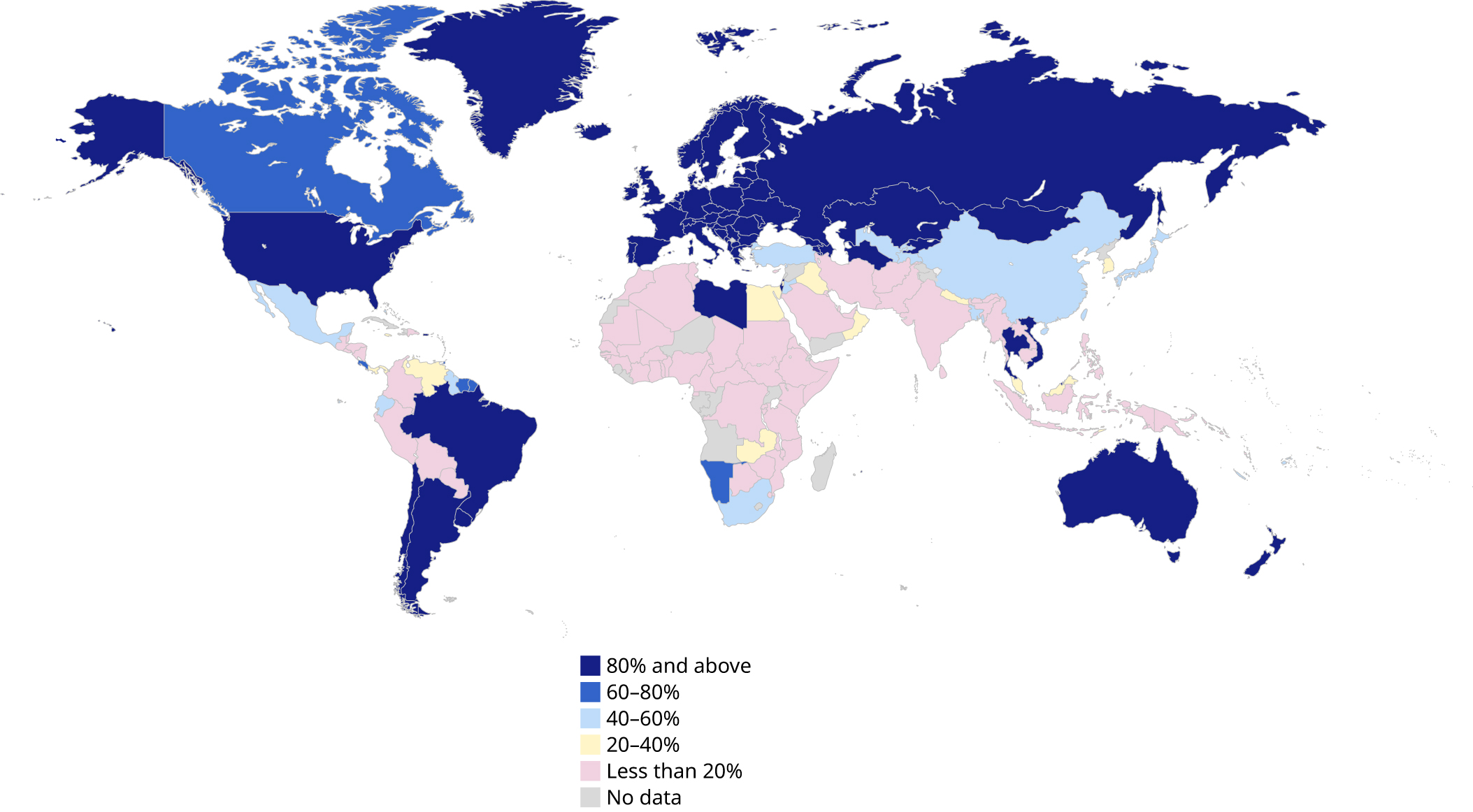
Disclaimer: Boundaries shown do not imply endorsement or acceptance by the ILO. See full ILO disclaimer.
Sources: ILO estimates; World Social Protection Database, based on the Social Security Inquiry; ISSA Social Security Programs Throughout the World; ILOSTAT; national sources.
Figure 4.23 shows the share of the working age population legally entitled to a social protection benefit in case they have or acquire a disability as a share of the total working age population for different regions and income levels. Non-contributory schemes are most common in Europe and Central Asia, and in upper-middle-income countries, providing legal coverage for 67.0 per cent and 71.8 per cent of the working-age population, respectively. For Eastern Europe, this figure is just below 90 per cent. Similarly, high-income countries and Europe and Central Asia have legal coverage rates for mandatory social insurance or occupational schemes at 57.6 and 55.7 per cent, respectively. In upper-middle-income countries, this is at 56.6 per cent, compared to legal coverage rates in low-income countries of only 17.6 per cent. In sub-Saharan Africa, legal coverage stands at 11 per cent for non-contributory schemes and just below 24.1 per cent for mandatory contributory schemes, complemented with 19.5 per cent legal coverage for voluntary schemes . Mozambique stands out as the only low-income country with a non -contributor y disability benefit scheme. Bangladesh, the Plurinational State of Bolivia, Eswatini, Haiti, India, Kenya, Kiribati, Kyrgyzstan, Lesotho, Mongolia, Mozambique, Nepal, Samoa, Tajikistan and Ukraine have universal tax-financed schemes.
Legal coverage for voluntary schemes overall is lowest, and experience shows that, due to competing demands on household budgets, the take-up is typically very low. Overall, the data shows that countries and regions with low effective coverage often also have gaps in legal coverage. Countries need (a) effective enforcement and implementation mechanisms to ensure that individuals can realize their entitlements and (b) a legal framework that is inclusive and does not create barriers for extending social protection.
Figure 4.23 Legal coverage for disability protection: Share of the working-age population aged 15 and over covered by disability cash benefits, by region, subregion, income level, sex and type of scheme, 2023 or latest available year (percentage)
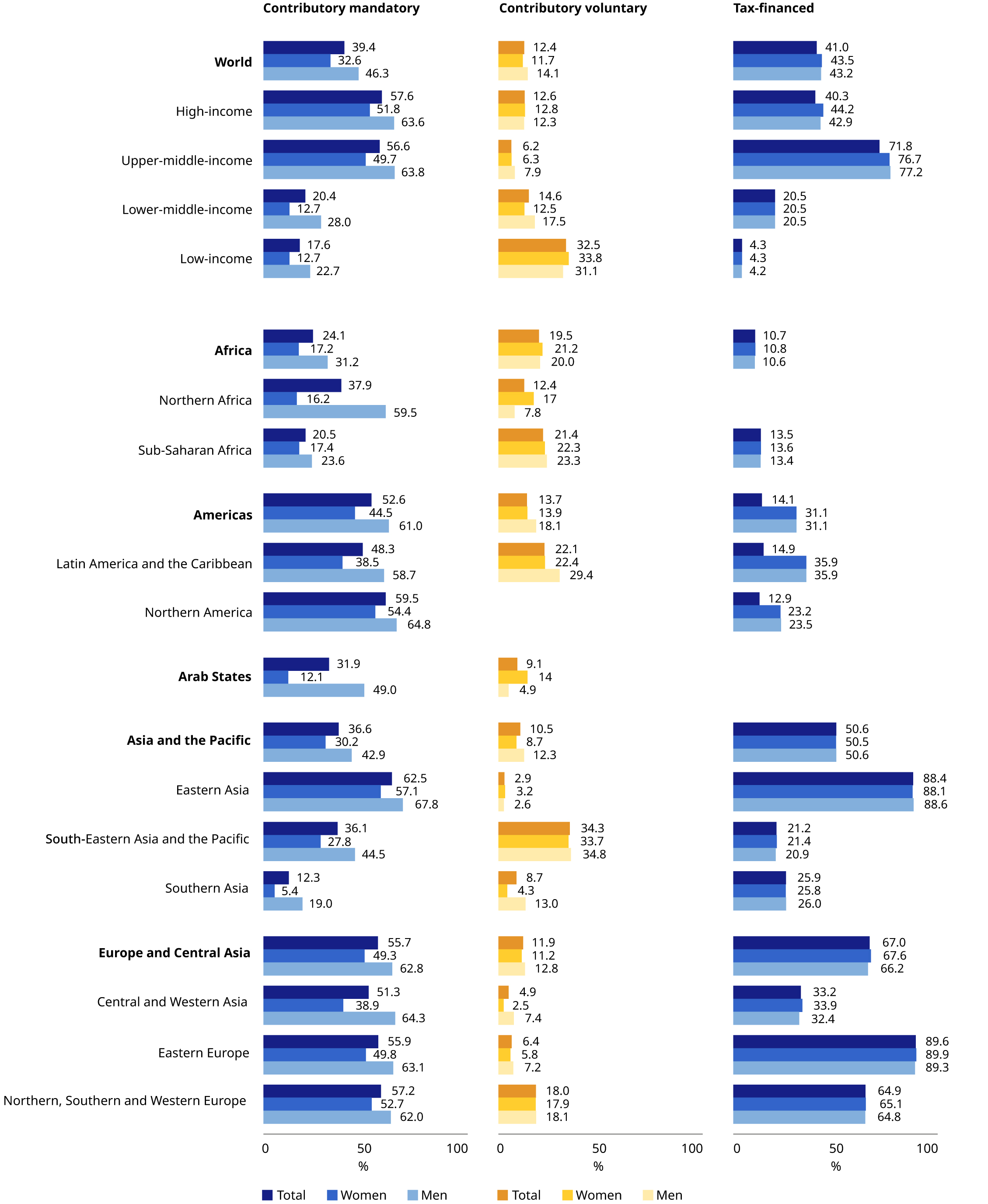
Note: Global and regional aggregates are weighted by working-age population 15 and over. Estimates are not strictly comparable to the previous World Social Protection Report due to changes in the methodology.
Sources: ILO estimates; World Social Protection Database, based on the Social Security Inquiry; ISSA Social Security Programs Throughout the World; ILOSTAT; national sources.
Adequacy of benefits and expenditure
Social protection schemes should guarantee effective access to at least essential healthcare and basic income security that allow for a healthy and dignified life (Recommendation No. 202 and Convention No. 102). Unfortunately, evidence suggests that many countries do not provide benefit levels to meet the aspiration of income security, and even fewer cover disability-related extra costs. ILO Convention No. 102 sets out that schemes should provide, as a minimum, a replacement rate of 40 per cent for those who have contributed for at least 15 years. A recent ILO analysis of 343 statutory disability benefit schemes worldwide found that, out of 101 contributory schemes that pay benefits based on previous earnings and contribution history, 62 schemes (61 per cent) provide a replacement rate of 40 per cent or more after 15 years of contributions (ILO 2024b). Benefit levels of schemes providing flat-rate amounts on average reached 17.6 per cent of GDP per capita. In 54 countries for which minimum wage data were available, 19 schemes provided benefit levels of at least 40 per cent of the country’s minimum wage. Moreover, 17 out of 28 schemes paid benefits exceeding the national poverty line. Adequacy gaps are particularly evident in low-income, lower-middle-income and upper-middle-income countries, where also expenditure gaps on disability benefits are largest. Public spending levels in these countries stand at 0.1 per cent of GDP, in contrast to high-income countries that invest 1.95 of their GDP (ILO 2024b).
Pathways to designing social protection systems that promote participation and empowerment
Depending on the current situation, legacy systems and existing schemes and programmes in place, countries will adopt different pathways to extend social protection coverage for persons with disabilities. For example, poverty-targeted social assistance schemes can (a) introduce disability as an eligibility criterion and set higher eligibility thresholds for these households, and (b) increase the value of the benefits for persons with disabilities. Universal disability benefits and third-person support can be considered in addition to the social assistance benefits to cover disability-related costs. To maximize impact, the focus should shift from targeting households to supporting individuals. Some countries have recently established disability social protection schemes with very inclusive design, such as Lebanon and Oman (see box 4.11).
Box 4.11 Introduction of new disability benefits in Lebanon and Oman
|
In April 2023, Lebanon launched a national disability allowance, which supports nationals and refugees with disabilities in facing the extra cost of disability and facilitates their access to key services. Eligibility is assessed based on a personal disability card issued by the Ministry of Social Affairs, through its Rights and Access Programme and Information System. The system includes a database of personal disability card holders. While all persons with disabilities would ultimately be eligible to receive the national disability allowance, young adults aged 18 to 28 (born between 1995 and 2005) are prioritized during the first roll-out to support them in their transition to higher education or to join the labour market through a monthly allowance of US$40 (ILO 2023t). Oman established a universal disability benefit scheme in 2023 as part of its new Social Protection Law (Royal Decree No. 52/2023). This universal disability benefit ensures a minimum income level of 130 Omani rials (around US$340) per month for all persons with disabilities, including children. This value is reviewed regularly through studies of benefit adequacy. Employment status is not taken into consideration for determining eligibility, which allows persons with disabilities to access the labour market while covering their disability-related costs (ILO 2023i). |
Meaningful participation of organizations of persons with disabilities necessary for a just green transition
Social protection systems can provide important support for persons with disabilities, including by addressing the widened gaps caused by climate-related and other environmental crises.
In all efforts to build inclusive social protection systems, it is important to include a diverse range of voices from the disability community (Jodoin et al. 2023). Meaningful participation involving organizations of persons with disabilities and their leadership is crucial in ensuring effective scheme design, disaster response planning for emergencies and evacuations, and humanitarian emergency responses. Their voices should be considered in the reform of social protection schemes to make them more inclusive of persons with disabilities. Yet, there is little literature and data regarding the effect of a just a transition for persons with disabilities (OHCHR 2020). Reflecting their voices and creating stronger social protection systems will develop more resilient societies. Governments should include disability organizations as stakeholders to ensure disability-inclusive health adaptation planning. The disability constituency also needs to be better represented within the United Nations Framework Convention on Climate Change, both in the discussion on climate adaptation and climate mitigation.
Inclusive design of schemes
The way eligibility criteria are defined has an important influence on population coverage. This includes, for example, taking into account the required number of years of contribution, age and severity of disability, and sometimes also means tests. Regarding the number of contribution years, the minimum required contribution period for individuals in the labour force should be three years according to Convention No. 102. Out of 293 schemes, 26 do not require any minimum contributory period and cover workers as of day one; and half of the 158 schemes that specify a minimum period of contributions of three years or less. Yet, the other half exceed the threshold, especially in low-and lower-middle-income countries. On average, 4.15 years are required (ILO 2024b).
The severity of disability can be another eligibility criterion, with 105 out of 343 schemes requiring a total or permanent (100 per cent) disability, while other schemes also acknowledge partial disability, defining a certain required percentage, on average 55.1 per cent with a median of 61 per cent (ILO 2024b).
Box 4.12 Brazil’s Benefício de Prestação Continuada reformed to be compatible with employment
|
In Brazil, the non-contributory, means-tested disability benefit known as the Benefício de Prestação Continuada did not initially extend to employed persons with disabilities. Since 2015, the Auxílio-inclusão (Inclusion Aid) system, established under section 94 of Law No. 13.146, created a monetary incentive for the labour market inclusion of recipients of the benefit with disabilities. Since 2021, these individuals can receive 50 per cent of the Benefício de Prestação Continuada if they are engaged in paid employment. This benefit is not counted as household income and therefore is not taken into account in the means test (Government of Brazil 2023a; Guerreiro Osório 2022). |
A related important design feature is the compatibility of the benefits with work. Many schemes have an incapacity-to-work requirement, which often effectively excludes persons with disabilities of working age from the labour market, or prevents them from receiving benefits when taking up employment. Out of 164 schemes with an incapacity-to-work requirement, 111 stipulate a complete inability to work and 153 some level of incapacity to work. If benefits are compatible with work, this can allow for some disability-related costs to be covered. For example, Kyrgyzstan defines different categories of disabilities, depending on the capacity to work, associated with different levels of disability benefits irrespective of employment status (ILO 2024b). Brazil had originally excluded employed persons with disabilities from the disability benefit, but then reformed the scheme to make it compatible with work (see box 4.12).
Furthermore, disability benefit schemes are often not compatible with other social protection benefits, in particular old-age pensions. Instead, disability benefits are usually converted into old-age pensions upon reaching retirement age. Despite the extra costs entailed when people develop functional impairments in old age, these costs are often not covered and old-age pensions are paid at the same level, irrespective of disabilities in old age. Some countries, such as Germany19 and Japan,20 have also introduced specific long-term care social insurance schemes, while other countries provide additional benefits or services for older persons with disabilities, such as the disability top-up pension in Azerbaijan,21 which persons with disabilities are eligible to receive in addition to their old-age pension.
Another eligibility criterion is age. As noted above, there is often an upper age limit for disability-specific benefits. Also, schemes tend to focus on the working-age population, with only few schemes covering children with disabilities, despite the extra costs families that face in supporting children with disabilities.
Many countries target disability benefits at poor households (figure 4.21), which can create exclusion errors and poverty traps. Providing assistive devices, rehabilitation and/or care and support services to persons with disabilities irrespective of income or poverty status is essential for enabling their inclusion.
In addition to providing affordable services, quality services need to be accessible and acceptable. Recognizing that family members, often women, provide a large share part of care and support for persons with disabilities (often on an unpaid basis), some disability benefit schemes include a constant-attendance supplement (68 out of 343 schemes) or a dependent supplement (34 out of 343 schemes) (ILO 2024b), compensating unpaid carers for the opportunity costs of providing unpaid care.
Overall, quality and inclusive public infrastructure and services such as water, transportation, electricity, information, education and health are essential to facilitate inclusion. Ensuring more inclusive public infrastructure and minimizing barriers in the environment decrease support needs and costs and increase the autonomy of persons with disabilities.
Inclusive delivery mechanisms
Creating a robust social protection system enables persons with disabilities to master societal transitions and crisis management. For instance, a disability allowance and a disability registry can be built on for additional support during crises. The existing disability registry can provide important information regarding the special needs of persons with disabilities in order to implement inclusive economic restructuring policies and emergency relief operations.
Accessibility throughout the delivery chain of social protection benefits and services should be ensured at all times to effectively deliver disability benefits: from information dissemination, registration and contribution collection as applicable, to enrolment, benefit delivery and complaint procedures. In the information dissemination phase, the information should be conveyed in a way that is understandable to all persons with different types of disabilities. Simplifying the registration process and minimizing the need for travel are both crucial. Online on-demand registration or payment modalities can be more accessible if they are designed for inclusion and supported by in-person support if needed. Throughout the delivery chain, it is important to ensure sensitivity training among all officers involved in these steps. Disability populations sometimes face stigma and are treated in a discriminatory manner by staff who should serve them.
Ensuring business continuity across the delivery chain also in times of emergency can be a matter of life or death for persons with disabilities. Its salience is tragically manifested by the significantly higher mortality rates of persons with disabilities during disasters, which is estimated to be four times higher than for the rest of the population.
4.2.6 Unemployment protection as an integrated approach
Key messages
-
Globally, 93 countries and territories have implemented unemployment protection schemes, primarily through social insurance schemes, although some rely on tax-financed mechanisms.
-
In response to the job crisis triggered by the COVID-19 pandemic, many countries conducted social dialogue to design or reform their unemployment protection schemes. Since 2020, an additional five countries and territories have enacted legislation to establish such schemes. However, progress in adopting and improving unemployment protection schemes has slowed down as unemployment rates returned to pre-pandemic level.
-
Effective coverage by unemployment protection schemes remains limited, with only 16.7 per cent of the global unemployed receiving benefits, and with significant regional disparities. Youth, self-employed workers, digital platforms workers, and agricultural and migrant workers often lack any forms of unemployment protection when they lose their jobs or earnings.
-
Furthermore, many existing schemes are not prepared to tackle climate-related challenges. There is an urgent need to expand unemployment protection, including through tax-financed mechanisms, and ensure benefits work in conjunction with active labour market policies. This integration will enable unemployment protection to respond to immediate climate shocks and support labour market and livelihood shifts in the context of a just transition.
The need for more effective unemployment protection for a just transition
The transition to environmentally sustainable economies will displace and destroy jobs and livelihoods, while also creating new opportunities (Montt, Fraga and Harsdorff 2018; ILO 2024k; 2023s). Realizing the positive social and economic outputs of this transition requires deliberate policy coordination between social protection, skills and active labour market policies, while ensuring the coherence of economic and environmental policies (Bischler et al. forthcoming). Integrated unemployment protection systems covering all workers (see box 4.13) are pivotal for ensuring this coherence and smooth labour market transition in the context of climate action. Despite rapid and effective deployment of full or partial unemployment benefits and other job or income protection measures during the COVID-19 pandemic, most of these interventions were discontinued and the agenda lost traction once unemployment rates returned to pre-pandemic level. Sustainable and statutory unemployment protection programmes are more likely to be introduced in non-crisis contexts (Peyron Bista and Carter 2017).
Legal coverage and type of unemployment protection schemes
Globally, 43.0 per cent of the labour force is legally covered in case of job or earnings losses through contributory (either mandatory or voluntary social insurance), while 5.2 per cent is legally covered through tax-financed schemes (unemployment assistance, social assistance or others), anchored in national legislation (figure 4.24).22 While high-income and upper-middle-income countries enjoy relatively high levels of mandatory coverage (80 and 50.7 per cent of the labour force, respectively), only one in four workers is protected in lower-middle-income countries and none in low-income countries. Social insurance remains the predominant mechanism for unemployment, yet the effectiveness of its coverage is hindered by significant informal and self-employment in low-and middle-income countries. In high-income and upper-middle-income countries, female workers typically experience slightly higher legal unemployment coverage.
Box 4.13 The right to unemployment protection, not only for employees in the formal sector
|
Unemployment protection policies aim to promote full and productive employment and provide income security to those unable to find suitable employment. Recognized as a human right, as well as a social and economic right, unemployment protection is enshrined in various international instruments, such as the Universal Declaration of Human Rights, 1948, and the International Covenant on Economic, Social and Cultural Rights, 1966. Governments, alongside social partners, must devise policies and measures that extend unemployment protection to all, not only through social insurance mechanisms but also using tax-financed schemes. The Employment Promotion and Protection against Unemployment Convention, 1988 (No. 168) and its accompanying Recommendation No. 176, broaden the scope and level of protection prescribed by Convention No. 102 (see annex table A3.3). In addition to full unemployment, Convention No. 168 covers part-time workers seeking full employment, and instances of partial unemployment or work suspension, which can be addressed by job retention and wage subsidies schemes. Furthermore, Convention No. 168 addresses the causes of unemployment, often linked to economic, technological or structural factors, which in today’s context are tied to climate change. In this regard, Convention No. 168, and Recommendations Nos 202 and 176 emphasize coordination between unemployment protection, decent employment and labour activation policies – notably through vocational training, entrepreneurship support and job placement – thereby asserting the suitability of employment for jobseekers. Importantly, special measures are recommended to ensure protection of all workers, including new labour market entrants, youth, apprentices, self-employed, part-time, seasonal and rural workers, long-term unemployed persons and women. This requires a combination of social insurance, unemployment and social assistance schemes, and/or public employment programmes, integrated with active labour market policies and coordinated through strengthened public employment services. This comprehensive approach outlined in international social security standards can guide labour market transitions triggered by climate and environmental changes. |
Figure 4.24 Legal coverage for unemployment protection: Share of persons in the labour force aged 15 and over covered by unemployment cash benefits, by region, subregion, income level, sex and type of scheme, 2023 or latest available year (percentage)
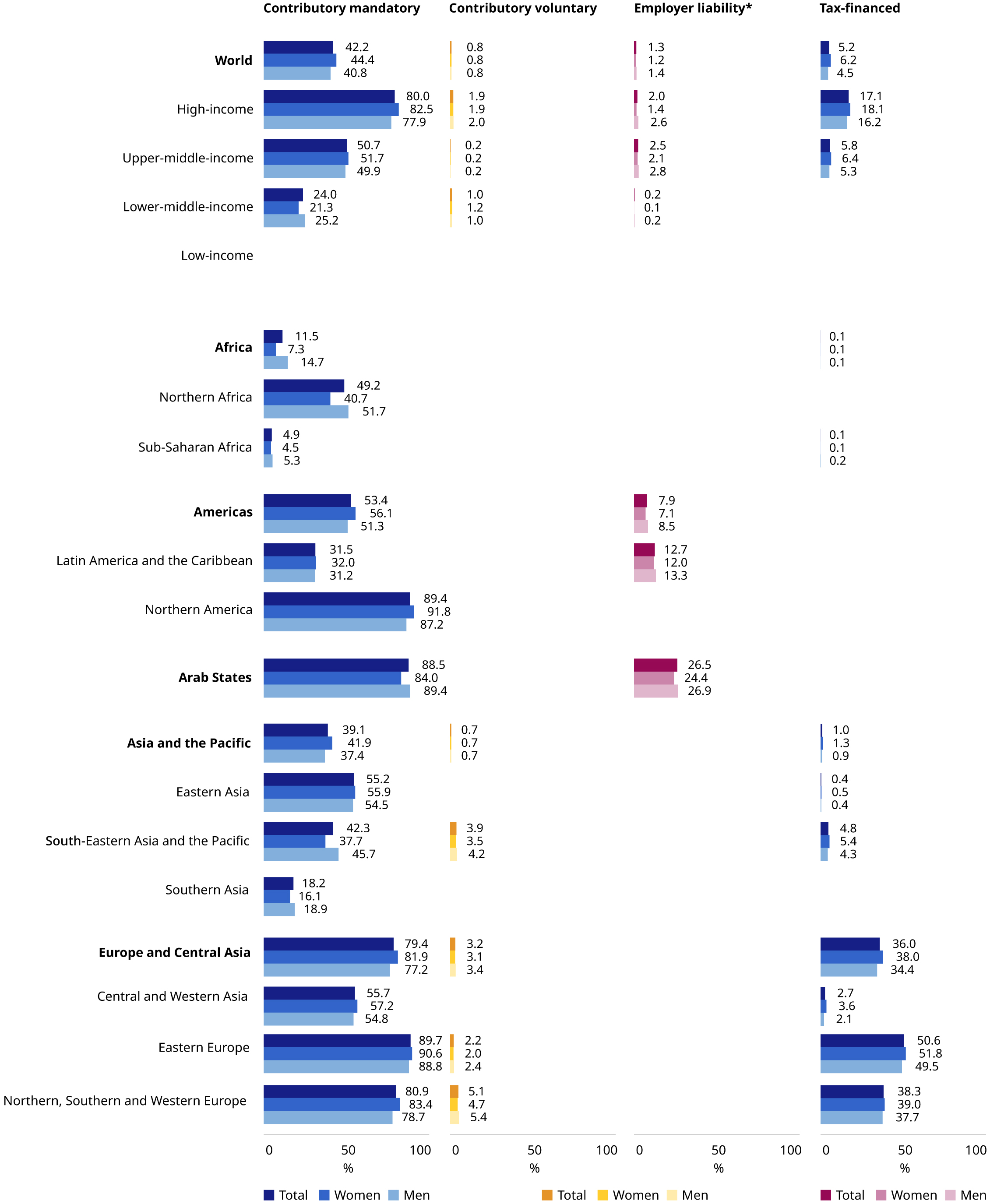
Notes: Global and regional aggregates are weighted by the labour force aged 15 and over. Estimates are not strictly comparable to the previous World Social Protection Report due to changes in the methodology.
* Includes mandatory separation payment funds, mandatory individual savings accounts and mandatory private insurance. Specifically, Chile and Jordan have a combination of individual savings accounts with other types of schemes. Colombia, Costa Rica, Dominica, Ecuador, Honduras, Panama, Peru and the Bolivian Republic of Venezuela have separation payments that operate through mandatory funds. The United Arab Emirates implements the unemployment insurance through mandatory private insurance.
Sources: ILO estimates; World Social Protection Database, based on the Social Security Inquiry; ISSA Social Security Programs Throughout the World; ILOSTAT; national sources.
Unemployment protection schemes (either social insurance or tax-financed) can be found in 93 of the 194 countries or territories for which data are available (figure 4.25). This includes schemes introduced in the aftermath of the COVID-19 pandemic in Grenada, Indonesia, Iraq, Turks and Caicos Islands and the United Arab Emirates. Predominantly, unemployment protection is provided through social insurance mechanisms (87), most frequently coordinated with tax-financed schemes (38), and more rarely as only a social insurance mechanism (16). Six States have tax-financed unemployment benefit schemes: New Zealand and the Russian Federation, as well as Andorra, Australia, the Seychelles and Tunisia in combination with separation benefits. In Latin America, few countries complemented social insurance schemes with separation funds financed by employers’ contributions (Brazil, Colombia, Ecuador and the Bolivarian Republic of Venezuela). Chile and Jordan use unemployment individual savings accounts; in Chile such mechanism is complemented by a solidarity component financed by employers and the Government. However, individual savings accounts fail to comply with international social security standards due to lower levels of protection and absence of collective financing mechanisms (box 4.14).
Among the 101 countries and territories without unemployment protection schemes, 80 provide separation payments, sometimes through a mandatory fund financed by employers (for example, Costa Rica, Dominica, Honduras, Panama and Peru). Such employer liabilities offer only a limited level of protection. In 55 of the 92 countries and territories implementing unemployment insurance schemes, separation payments have been maintained as a complementary mechanism.
Figure 4.25 Unemployment protection (cash benefits) anchored in law, by type of scheme, 2023 or latest available year
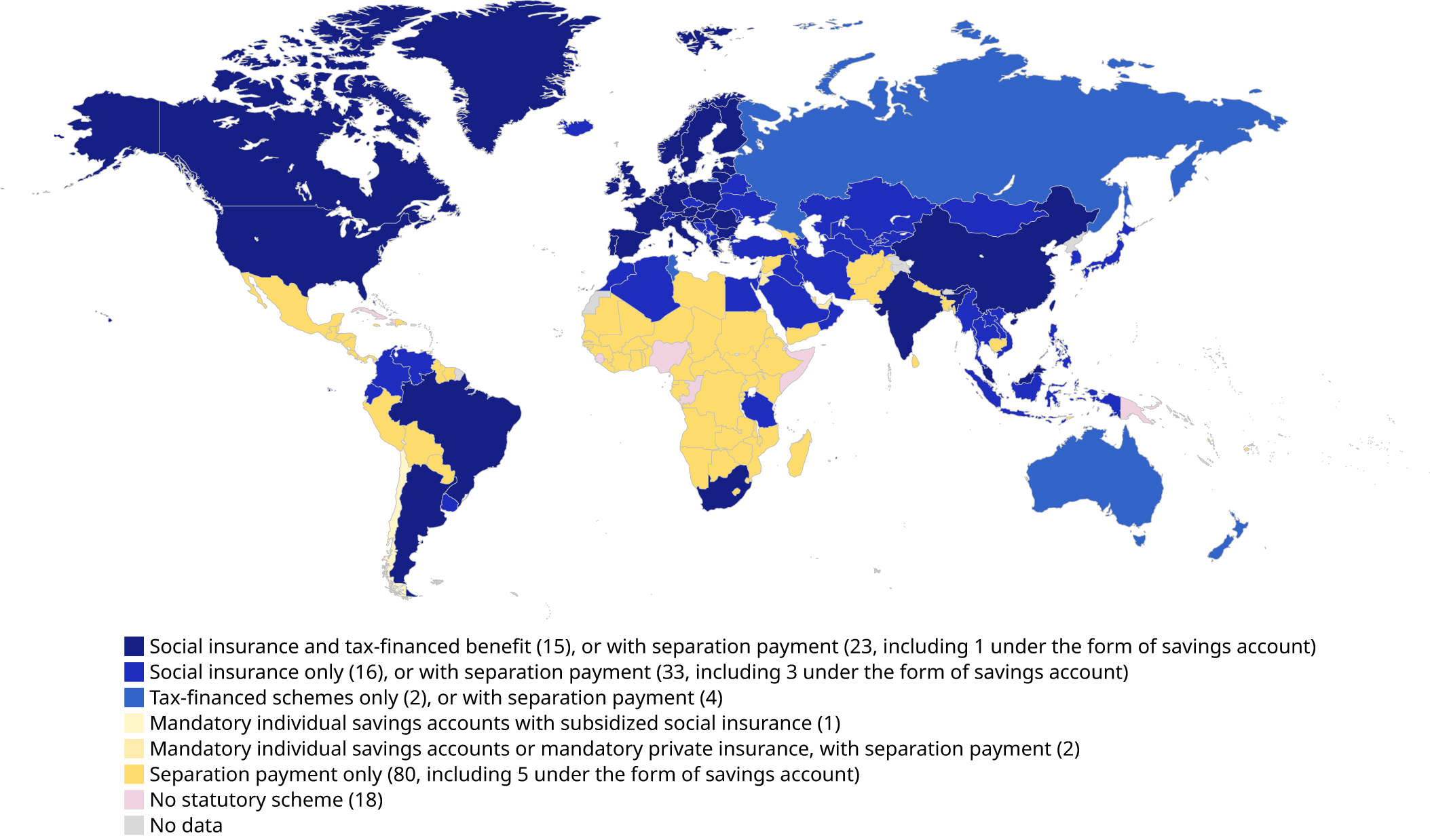
Disclaimer: Boundaries shown do not imply endorsement or acceptance by the ILO. See full ILO disclaimer.
Note: The number between parentheses refers to the count of countries or territories.
Sources: ILO estimates; World Social Protection Database, based on the Social Security Inquiry; ISSA Social Security Programs Throughout the World; ILOSTAT; national sources.
Box 4.14 Why individual savings accounts are not social insurance unemployment benefits
|
While unemployment individual savings accounts fulfil the very important objective of securing income and preventing poverty when jobs and earnings are suspended, they cannot be considered as social insurance, as they do not align with some of the internationally agreed principles embedded in ILO Conventions Nos 102 and 168. This is because unemployment individual savings accounts:
The cost of unemployment individual savings accounts is higher for two reasons. First, the saving or contribution rate must be set at a necessarily high level to build individual savings. Then, tax revenues are necessary to support unemployed workers who cannot accumulate sufficient savings, if any. Unemployment individual savings accounts can serve as a valuable supplement to social insurance or tax-funded unemployment protection schemes, enabling access to funds for addressing immediate family or business development needs. However, they should not be considered as a substitute for social protection measures. |
Source: ILO (forthcoming a; forthcoming f).
Effective coverage for unemployment protection and challenges in the current labour market context
While nearly one in two workers is legally covered, only 16.7 per cent of the unemployed receive benefits, with 56.1 per cent in high-income countries, 2.5 per cent in lower-middle-income countries and 0. 2 per cent in low-income countries (figure 4.26). Thus, over 168 million unemployed persons are left without unemployment benefits, of whom nearly 102 million men and 66 million women, with large regional disparities (figure 4.27). Scheme design features such as restrictive qualifying conditions, legal exclusions of certain types of contracts and economic sectors or household income thresholds, as well as significant employment informality, can explain the low effective coverage.
The interpretation of low coverage rates must consider the broader labour market context. While the global unemployment rate has reverted to the pre-pandemic level (5.1 per cent in 2023) (ILO 2024k), the unemployment rate does not accurately reflect labour market deficits in least developed countries and other developing countries, where workers cannot afford to be unemployed. Instead, the composite measure of labour underutilization – covering time-related underemployment (17.6 per cent of the extended labour force) and potential labour force (10 per cent of the extended labour force) in addition to unemployment – is a complementary indicator (ILO 2022l). Another complementary measure to the unemployment rate is the jobs gap, which refers to the number of persons who want to work, regardless of whether they are searching for a job or are available for one.23 In 2023, globally, 435 million were considered as being in the jobs gap or 11.0 per cent of the extended labour force and willing non-jobseekers, more than double the unemployment count (ILO 2024h). Post-COVID-19 employment recovery is further marred by persistent decent work deficits, evident in declining real wages, informal employment prevalence and working conditions deterioration (ILO 2024k).
Figure 4.26 SDG 1.3.1 on effective coverage for unemployment protection: Share of unemployed persons receiving cash benefits, by region, subregion and income level, 2015 and 2023 (percentage)
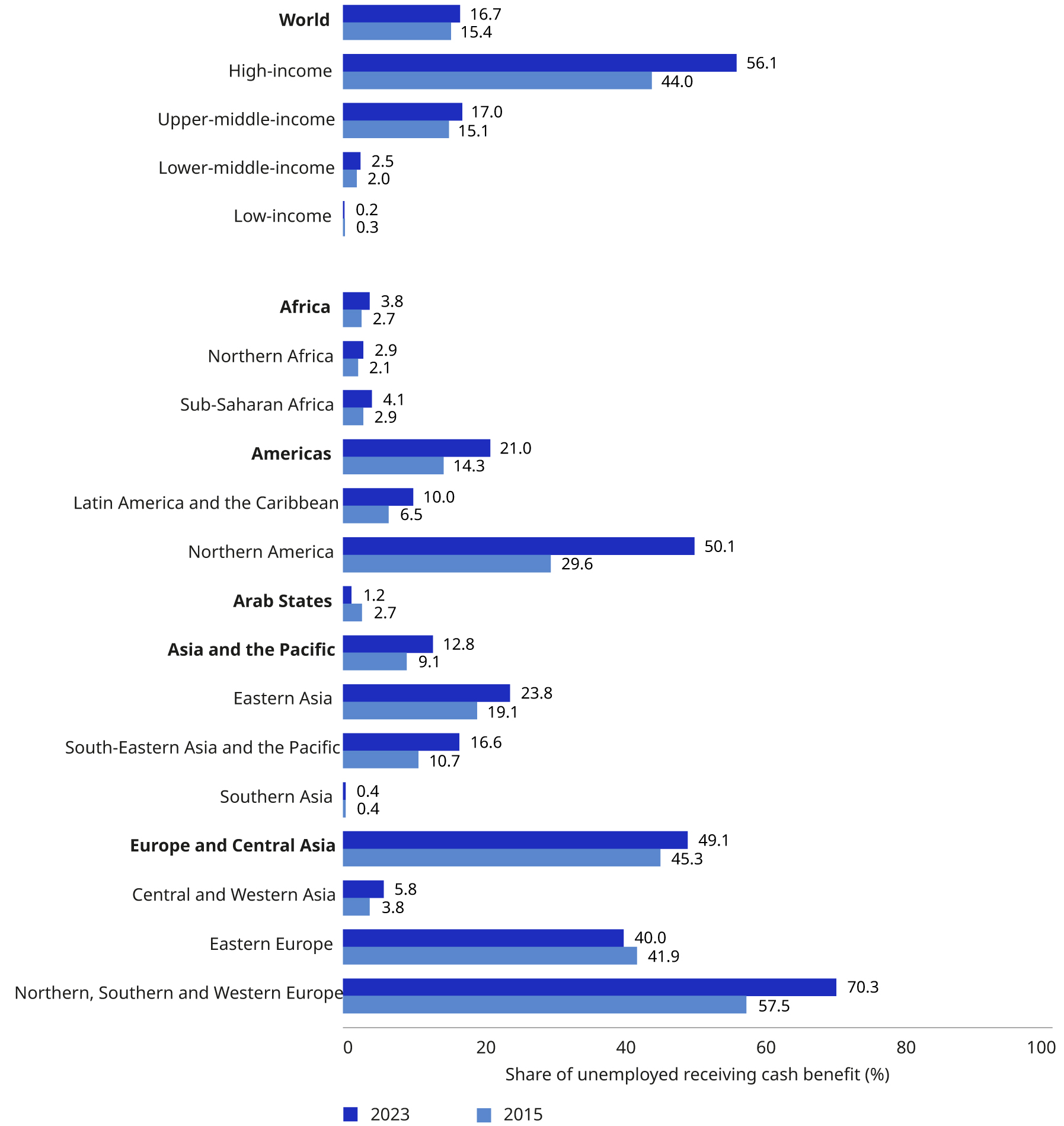
Notes: See Annex 2 for a methodological explanation. Global and regional aggregates weighted by the number of unemployed. Estimates are not strictly comparable to the previous World Social Protection Report due to methodological enhancements, extended data availability and country revisions. Effective coverage data for 2023 is still affected by the high numbers of 2020 and 2021, when countries deployed large unemployment protection responses to the COVID-19 crisis, funded by the State’s budget (for example, United States).
Sources: ILO modelled estimates, 2024; World Social Protection Database, based on the Social Security Inquiry; ISSA Social Security Programs Throughout the World; ILOSTAT; national sources.
Figure 4.27 SDG indicator 1.3.1 on effective coverage for unemployment protection: Share of unemployed persons receiving cash benefits, 2023 or latest available year (percentage)

Disclaimer: Boundaries shown do not imply endorsement or acceptance by the ILO. See full ILO disclaimer.
Sources: ILO estimates; World Social Protection Database, based on the Social Security Inquiry; ISSA Social Security Programs Throughout the World; ILOSTAT; national sources.
Special attention to youth
In 2023, the global youth unemployment rate stood at 13.3 per cent, its lowest level since 2008. However, the share of youth not in employment, education or training (NEET) remains high at21.7 per cent in 2023, representing 269 million young people globally, two thirds of whom are women.24 Often engaged in short-term or apprenticeship contracts, young people, as new labour market entrants, lack coverage under unemployment protection schemes (ILO 2024k; Carter, Bédard and Peyron Bista 2013; Dubois and Hyland 2024). To address this gap, countries are implementing innovative measures. In 2024, Algeria introduced a specific unemployment benefit for young jobseekers and new entrants with low incomes.25 China has adopted a one-time subsidy policy to incentivize enterprises to hire university graduates and registered unemployed, including within two years of graduation, contingent upon social insurance registration (ILO 2023j; UN 2022).
Additionally, some countries offer a partial or full waiver on unemployment insurance contributions for new entrants conditional on registration with public employment services (for example, Austria, Bahrain, Belgium, Denmark, Oman, Romania and Slovenia), while other recognize vocational training or apprenticeships as qualifying periods for unemployment protection (Carter, Bédard and Peyron Bista 2013; Dubois and Hyland 2024; Ghailani et al. 2022). Such practice aligns with Convention No. 168 and the newly adopted Quality Apprenticeships Recommendation, 2023 (No. 208), which recommend extending social protection coverage to apprentices.
Ensuring unemployment protection coverage in all types of employment
Unemployment benefits have proven to reduce poverty, sustain consumption and positively impact health and well-being during job transitions (Paul and Moser 2009; O’Campo et al. 2015). They provide income support that can postpone decisions to take an informal or precarious job (Florez and Perales 2016; Asenjo and Pignatti 2019). Coordination and integration with active labour market policies increase employability and jobs-skills matching, and encourage a return to a suitable employment, with positive effects for individuals, enterprises and the economy (Faberman and Ismail 2020; Asenjo, Escudero and Liepmann 2022; Peyron Bista and Carter 2017). Nevertheless, the COVID-19 crisis exposed the vulnerability of workers who are neither poor nor registered with social insurance: the so-called “missing middle”. Short-term and part-time contracts are largely legally excluded, and self-employed coverage, even when it exists, often remains voluntary (for example, in 13 European Union Member States and the Republic of Korea). While combined contributory and non-contributory benefits tied to active labour market policies are common in high-and middle-income countries, low-income countries often struggle to implement such comprehensive public policies, due to insufficient investment (Asenjo, Escudero and Liepmann 2022; Carranza and McKenzie 2024). Yet, integrating income security and labour activation can effectively bridge protection gaps and facilitate transitions to formal employment, especially in the context of environmentally sustainable structural transformations.
South Africa’s Unemployment Insurance Fund and the Social Relief Distress provisions, which were scaled up during the COVID-19 pandemic, demonstrate the efficacy of combined approaches.26,27 The COVID-19 crisis brought about digital innovations – such as nowcasting models using consumption, employment and economic data – to identify real-time social protection needs, including in developing countries (for example, Brazil, Chile, Egypt, Guatemala, Mexico, Pakistan, the Philippines, South Africa and Togo) (Pignatti, Galian and Peyron Bista 2024; Montt, Ordoñez and Silva 2020). It also pushed countries such as Chile, Italy and Spain to extend unemployment insurance to domestic workers (Dubois and Hyland 2024; Carter, Bédard and Peyron Bista 2013; ILO 2023j).
However, in many countries, non-nationals lack unemployment protection due to legal exclusion and the absence of administrative measures to secure portability of benefits (Carter, Bédard and Peyron Bista 2013; Keyes, Carter and Bédard 2015; ILO 2023s; 2024d; 2018d). Persons with disabilities face persistent barriers to employment, and unemployment benefits can secure their income until their (re)insertion into the labour market (UNDESA 2019; Baptista and Marlier 2022). With the rapid development of platform work, several countries are exploring unemployment protection measures for these workers (for example, Canada and European Union Member States).
Unemployment insurance coverage should also be extended to wage workers in agriculture. In addition, an integrated approach such as the Benazir Income Support Programme in Pakistan and Start Your Own Business in Sri Lanka can benefit self-employed and subsistence farmers, especially women (de Mel, McKenzie and Woodruff 2014). Public work programmes also offer income security and new skills, with a focus on rural areas. The long-term decent work impact of these programmes could be strengthened through a more systematic connection with public employment services and other labour market policies (ILO 2016b).
In light of the complex challenges within labour markets, reliance solely on unemployment insurance schemes, typically tailored to formal and registered employment, falls short of providing sufficient coverage. Effective interventions require holistic approaches and the integration of policies and measures to (a) enhance working conditions and wages, employability and formalization; and (b) address underemployment – frequent among women and youth – and job search discouragement. Such holistic approaches have been applied in Argentina, Bahrain, Brazil, China, India, Malaysia and Mauritius. Multiple studies have shown the immediate and long-term efficacy of integrating social protection with active labour market policies in high-income countries (Asenjo, Escudero and Liepmann 2022; Sianesi 2008; Vooren et al. 2019). However, such integration and the role of public employment services still needs to be strengthened and adequately financed in low-and middle-income countries (Carranza and McKenzie 2024). Integrated unemployment protection systems – contributory and tax-financed benefits tied to active labour market policies – foster an enabling environment for decent work and improved skills matching. This, in turn, benefits all workers and enterprises, including small and medium-sized ones, and positively impacts economic outcomes (Martin 2015; Immervoll and Scarpetta 2012; Peyron Bista and Carter 2017). Policymakers can strategically leverage such integration in the context of climate and environmental transition to move workers to decent and formal employment (Asenjo, Escudero and Liepmann 2022).
Adapting unemployment protection schemes to better respond to climate challenges and labour market transformations
Shifting production and consumption models towards more environmentally sustainable practices entails moving away from resource-intensive and polluting industries, and boosting the circular economy. Such transitions can potentially impact employment in certain economic sectors, in particular energy, transport, steel, agriculture, construction, finance and insurance (ILO 2023g; 2023y; Montt, Fraga and Harsdorff 2018) (see section 2.2).
The world’s largest 25 coal producers, which are likely to be severely impacted by the energy transition, have an unemployment insurance scheme, alongside an old-age scheme for early retirement benefits. However, the performance of these schemes still requires improvement; only 7 of the 25 schemes have achieved effective unemployment protection coverage exceeding 50 per cent (figure 4.28). Indonesia, South Africa and Viet Nam have already recognized the critical intersection between climate and social goals in their Just Transition Energy Partnerships (Kramer 2022).
Figure 4.28 Effective unemployment protection coverage among the 25 largest coal producers, by volume of coal production, 2023 or latest available year
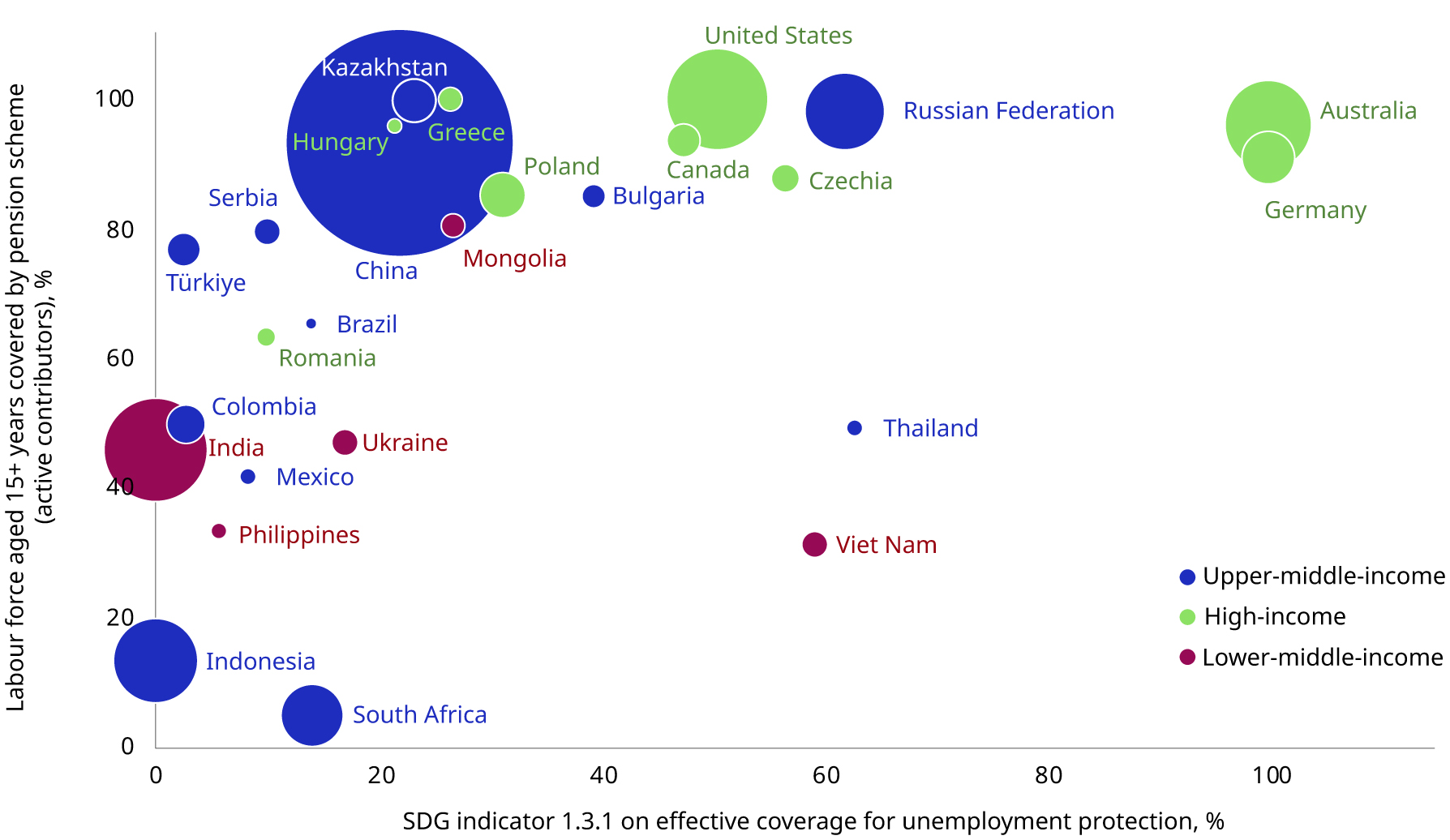
Note: The latest data available for Indonesia are for 2022, prior to payment of first unemployment benefits in 2023.
Sources: ILO estimates; World Social Protection Database, based on the Social Security Inquiry; ILOSTAT; national sources and Eurostat Survey on Income and Living Conditions; Worldometer.
Close to two thirds of all renewable energy jobs are based in Asia, with China alone accounting for 42 per cent of the global total (IRENA and ILO 2022). In this region, only 38.6 per cent of the labour force is legally covered by an unemployment protection scheme. This low legal coverage diminishes the potential that unemployment protection schemes could play in facilitating access to reskilling programmes or geographical relocation, necessary to address skills, sectoral, spatial and temporal misalignment caused by the energy transition.
In addition, beyond income security and re-employment, it is crucial to ensure continued access to social health protection, maternity and child benefits during periods of unemployment (ILO Convention No. 168). This is particularly important in reducing vulnerabilities to climate change. Addressing immediate and slow-onset climate impacts calls for extended, innovative and more resilient unemployment protection schemes. This section discusses concrete adaptations of unemployment protection schemes to better respond to the challenges posed by the just transition imperative.
Unemployment insurance schemes
Unemployment insurance demonstrated its efficacy in supporting workers and employers affected by climate-related shocks during the 2011 flood in Thailand through the extension of the benefits period and contribution reduction (ILO 2012). Chile recently reformed its unemployment scheme to address catastrophes, including natural disasters (Government of Chile 2023). Unemployment insurance, tied with job placement and reskilling programmes, is also an effective enabler for supporting mitigation policies, such as in Germany and Spain. Canada, Germany and Japan’s unemployment insurance schemes include an occupational or mobility allowance to encourage jobseekers to take new employment in other regions or participate in retraining programmes (Carter, Bédard and Peyron Bista 2013). Other concrete measures may be the removal of legal barriers – such as (a) the exclusion of micro, small and medium-sized enterprises; self-employed workers; apprentices; temporary or part-time workers; (b) age-based criteria; and (c) overly strict qualifying conditions – or the provision of governments’ subsidies for new entrants to the labour market, persons with disabilities, workers those with short contribution periods, and long-term unemployed people (ILO 2020k; 2021q).
Early retirement pensions
In environmental transition contexts, early retirement pensions provide income security for older workers unlikely to find new employment, on a voluntary basis. For instance, in the coal phase-outs negotiations, Germany and Spain offered early retirement pension to miners aged above 58 and 48, respectively (WRI 2021a; 2021b). However, in recent years, there has been a trend of limiting possibilities for early retirement in an effort to increase retirement age in the context of population ageing. In such cases, active labour market policies tailored to the needs of older workers, alongside income support measures, become all the more important to facilitate a just transition promoting intergenerational solidarity (Bischler et al. forthcoming).
Employment retention programmes
In times of crisis, job retention and wage subsidy schemes can effectively protect workers’ incomes while maintaining the employment relationship, thus reducing the cost of rehiring employees (ILO 2021q; Chung 2021; Tsuruga 2020). These programmes, either financed by workers’ and employers’ contributions or general taxes, were widely implemented during the COVID-19 pandemic (ILO 2023j). While they can effectively support industries copying with temporary climate shocks, they do not address slow-onset structural unemployment and their effect will remain limited unless extended to small and medium-sized enterprises.
Social assistance schemes
Social assistance and unemployment assistance schemes (typically tax-financed) aim to secure a basic income, and prevent poverty and socio-economic exclusion, for individuals who are not covered by unemployment insurance or have exhausted their entitlements. They can also support rural workers moving towards decent jobs by combining income, reskilling and entrepreneurship support – such as Nicaragua’s Atención a Crisis scheme, which helps rural households transition from agriculture subsistence to non-agriculture self-employment in response to increasing climate risks (Marcours, Vakis, and Premand 2020). Once established, social assistance schemes can rapidly expand their support to individuals and families in case of climate shocks, using early warning mechanisms and high-frequency data to forecast economic shocks on households (Pignatti, Galian and Peyron Bista 2024). However, tax-financed unemployment programmes often provide lower benefits than unemployment insurance schemes and are limited to lowest-income households.
Public employment programmes
Public employment programmes provide financial support to individuals and families, while participating in reconstruction efforts following climate-related shocks, building climate-resilient infrastructure and promoting green agriculture production. In the aftermath of Typhoon Haiyan in 2013, the Philippines’ Department of Labour and Employment initiated the Integrated Livelihood and Emergency Employment Programme aimed at providing short-term wage employment and supporting entrepreneurship, tied to social security registration (ILO 2015a).
The environmental transition will inevitably transform labour markets, demanding innovations in unemployment protection and active labour market policies (Boeri and Cahuc 2023). Unemployment insurance, which already exists in 87 countries, can support workers affected by the climate and environment transition. However, relying solely on social insurance is not sufficient to protect workers in all types of employment and ensure a just transition (see section 3.2.2). Therefore, in parallel with efforts to improve unemployment insurance performance, governments must consider introducing integrated unemployment protection systems, combining unemployment benefits from social insurance or tax-financed mechanisms with active labour market policies. Immediate actions include:
-
expanding legal scope and relaxing qualifying conditions for unemployment benefits;
-
investing in and strengthening active labour market policies including public employment services;
-
leveraging nowcasting models to rapidly respond to economic shocks;
-
introducing early warning and climate information into the governance of schemes; and
-
exploring innovative approaches for reaching workers in all types of employment.
.4.3 Social protection for older women and men: Pensions and other non-health benefits
Key messages
-
Ensuring adequate protection in old age remains a challenge, particularly for women, individuals in low-wage occupations, those engaged in precarious employment, workers on digital platforms, and migrants. This challenge will probably be exacerbated by climate change, in the form of involuntary migration, fragmented careers or general climate-induced economic pressure.
-
Pensions are the most prevalent form of social protection globally. Worldwide, 79.6 per cent of individuals above the retirement age receive some form of old-age pension. Nonetheless, more than 165 million individuals above statutory retirement age do not receive a pension.
-
In many countries, especially those with widespread informal employment, extending contributory pensions has been challenging. The introduction of tax-financed pensions provides an important source of income for older persons, especially for previously excluded groups. Yet, in some countries, benefit levels are insufficient to guarantee a social protection floor for older persons
-
The trends to expand and adapt pension systems exhibit significant variability across and within regions. In countries boasting extensive and well-established social protection systems, where populations are ageing, the primary challenge lies in preserving a delicate equilibrium between financial sustainability and pension adequacy. Other countries still face extension-and financing-related challenges in their pension systems, such as low economic development, pervasive informality, limited contributory capacities, poverty, fiscal resource constraints and increases in the cost of living.
-
The climate crisis threatens the financial sustainability and adequacy of pension schemes. Consequently, pension schemes must adapt to contend with climate-related risks to ensure long-term sustainability and protect the quality of life of beneficiaries. Pension funds can also help combat the climate crisis through strategic investments in sustainable and low-carbon assets. By aligning their investment strategies with environmental sustainability and embracing responsible investment principles, pension funds can become key players in global mitigation efforts, ensuring a sustainable future for all generations.
4.3.1 Ensuring income security in old age to realize older people’s right to social security
Guaranteeing income security for individuals in old age is a fundamental aspect of the human right to social security; a precondition for reducing vulnerabilities and increasing resilience in the context of climate change (box 4.15). Public pension schemes are essential in providing this support, using a mix of mechanisms to ensure financial stability for older people. This support is further enhanced by the provision of accessible social services such as healthcare, home assistance and long-term care, which are all integral to securing a dignified life in old age.
The role of income security in mitigating poverty and reducing vulnerability of older people is critical, and it directly contributes to the fulfilment of SDG target 1.3, among other SDGs. To ensure inclusivity and leave no older individual without support, it is vital for policymakers and legislators to develop and sustain broad-based social protection frameworks, adhering to the principle of universality. In line with Recommendation No. 202, an effective blend of contributory and non-contributory pension schemes can provide comprehensive protection for all.
4.3.2 Types of pension schemes
Globally, pension systems exhibit a large degree of diversity, frequently combining contributory and tax-financed schemes to ensure universal, adequate and comprehensive protection (box 4.15). While recognizing different forms of provisions, international social security standards provide a set of principles that guide countries and ensure adequate protection to the population. Central to this framework, public pension schemes have been instrumental in securing adequate income for older individuals, significantly contributing to poverty reduction and inequality mitigation. Many countries have expanded their pension systems over time by (a) extending coverage to so far uncovered categories including self-employed workers; (b) integrating components that ensure minimum pension levels; and (c) in some instances, introducing additional measures designed to provide higher benefit levels.
Box 4.15 International standards on old-age pensions
|
The rights of older people to social security and an adequate standard of living are laid down in the major international human rights instruments, the Universal Declaration of Human Rights, 1948, and (in more general terms) in the International Covenant on Economic, Social and Cultural Rights, 1966.1 International social security standards provide a comprehensive framework of core principles and benchmarks for the establishment, development and maintenance of adequate old-age pension systems. Convention No. 102 and Recommendation No. 202, together with the Invalidity, Old-Age and Survivors’ Benefits Convention, 1967 (No. 128) and its Recommendation No. 131, provide an international reference framework for pensions and other social security benefits to ensure income security, as well as access to healthcare, in old age. They state that adequate old-age pensions should be provided at guaranteed levels upon completion of a qualifying period, and regularly adjusted to maintain pensioners’ purchasing power until the beneficiary’s death (see Annex 3). Pensions can be provided through contributory schemes and/or by universal or means-tested (or pension-tested) non-contributory schemes. Contributory pensions should ensure income maintenance by guaranteeing minimum replacement rates corresponding to a prescribed proportion of past earnings, or minimum benefit levels. Non-contributory pensions, including means-tested ones, should be at least sufficient to maintain the beneficiary and their respective family in health and decency (Convention No. 102, Art. 67(c)). Together, these benefits should guarantee a dignified life in old age as a result of comprehensive social protection systems, including floors that also provide higher levels of pensions. Given rapidly ageing societies and the financing challenges involved, Recommendation No. 202 confirms the State as the entity entrusted with the overall and primary responsibility for social protection, including that of ensuring the financial, fiscal and economic sustainability of pension systems with due regard to social justice and equity. 1 Universal Declaration of Human Rights, Arts 22 and 25(1); International Covenant on Economic, Social and Cultural Rights, Art. 9. See also UN (2008) and ILO (2021a). |
Among the 222 countries and territories for which data exist, 213 offer old-age pensions as periodic cash payments through at least one scheme. Of these, 178 use public social insurance as the dominant mode of provision, 119 employ a mix of both contributory and non-contributory schemes, 86 only use contributory scheme(s), and 8 only use tax-financed schemes (figure 4.29). Furthermore, 30 countries and territories provide universal benefits to all beyond a specific age or in combination with tax-financed means-tested benefits, while 97 offer solely means-tested benefits (either income-or pensions-tested) to older individuals ineligible for any other pension. A small minority of four countries and territories still only provide one-time lump sum payments instead of periodic benefits, utilizing provident funds or similar initiatives.
Figure 4.29 Old-age protection (pensions) anchored in law, by type of scheme, 2023 or latest available year
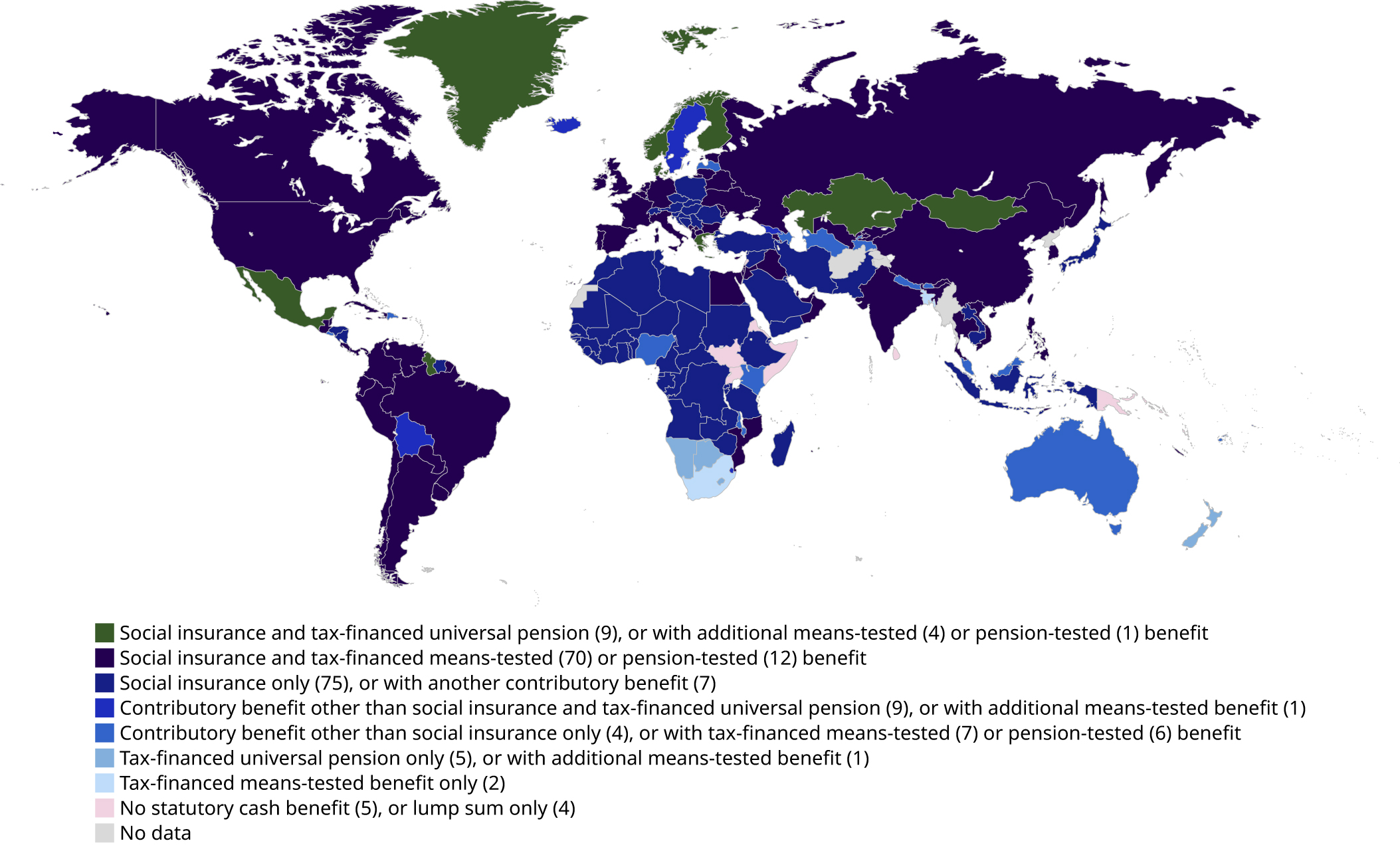
Disclaimer: Boundaries shown do not imply endorsement or acceptance by the ILO. See full ILO disclaimer.
Note: The number between parentheses refers to the count of countries or territories.
Sources: ILO estimates; World Social Protection Database, based on the Social Security Inquiry; ISSA Social Security Programs Throughout the World; ILOSTAT; national sources.
Regarding contributory schemes, defined benefit pension schemes – which are founded on the principle of collective financing – are prevalent in 84 per cent of countries. Among those, around a quarter are complemented by either a mandatory defined contribution scheme or a notional defined contribution scheme. Furthermore, 13 per cent of countries depend solely on mandatory defined contribution schemes, which are based on individual accounts, and only 1 per cent exclusively rely on notional defined contribution schemes (figure 4.30).28
Figure 4.30 Financial mechanisms for old-age pensions: Share of countries with defined benefit or defined contribution pension schemes, 2023 or latest available year

NDC = notional defined contribution; DC = defined contribution.
Sources: ILO estimates; World Social Protection Database, based on the Social Security Inquiry; ISSA Social Security Programs Throughout the World; ILOSTAT; national sources.
4.3.3 Legal coverage
More than half (51.4 per cent) of the working-age population worldwide are covered by statutory mandatory and voluntary contributory schemes, and therefore potentially qualify for a contributory pension upon reaching the prescribed age. Yet, only 39.4 per cent of the working-age population are covered under a mandatory scheme, while an additional 12.0 per cent are covered under voluntary schemes, for which uptake often remains below expectations and therefore does not lead to effective access to pensions. This is often attributable to low contributory capacities as well as the perceived remoteness of retirement, which contrasts with the immediate financial needs of households.
At the same time, 44.0 per cent of the global working-age population have legal coverage under a universal or means-tested non-contributory (tax-financed) scheme, making them potentially eligible for a non-contributory benefit upon reaching the retirement age (see figure 4.31).
In mandatory contributory pension schemes, the legal coverage rate for women is lower than that for men, with 32.6 and 46. 3 per cent of the total working-age population respectively. This gender gap mirrors the lower participation of women in the labour market, and their over-representation in many contexts among self-employed individuals, contributing family workers (especially in agriculture) and domestic workers, or other categories of workers excluded from legal coverage. In the Arab States, the legal coverage of women under mandatory contributory schemes is markedly low at 12.1 per cent, whereas the coverage for men is at 49.0 per cent. Similar patterns are evident in Northern Africa and Southern Asia. Moreover, while some of these uncovered women may still ultimately qualify for survivors’ pensions at least, these benefits do not offer the same level of security as pensions accrued directly through their own contributions.
Figure 4.31 Legal coverage for old-age protection: Share of working-age population aged 15 and over covered by old-age pensions, by region, subregion, income level, sex and type of scheme, 2023 or latest available year (percentage)
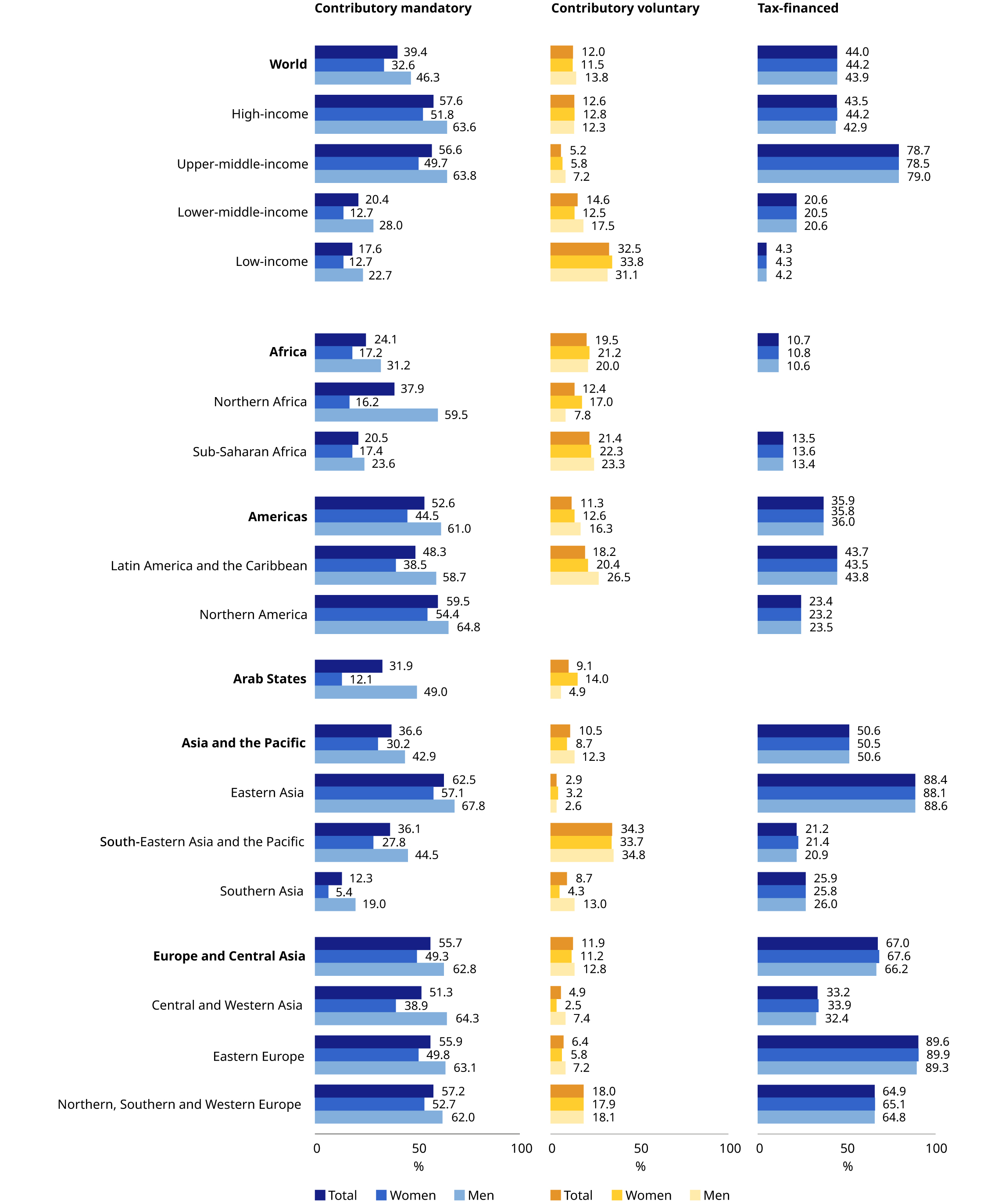
Notes: Global and regional aggregates are weighted by the working-age population aged 15 and over. Estimates are not strictly comparable to the previous World Social Protection Report due to changes in the methodology. The total does not always correspond to the sum by type of scheme due to possible simultaneous coverage by multiple social protection benefits.
Sources: ILO estimates; World Social Protection Database, based on the Social Security Inquiry; ISSA Social Security Programs Throughout the World; ILOSTAT; national sources.
4.3.4 Effective coverage: Monitoring SDG indicator 1.3.1 for older people
The effective coverage of pension schemes can be monitored using two complementary indicators: one concentrating on the working-age population making contributions to a pension scheme, and the other on older persons who are actually receiving pension benefits.
Effective coverage of people of working age (contributors)
Globally, 58.5 per cent of the global labour force actively contribute to a pension scheme and can expect to receive a contributory pension upon retirement (figure 4.32). However, substantial regional differences exist, with coverage rates of only 9.7 per cent in sub-Saharan Africa, in contrast to Eastern Europe or Northern America, where the large majority of workers contribute (91.0 and 99.3 per cent respectively).
Figure 4.32 Effective coverage for old-age protection: Share of persons in labour force aged 15 and over covered by a pension scheme (active contributors), 2023 or latest available year (percentage)
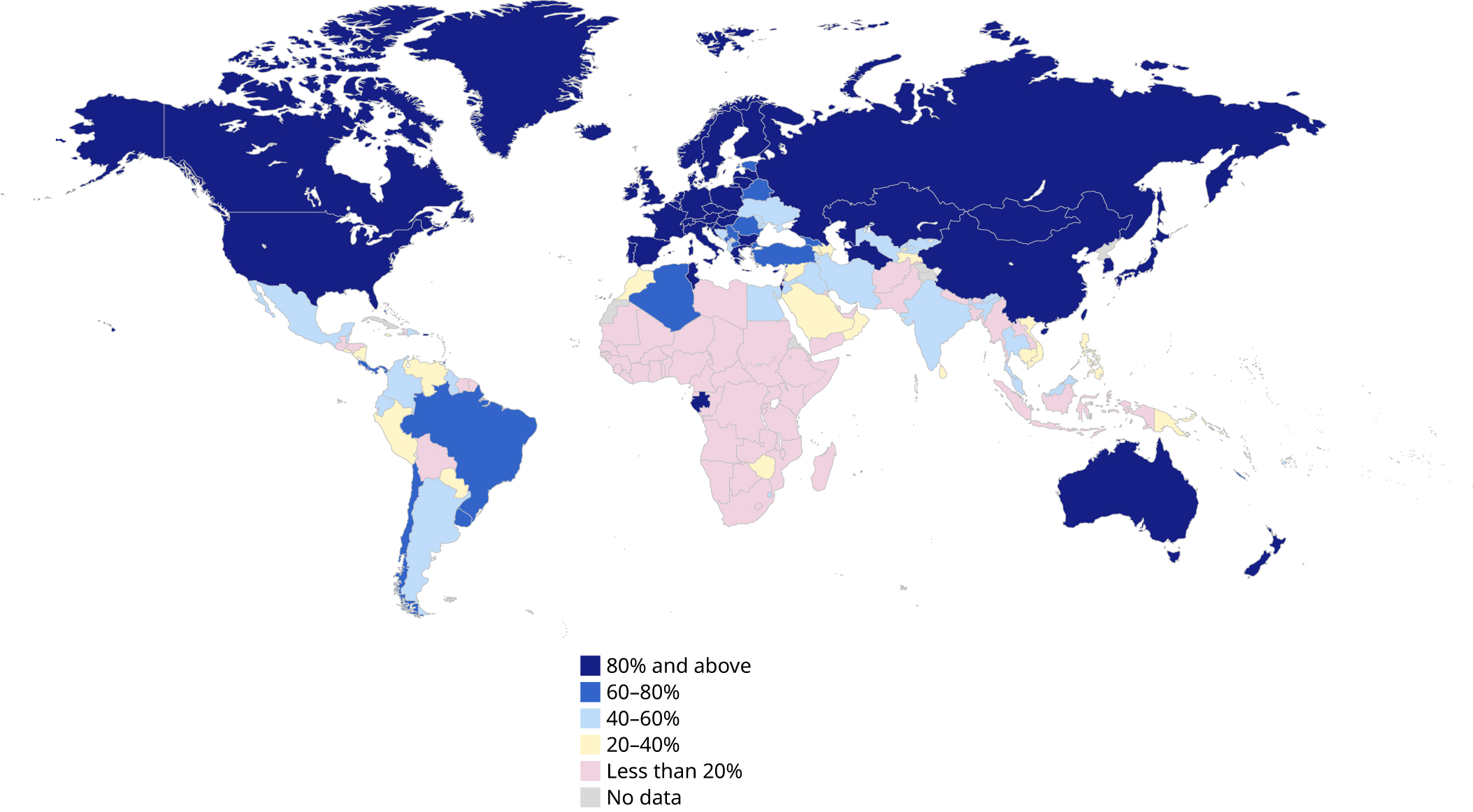
Disclaimer: Boundaries shown do not imply endorsement or acceptance by the ILO. See full ILO disclaimer.
Sources: ILO estimates; World Social Protection Database, based on the Social Security Inquiry; ISSA Social Security Programs Throughout the World; ILOSTAT; national sources.
The number of persons of working age who are actively contributing to a pension scheme sheds light on the anticipated pension coverage for this cohort in the future. Figure 4.33 provides this indicator in two variants: as a proportion of the labour force, and as a proportion of the working-age population.
Figure 4.33 Effective coverage for old-age protection: Share of persons in labour force and working-age population aged 15 and over covered by a pension scheme (active contributors), by region, subregion and income level, 2020 and 2023 (percentage)
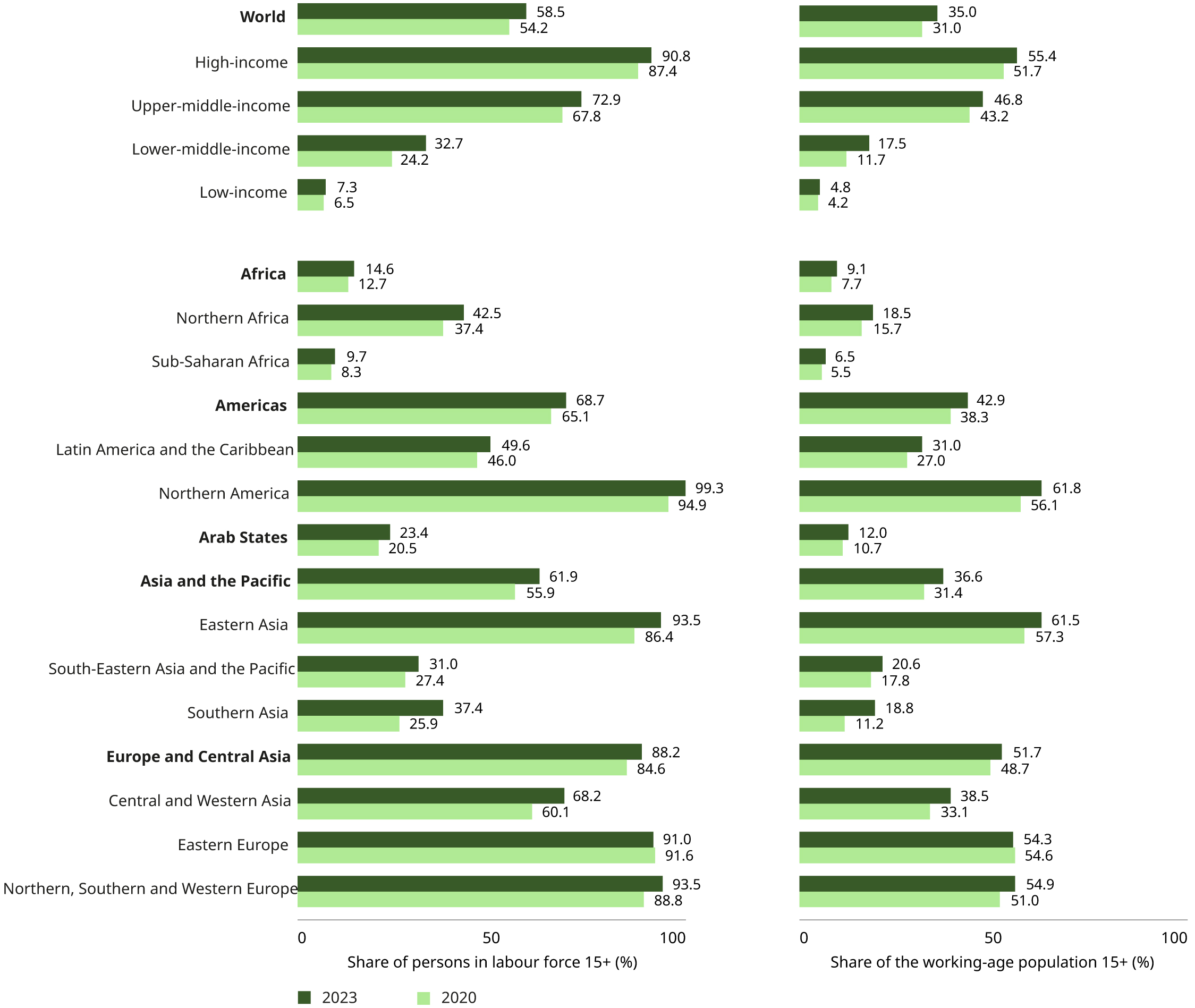
Notes: See Annex 2 for a methodological explanation. Global and regional aggregates are weighted by the labour force and working-age population aged 15 and over.
Sources: ILO estimates; World Social Protection Database, based on the Social Security Inquiry; ISSA Social Security Programs Throughout the World; ILOSTAT; national sources.
Yet, only one third of the working-age population (35.0 per cent) contributes to pension schemes, which is a significant concern, particularly for women. Especially in low-income countries, the small coverage ratio of 7.3 per cent of the labour force, and 4.8 per cent of the working-age population, is troubling. As a result, a significant number of individuals reach retirement age without any pension entitlements under contributory schemes, due to high levels of informality, linked to limited contributory capacity and compliance, and weak governance and institutional capacities. At the same time, there has been a significant increase in pension coverage in upper-and lower-middle-income countries, with coverage rates of 72.9 per cent and 32.7 per cent of the labour force, respectively. Some of this progress may be the result of initiatives to extend the coverage of contributory schemes to workers who are currently in informal employment, especially those with contributory capacity (ILO 2021i). Equally, tax-financed pensions remain an essential complement to guarantee a basic level of income security in old age for previously uncovered individuals.
Effective coverage of older people (beneficiaries)
Globally, 79.6 per cent of individuals above retirement age receive a pension, whether through contributory or non-contributory means, yet with large regional variations (figures 4.34 and 4.35). Pension coverage has significantly increased in some parts of the world since 2015 – for example, in Southern Asia, and South-Eastern Asia and the Pacific, to 47.1 and 48.4 per cent of persons above retirement age respectively, which represents a major progress. In sub-Saharan Africa, rates have also increased to 22.3 per cent, although more efforts are required to ensure universal pension coverage.
Worldwide, 49.2 per cent of women and 63.2 per cent of men receive contributory pensions (see figure 3.9). When it comes to tax-financed pensions, the effective coverage of older persons above statutory age is significantly lower, at 34.2 per cent and 26.9 per cent for women and men, respectively.
Figure 4.34 SDG indicator 1.3.1 on effective coverage of social protection: Share of persons above statutory retirement age receiving an old-age pension, 2023 or latest available year
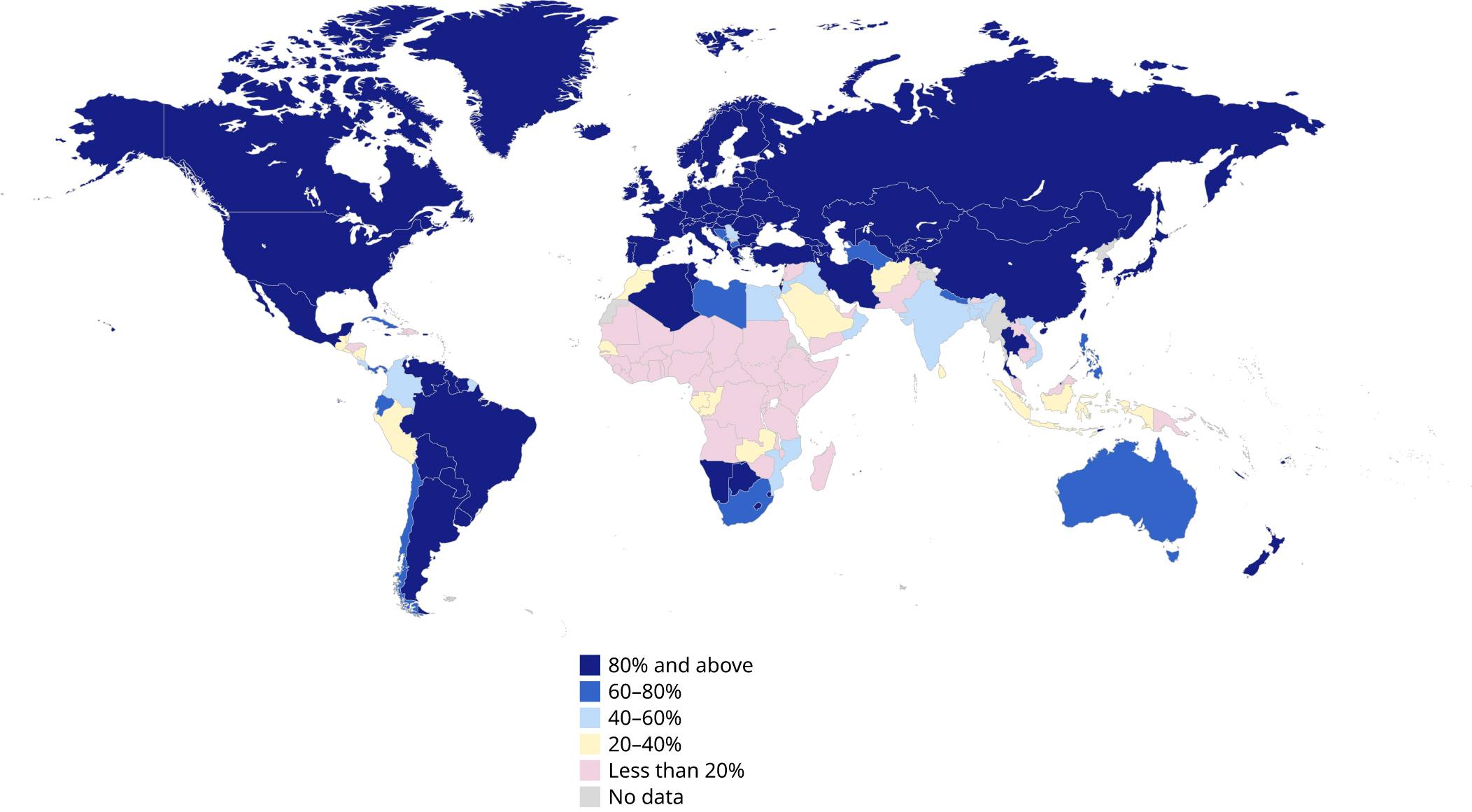
Disclaimer: Boundaries shown do not imply endorsement or acceptance by the ILO. See full ILO disclaimer.
Sources: ILO estimates; World Social Protection Database, based on the Social Security Inquiry; ISSA Social Security Programs Throughout the World; ILOSTAT; national sources.
Figure 4.35 SDG 1.3.1 on effective coverage for old-age protection: Share of persons above statutory retirement age receiving an old-age pension, by region, subregion and income level, 2015 and 2023 (percentage)
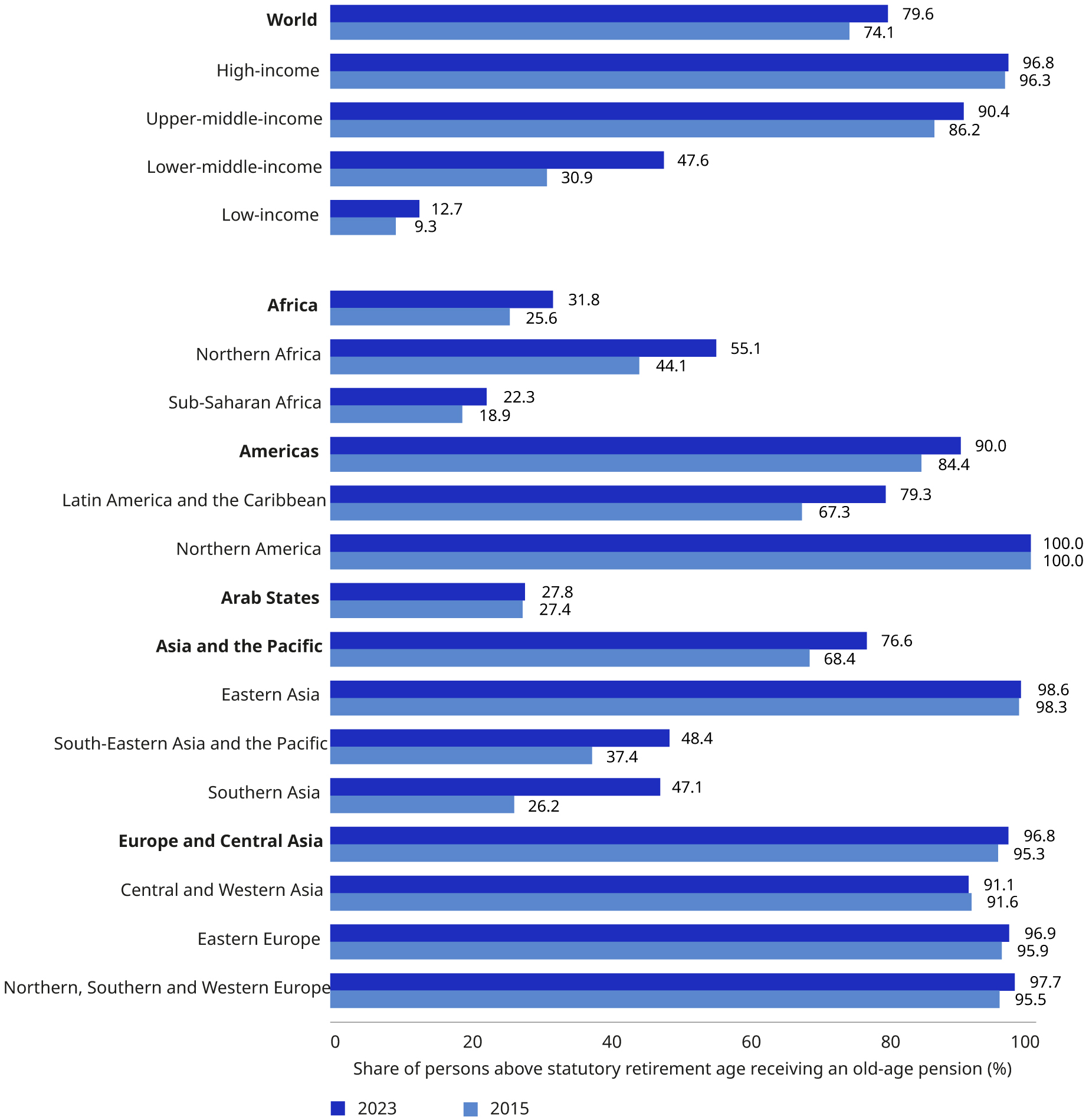
Notes: See Annex 2 for a methodological explanation. Global and regional aggregates are weighted by population aged 65 and over. Estimates are not strictly comparable to the previous World Social Protection Report due to methodological enhancements, extended data availability and country revisions.
Sources: ILO modelled estimates, 2024; World Social Protection Database, based on the Social Security Inquiry; ISSA Social Security Programs Throughout the World; ILOSTAT; national sources.
4.3.5 Expenditure on social protection for older people
The expenditure on pensions serves as a useful indicator of the maturity of pension systems, exhibiting a strong correlation with the share of older individuals within the population. More specifically, the extent of national public pension spending is shaped by multiple factors, such as the demographic composition of a country, effective coverage rates, benefit adequacy and variations in the policy mix between public and private provision of pensions and social services. Globally, public expenditure on pensions and other non-health benefits for older people averages 7.6 per cent of GDP (figure 4.36). However, substantial regional variations still exist, with expenditure levels ranging from 10.5 per cent of GDP in Europe and Central Asia to 1.7 per cent in Africa.
Countries find themselves at diverse phases of population ageing, with significant differences linked to income levels (figure 4.36). Developing countries exhibit younger demographic profiles and emerging pension systems. This constitutes a strategic opportunity to pre-emptively enact necessary adjustments and adapt to upcoming challenges to extend coverage and enhance the long-term economic sustainability of their pension frameworks, which is essential for a just transition in light of climate-related challenges.
Figure 4.36 Public social protection expenditure (excluding health) for older persons (percentage of GDP) and share of old-age persons aged 65 and over in total population (percentage), by region, subregion and income level, 2023 or latest available year
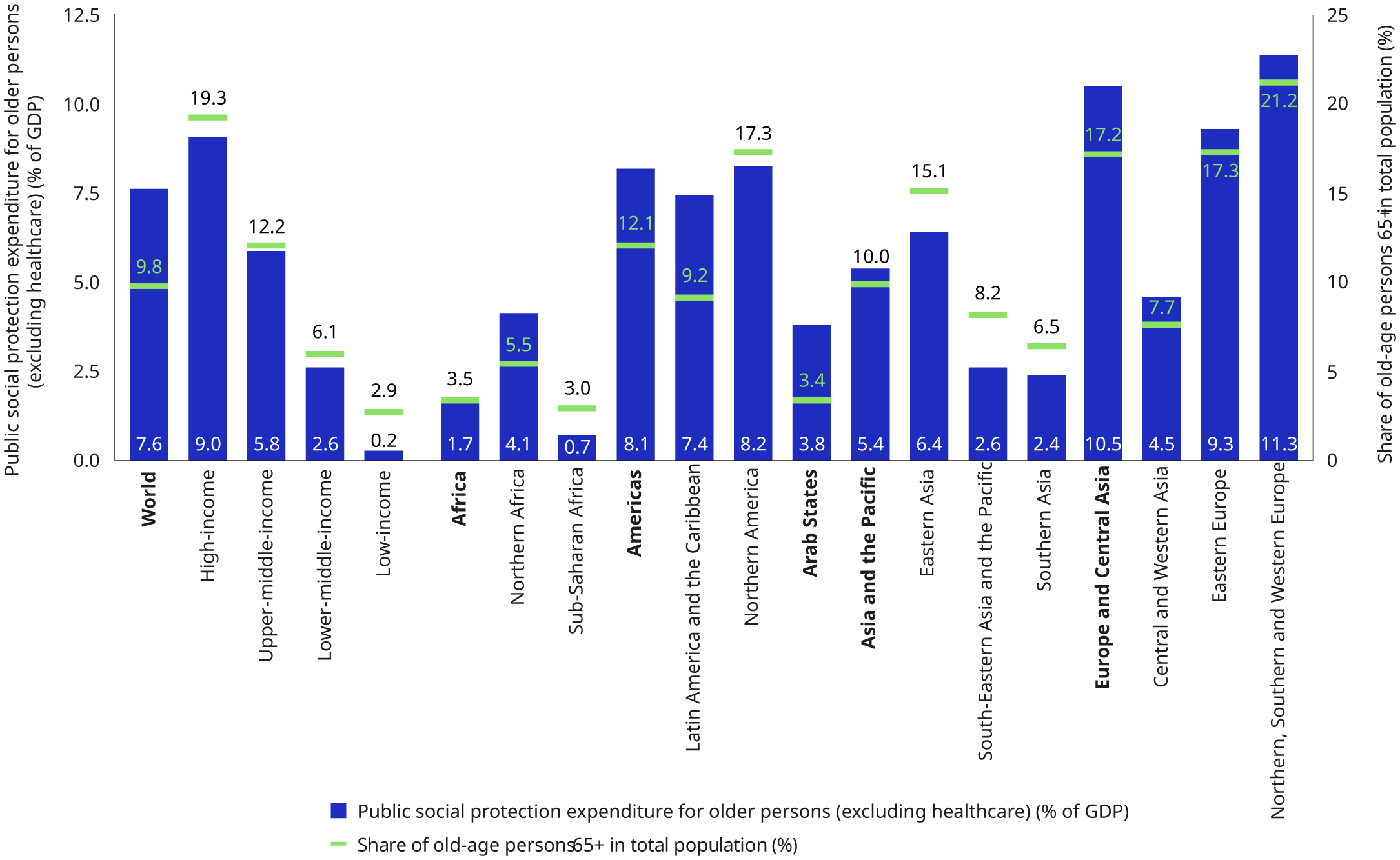
Notes: See Annex 2 for a methodological explanation. Public social protection expenditure for older persons (excluding healthcare) global and regional aggregates are weighted by GDP.
Sources: ILO estimates; World Social Protection Database, based on the Social Security Inquiry; ADB, GSW, IMF; OECD; UNECLAC; UNWPP, national sources.
4.3.6 Closing gender gaps in access to pensions
Gender gaps in pensions continue to be a significant challenge, largely due to persistent gender inequalities within the labour market and wider societal disparities discussed below. Women in many countries are less likely to engage in paid employment and to contribute to a pension. Globally, while 40.9 per cent of working-age men contribute, only 29.1 per cent of women do (Chapter 3, figure 3.9). Gender disparities are particularly pronounced in low-and lower-middle-income countries, where only 2.9 and 9.6 per cent of women of working age contribute to a pension scheme, respectively (see section 3.2.5).
Women’s access to adequate pensions is further inhibited by persistent gender wage gaps and frequently interrupted employment histories, often related to women’s disproportionate caregiving responsibilities and the lack of quality care services (ILO 2024a). Some countries have introduced mechanisms in public pension schemes to mitigate such inequalities, such as pension care credits for both women and men, or minimum pension guarantees. As benefits in private pension schemes are more rigidly tied to contribution histories, these seldom incorporate compensatory measures. Moreover, they sometimes present gender-specific actuarial tables, which are disadvantageous for women given their lower contributions, earlier retirement and longer average life expectancy (Behrendt and Woodall 2015; Behrendt 2000).
Tax-financed pensions become crucial in securing at least a basic level of income security. They narrow gender gaps in coverage, particularly in low-and lower-middle-income countries, yet often do not address benefit adequacy gaps. Women’s participation in contributory schemes, especially social insurance schemes, is therefore essential for reaching gender equality (ILO 2021a).
Globally, contributory and tax-financed pensions provide at least a basic level of income security for 82.6 per cent of older men and 77.2 per cent of older women (figure 4.37). Gender gaps are particularly large in regions with low labour force participation of women and in the absence of tax-financed pensions, as in Northern Africa or the Arab States. Moreover, low overall coverage rates are of particular concern for women who tend to constitute the majority of older persons (see section 4.3.4).
Figure 4.37 SDG 1.3.1 on effective coverage for old-age protection: Share of persons above statutory retirement age receiving an old-age pension, by sex, 2023 (percentage)
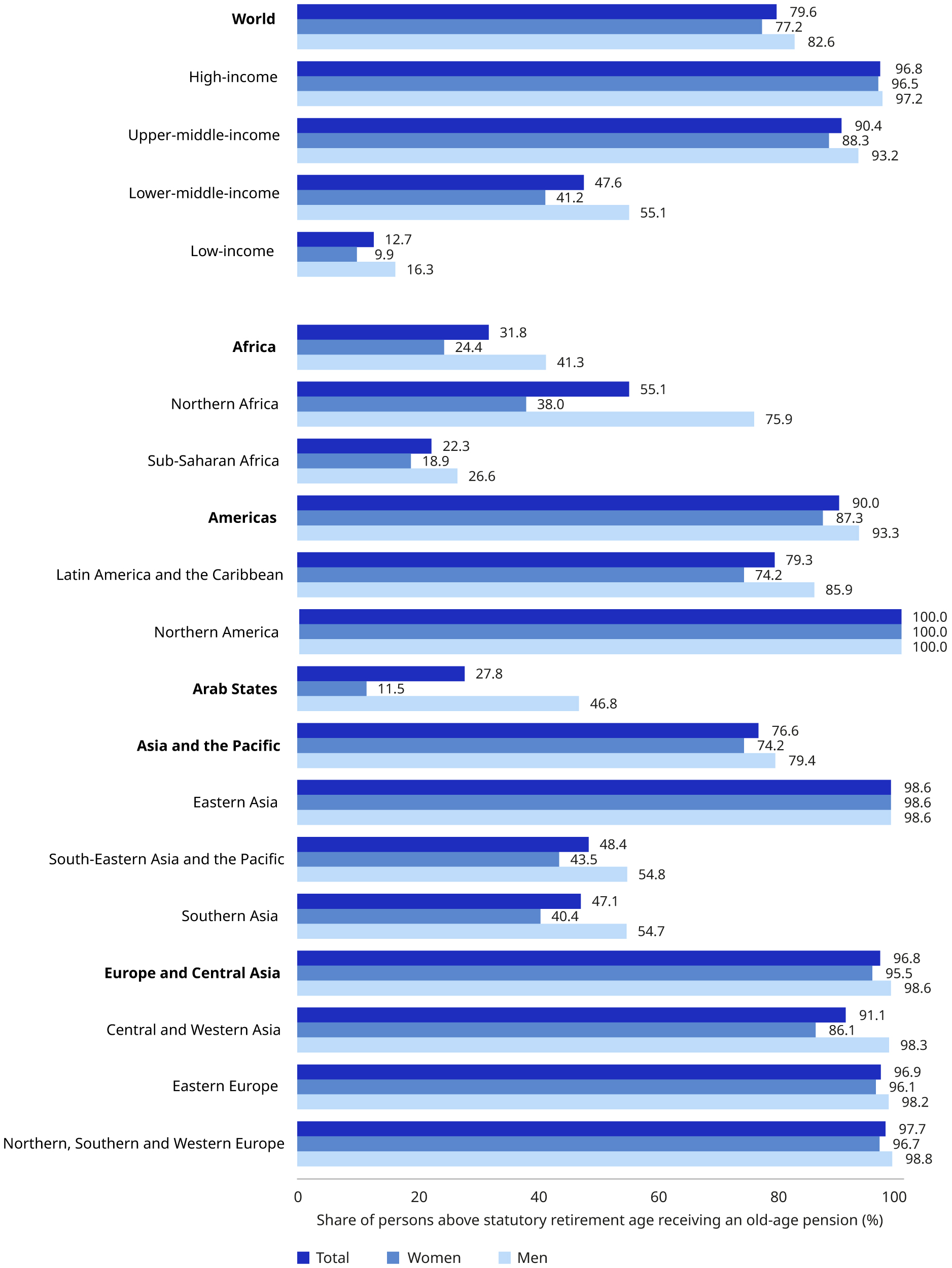
Notes: See Annex 2 for a methodological explanation. Global and regional aggregates are weighted by population aged 65 and over. Estimates are not strictly comparable to the previous World Social Protection Report due to methodological enhancements, extended data availability and country revisions.
Sources: ILO modelled estimates, 2024; World Social Protection Database, based on the Social Security Inquiry; ISSA Social Security Programs Throughout the World; ILOSTAT; national sources.
4.3.7 The adequacy of pensions to provide genuine income security to older people
While striving for universal coverage, ensuring the adequacy of pensions remains a pivotal goal. However, devising a universally applicable method to assess pension adequacy presents significant challenges. Pension adequacy encompasses both objective indicators (such as the replacement rate or the pension’s ability to meet basic living needs) and subjective measures (such as beneficiaries’ perceptions of how well their pensions maintain living standards or mirror their contributions to economic and social progress during their working years).
One potential indicator of adequacy is the effectiveness of pensions as a means of reducing income inequality. Indeed, pension schemes account for inequality reduction, especially through contributory schemes, and lesser but still substantial impacts through non-contributory ones (Razavi et al., forthcoming b). For instance, in 17 out of 35 countries, contributory pensions reduce the Gini coefficient by more than 15 per cent, and even by at least 30 per cent in Czechia, Poland and Serbia. In 25 out of 35 countries, however, non-contributory pensions are only responsible for a reduction in income inequality of less than 4 per cent. And while guaranteed non-contributory pensions remain an undeniable and critical part of national social protection floors, this data also suggests that contributory schemes might be more effective in tackling income inequality.
Furthermore, ILO research29 on 233 contributory pension schemes across 137 countries reveals that the average old-age pension amounts to approximately 43 per cent of the average wage in these countries. Meanwhile, minimum pensions amount to only 32.7 per cent of the minimum wage – levels insufficient to make ends meet.
For tax-financed pensions, the situation is equally alarming: based on the review of 100 schemes from 79 countries, the average and minimum benefits represent merely 27.7 and 20.4 per cent of the minimum wage, respectively. In 38 countries, the minimum level of tax-financed pensions remains well below the national poverty line (see figure 4.38 for selected countries). As a result, older people relying on a tax-financed pension for their income are still poor. This concerns close to 31 per cent of persons above retirement age, 34.2 per cent of older women and 26.9 per cent of older men (see section 4.3.4).
Another potential measure of adequacy is the replacement rate, describing the ratio of pensions to pre-retirement earnings. Average replacement rates in earnings-related public pension schemes in many European countries are projected to decline by 2070 (European Commission 2021). In certain instances, the anticipated reductions are substantial, with rates expected to decline significantly below the minimum benchmarks set by ILO social security standards of at least 40 to 45 per cent of prior earnings – in Conventions Nos 102 and 128, respectively – following a contribution or employment period of 30 years.
Pensions, as long-term benefits, must maintain their purchasing power and real value over an extended period. International social security standards require regular indexing of benefit levels. Country practices differ widely, ranging from ad hoc mechanisms to automatic indexation, and these practices vary across different pension schemes (table 4.4).
Figure 4.38 Minimum level of tax-financed old-age pensions (single person) relative to the national poverty line, selected countries, 2023 or latest available year (percentage)
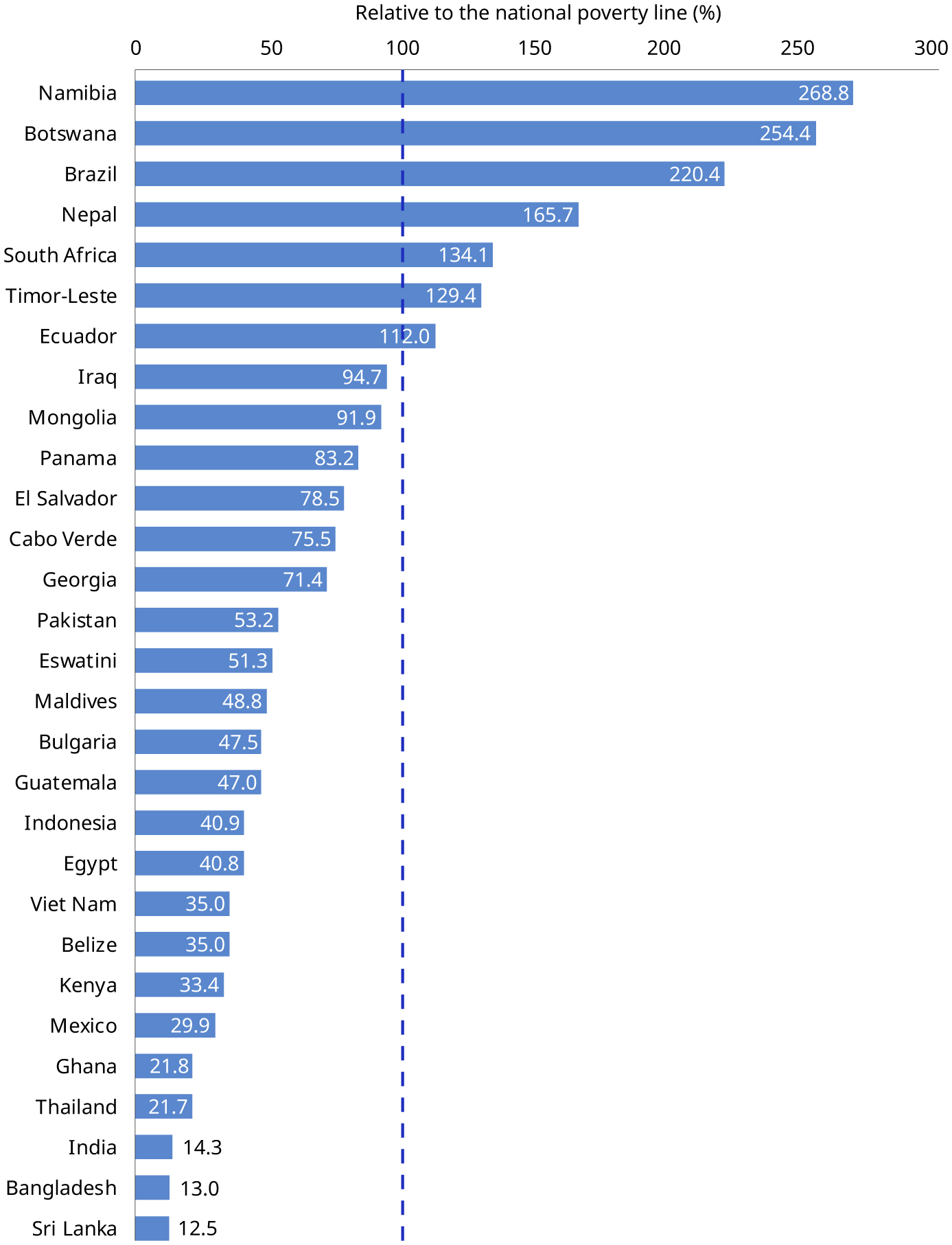
Note: Where tax-financed benefit schemes offer several benefit levels, the minimum level is shown here.
Sources: ILO estimates; World Social Protection Database, based on the Social Security Inquiry; ISSA Social Security Programs Throughout the World; ILOSTAT; national sources.
Table 4.4 Indexation methods of old-age pension schemes, 2023 or latest available year
|
Indexation method |
No. of schemes |
|
Price indexation |
92 |
|
Wage indexation |
39 |
|
Mixed prices or wages |
44 |
|
No regular indexation method |
62 |
|
No statutory requirement to adjust benefits |
18 |
|
No information |
108 |
|
Total |
363 |
Note: “No information” in most cases means “no indexation”.
Sources: ILO estimates; World Social Protection Database, based on the Social Security Inquiry; ISSA Social Security Programs Throughout the World; ILOSTAT; national sources.
While less than half of pension schemes reviewed (48.2 per cent) use price, wage or mixed indexation methods, the majority of pension schemes resort to ad hoc adjustments, often influenced by political considerations, endangering the purchasing power of benefits, especially in inflationary contexts. The absence of regular indexation or only ad hoc adjustments are concerning. Without consistent adjustments aligned with real wage increases or cost of living measures, the living standards of older individuals will decline, leading to a higher incidence of old-age poverty especially for older women.
4.3.8 Reforming pension systems in a challenging context
Concerned about pension scheme sustainability, governments across various regions announced a total of 296 measures between 2013 and 2023, aimed at containing pension expenditures and enhancing their economic sustainability. Some 136 measures postponed the retirement age. Specifically, they included increases in normal retirement age, introduction or modification of penalties for early retirement or incentives for delayed retirement, and proposals to lengthen the eligibility period or impose stricter eligibility criteria (table 4.5).
Table 4.5 Government announcements of pension reforms (contraction), 2013–23
|
Type of measure (expenditure rationalization and revenue adjustment) |
No. of cases |
|
Delaying pension receipt: Raising retirement age (96), incentivizing late or penalizing early retirement (22), tightening eligibility or increasing length of contributory period (18) |
136 |
|
Modifying calculation formula or indexation method (33), reducing benefit level (31), introducing or increasing taxes (9), reducing benefit duration (5), freezing indexation of benefit (5), reducing package of services/benefits (1), decreasing benefit subsidies (1) |
85 |
|
Increasing contribution rates (35), contracting coverage (8), reducing incentive for voluntary coverage (1), reducing or suspending contributions subsidy (1) |
45 |
|
Privatizing or introducing individual accounts (16), suspending or closing existing scheme (11), coordinating several programmes (2), introducing notional accounts (1) |
30 |
|
Total number of measures |
296 |
Source: ILO, World Social Protection Database, based on ILO Social Protection Monitor.
Pension reforms aimed at long-term sustainability have been driven by short-term crises and challenges but also by more fundamental and slow-moving generational factors, such as demographics, wage stagnation, inadequate contribution rates, the prevalence of precarious and unprotected forms of employment, widening inequalities and the decreasing labour share of income. Consequently, many countries implemented adjustments to safeguard the financial health of their pension systems, yet often with implications for pension adequacy. Many of these adjustments target benefit levels or eligibility criteria, such as increasing penalties for early retirement, elevating the statutory age for pension eligibility, or linking retirement age adjustments to life expectancy (see table 4.6).
Table 4.6 Old-age pensions: Parametric reforms in selected countries, 2021–23
|
Country and year |
Measure |
|
France (2023) |
Increased the minimum retirement age from 62 to 64 by 2032 and accelerated the increase in the contribution period required for a full pension. Aims to improve pension finances by 2030 and gradually eliminate special pension schemes. |
|
Mexico (2021) |
Implemented reforms to the mandatory individual account pension scheme by increasing employer contributions, adjusting government contributions, reducing the minimum contribution period for an old-age pension, boosting the guaranteed minimum pension, and capping administrative fees. The Government estimates an increase of future pension adequacy by an average of 40 per cent. |
|
Uruguay (2023) |
Gradually increased the minimum retirement age from 60 to 65 based on birth year and contributions. The distribution of pension contributions between schemes was modified and the calculation basis for old-age pensions changed to the best 20 years of salary, among others. Exceptions exist for long working careers or in physically demanding jobs. |
|
Japan (2023) |
The retirement age for civil servants in Japan was raised from 60 to 61, thereby also addressing Japan’s workforce shortages. The plan is to gradually raise the retirement age to 65 by fiscal year 2031. Japan’s broader strategy is to utilize the experience of older workers and mitigate the impacts of an ageing workforce. |
|
Switzerland (2022) |
Decided by referendum to gradually increase the retirement age for women to match that of men by 2028. |
Source: ILO, World Social Protection Database, based on ILO Social Protection Monitor; OECD Pensions at a Glance 2023.
Structural or parametric reforms should align with the benchmarks set out in international social security standards to achieve the dual goal of ensuring financial, economic and fiscal sustainability, while also prioritizing equity and social justice (see box 4.16). Fundamental normative principles include ensuring:
-
adequate and predictable benefits for the lifetime of beneficiaries as legal entitlements;
-
the transparent, accountable and sound financial management and administration of pension schemes, notably by involving representatives of workers and protected persons and employers in pension fund management;
-
the collective financing of pensions based on solidarity; and
-
the regular review of benefit levels to safeguard purchasing power.
Box 4.16 Lebanon: A new retirement scheme to improve income security in old age
|
Lebanon established a new social pension scheme for private sector workers in December 2023, aligned with international labour standards and good international practices, in a crucial step towards ensuring a decent standard of living for older persons in Lebanon. The new scheme replaces the current end-of-service indemnity. Lifelong monthly pension benefits will be granted upon retirement, disability or death to the insured or surviving family members. There are two minimum pension guarantees to ensure decent living standards for pensioners, one aligned with the requirements of ILO Convention No. 102. Pensions are automatically indexed to the cost of living against inflation, whereas the end-of-service indemnity rapidly loses value during high inflation periods. The new scheme also supports formalization. First, employers, self-employed, agricultural and domestic workers can join the social security system for the first time, provided they contribute at the required minimum levels. Second, the pension formula considers contributions over an entire career creating a robust and direct formalization incentive. Pension adequacy will depend crucially on the evolution of salaries declared to the National Social Security Fund. While real salaries have been gradually adjusting to align with new price levels, salaries declared to the National Social Security Fund have remained anchored to the minimum wage. The new pension scheme is partially funded and benefits are partly financed out of future contributions of current and future contributors, hence providing more financial resilience to economic shocks. After periods of high inflation, wages will be adjusted to the higher cost of living and consequently future contributions to the pension scheme will also be adjusted. Moreover, in a collectively financed pension scheme, in line with the ILO principles of collective financing and social solidarity, the impacts of demographic, economic or investment shocks are supported collectively and amortized over a very long period of 75 to 100 years. |
Source: Based on ILO (2023n).
Many recent reforms aimed at maintaining financial stability with measures to set lower minimum contribution requirements for workers with intermittent contribution patterns, offer contribution credits for periods of unemployment, and enhance the transferability of benefits across different employment scenarios. Now, not only do such reforms ensure more inclusive and just pension systems, they are also crucial in preparing for a future where challenges related to climate change will disrupt traditional employment patterns.
Increasing the normal retirement age is a prevalent measure taken around the world as countries strive to improve their pension scheme’s sustainability (figure 4.39). A reason for this preference is that it represents a relatively simple and effective measure of improving financial sustainability in a contributory old-age pension scheme, the main driver of the underlying cost in partially funded pension schemes being the ratio of pensioners to contributors. As recently witnessed in France and elsewhere, increasing the retirement age is always a sensitive issue that requires proper analyses, communication and social dialogue.
Figure 4.39 Lowest statutory retirement age for a full career in selected countries (OECD), by sex, 2023
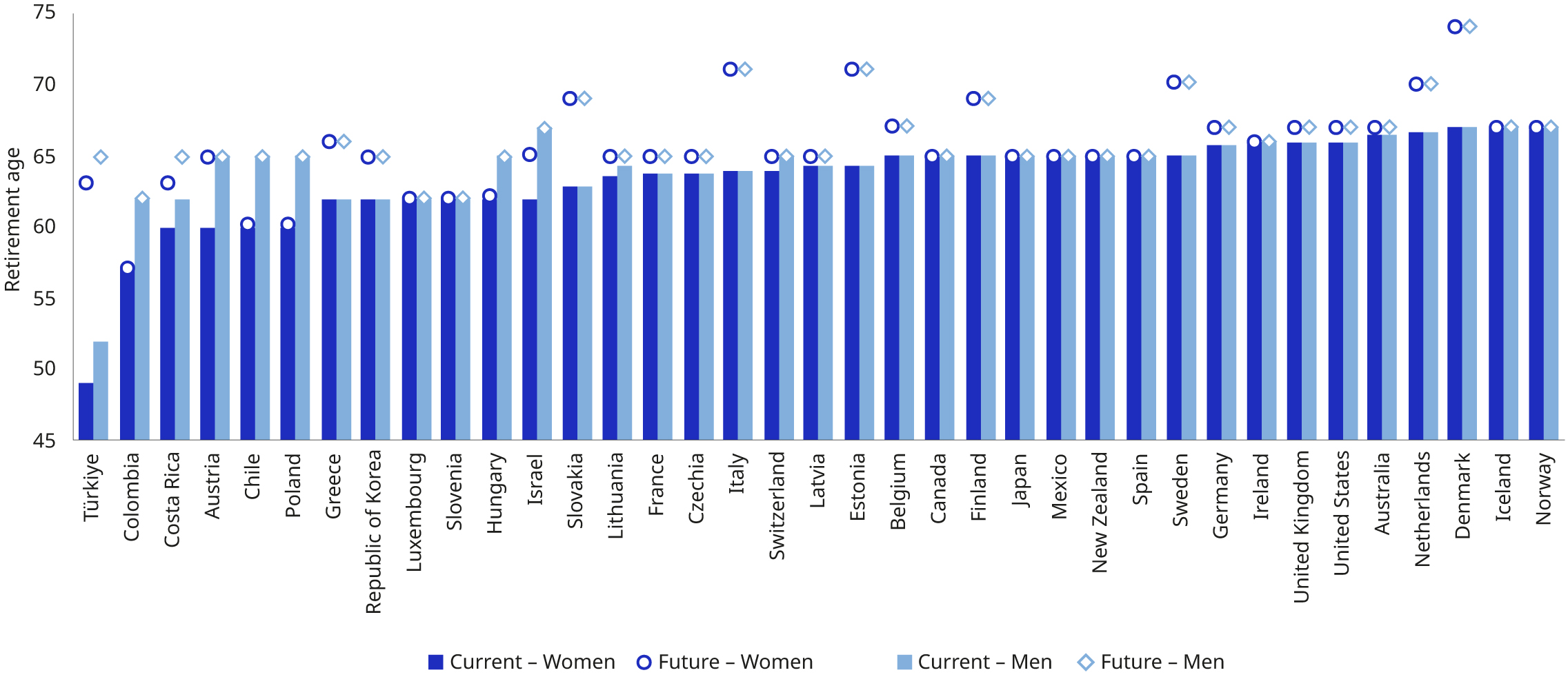
Source: OECD, based on information provided by countries; see “Country Profiles of Pensions Systems”.
Beyond financial sustainability, there are other aspects to consider, such as: increased life expectancy versus healthy life expectancy; ratio of life spent working versus that spent in retirement; labour force participation and pension coverage; and preferential eligibility conditions for arduous jobs. It is never simply a question of mechanically raising the retirement age; there are many aspects to consider, as highlighted by the International Labour Conference (ILO 2013b).
Some might presume that a low retirement age helps reduce youth unemployment, opening up more employment opportunities for younger workers. However, the existence of such a link is not conclusive, since younger workers do not necessarily have similar skills to older workers, and cannot automatically slot into the role of those retiring (Jasmin and Abdur Rahman 2021).
Keeping older workers in the labour force cannot be achieved solely with incentives or disincentives provided via pension provisions. Employment needs to be more attractive to older workers in various ways. Employers need to join the effort and offer flexible work arrangements, skill development opportunities, training programmes, as well as workplace adaptation. Corporate and personal tax incentives could also contribute to a better balance. Increasing labour force participation rates and the share of contributors, including women and non-nationals, also helps to rebalance the ratio of pensioners to contributors (ILO 2021b).
The ongoing trend of increasing retirement age represents a crucial, albeit contentious, strategy to enhance the sustainability of pension schemes given shifting demographic profiles and economic realities. While being a straightforward solution to cost increases, a comprehensive approach that addresses broader social, economic and health-related considerations is needed: a broad perspective that balances financial viability with social justice, health disparities and labour market dynamics.
4.3.9 The climate crisis and the role of pension schemes
Impacts of the climate crisis on pension schemes
The unfolding climate crisis will impact the adequacy and sustainability of pension schemes in several ways, regardless of whether they are fully or partially funded, pay-as-you-go, contributory or tax-financed. Simultaneously, pension schemes can play a huge role in mitigating the drivers of the climate crisis, especially in how the funds are invested.
Climate change will affect demography, economy and investments, impacting pay-as-you-go and fully funded schemes differently. Pay-as-you-go schemes are more affected by demographic and economic factors, while fully funded schemes are more sensitive to investment outcomes.
On the demographic side, the climate crisis will adversely impact the health of populations, either directly (due to increased frequency and severity of extreme events) or via increased temperatures, sea levels, ocean acidity and air pollution. Climate impacts on coastal erosion, food availability and water supplies can also have a socio-economic impact on a given population’s overall health, safety and quality of life, with implications for birth rates, mortality and migration. These health impacts will differ by region, income level, gender, age and comorbidities (IAA 2020).
On the economic side, climate-related risks are generally classified into two categories: physical risks, linked to the frequency and severity of climate events; and transition risks, linked to efforts for a transition towards a lower-carbon economy. Both sources of risks would have an impact on labour force participation rates, employment rates, productivity levels, real wage growth, prices and consumption. For instance, if wages and benefit levels do not keep up with inflation, social security systems may suffer from a labour force with less incentive to contribute to public pension schemes (IAA 2020).
The potential downside is often expressed in terms of reduction of GDP. Indeed, modelling climate change and the reaction of society is extremely complex, requiring assumptions about multiple unknown factors for each scenario. These include (a) future emission levels; (b) how quickly the climate will warm for different emission levels; (c) whether climate or ecosystem tipping points occur; (d) the level of damage as the climate warms, and the effectiveness of mitigation policy efforts; (e) how quickly societies react to physical changes; (f) the pace and scale of the transition in different countries, economies and sectors; and (g) how to incorporate land use, technological change and nature (Trust et al. 2023).
In response, some social security institutions have started to factor into their actuarial valuations the impact of a potential GDP reduction on their pension scheme (see box 4.17).
The ultimate impact of climate change on countries’ GDP will not only depend on the national and global response to the crisis, but also on several factors that are difficult to predict and model. For instance: by how much will the planet warm for a given level of greenhouse gas emissions? How quickly will this warming happen? And what is the highest temperature at which society can still operate normally? By providing answers and making reasonable assumptions as a result, some models suggest that if the world warms by 3°C, countries could lose between 30 and 80 per cent of their GDP. Higher temperature rises of 4–6°C, could cause extreme economic damage, beyond what we can currently predict (Trust et al. 2023).
Box 4.17 The Canada Pension Plan and its illustrative climate scenarios
|
For instance, a recent actuarial report of the Canada Pension Plan analysed downside risks with three scenarios on how the climate crisis could reduce GDP, along with their impact on the Canada Pension Plan’s minimum contribution rate (see table below). The table shows the corresponding decreases in GDP in 2030, 2050 and 2100 as well as their average return in three scenarios involving an orderly, a disorderly/delayed, and a failed transition. Illustrative climate scenarios – Cumulative Canadian GDP impact relative to baseline scenario
|
||||||||||||||||||||||||||||
Source: Government of Canada (2022).
Mitigating the climate crisis
At the end of 2021, the market value of the global capital market (that is, fixed income securities and equities) was US$251 trillion (SIFMA 2022), 24 per cent (US$60 trillion) held by pension funds (public and private).30 For many countries, pension assets represent more than 100 per cent of their GDP, such as Canada (131 per cent), the Netherlands (165 per cent) and Switzerland (133 per cent).31
Pension funds, given their long-term investment horizon, are uniquely positioned to contribute to climate crisis mitigation. For instance, they can divest from high carbon assets toward low-carbon assets. As major shareholders, they can also exercise their voting rights to influence company policies to reduce carbon footprints and promote sustainable business models. They can demand transparency from private equity firms on environmental and community impacts of investments. Strengthening regulations that require pension schemes to report against climate change risks also helps mitigation efforts, including the United Nations Principles for Responsible Investment (box 4.18). Pension funds have already embarked on de-financing fossil fuels (see section 2.2.3).
Box 4.18 United Nations Principles for Responsible Investment
|
Convened by the United Nations Secretary-General, the United Nations Principles for Responsible Investment were developed by an international group of institutional investors and reflect the increasing relevance of environmental, social and corporate governance issues to investment practices. Signatories commit to six fundamental investment Principles:
As of 2024, there were already 5,382 signatories to these Principles, 76 per cent of whom were investment managers, 14 per cent asset owners, and 10 per cent service providers. |
Source: UNPRI (n.d.).
Most large investment management firms have signed the United Nations Principles for Responsible Investment. The research of one investment firm with US$9 trillion in assets shows that an orderly transition would result in higher economic growth compared to no climate action at all, and also create a more constructive overall macroenvironment for clients’ financial returns (Black Rock 2024). Moreover, many investment management firms are also members of industry associations related to sustainability and to the transition to a low-carbon economy, such as:
-
Task Force on Climate-Related Financial Disclosures
-
Taskforce on Nature-related Financial Disclosures
-
Net Zero Asset Managers Initiative
-
Glasgow Financial Alliance for Net Zero
-
Climate Action 100+
Furthermore, most large pension funds, such as the National Pension Service of the Republic of Korea, the National Civil Pension Fund of the Netherlands, the California Public Employees Retirement System, and the Canada Pension Plan Investment Board, are also signatories of the United Nations Principles for Responsible Investment.
However, the fiduciary duties and solvency constraints faced by pension funds in certain jurisdictions create significant financial and regulatory barriers that hinder their ability to fully embrace environmental, social and governance and socially responsible investment strategies. These constraints limit investment actions related to pension savings, operating within a framework of prudence and loyalty to the benefit of the fund’s beneficiaries. Unfortunately, this can act as an impediment to sustainable investment practices.
Conversely, pension fund fiduciaries who fail to consider or manage climate-related financial risks and opportunities, may find themselves personally liable for economic, reputational or organizational losses resulting from that failure. They may also have an obligation to disclose how they manage climate change financial risks and opportunities on an ongoing basis (Bauslaugh 2021).
Following the recommendations of the Task Force on Climate-related Financial Disclosures, most pension schemes are now publishing their objectives on reduction of greenhouse gas emissions in their annual reports as well as metrics on their performance to reach these objectives. For example, the Canada Pension Plan Investment Board has been publishing metrics on the carbon footprint of its investment portfolio in its annual report since 2019. Specifically, between 2019 and 2023, the Canada Pension Plan Investment Board investment portfolio on long-term capital ownership reduced its carbon footprint from 64 tonnes of CO2 equivalent per million of Canadian dollars down to 46 (Government of Canada 2023; 2019). This shows how pensions funds can directly contribute to mitigation efforts.
Pension funds can also contribute to mitigation efforts through their investment strategies. One option is to use financial instruments that finance green projects and provide investors with regular or fixed income payments, such as green bonds. Such investments can help generate financing for the required structural transformation and address climate risks by connecting environmental projects with capital markets, thereby channelling more capital towards sustainable development (World Bank 2021).
Intergenerational equity: From being part of the problem to being part of the solution
Clearly, there are sound ethical and financial reasons for the “greening” of pensions funds to contribute to mitigation efforts and help finance a just transition. However, it would be necessary to monitor the actual impact of all the climate initiatives undertaken by pension funds to make sure that all these promising initiatives are not simply greenwashing.
Pension funds have a responsibility to disclose to their members their environmental, social and governance conformity, as many workers and employers may be unaware of how their pensions contributions might impact the climate crisis. Social dialogue in the governance of funds is essential to make sure that income security in old age does not come at the expense of a viable and liveable planet.
Moreover, the greening of pension funds can be justified from an intergenerational equity vantage point. Current investment practice should not compromise the liveability of the planet for future generations who, without mitigation action, will be saddled with a terribly degraded planet that cannot provide standards of living we enjoy today.
It is time for pensions funds to move from being net contributors to the climate crisis to being net mitigators. They can do this through divesting from fossil fuels in an orderly manner and seek authentically greener investment options. This is both rational and ethical.
.4.4 Social health protection: Towards universal health coverage
Key messages
-
The right to social health protection is not yet a universal reality. Despite laudable progress, barriers to healthcare access remain in the form of out-of-pocket health expenditure incurred by households, physical distance, limitations in the range, quality and acceptability of health services, long waiting times linked to shortages and unequal distribution of health and care workers, and opportunity costs such as lost working time.
-
A legal framework analysis of 164 countries shows that 83.6 per cent of their populations have a right to access healthcare services for free or with limited co-payments. The proportion was less than two thirds in low-income countries, providing a clear illustration of uneven legal coverage across income groups. Furthermore, some regions rely on voluntary mechanisms and/or employer liability, rather than mandatory or automatic mechanisms which are more robust in providing effective protection.
-
Almost two thirds of the global population is effectively protected by a scheme. Coverage has stalled since 2020, showing important implementation gaps. Enhanced legal and effective protection data should be a priority for monitoring progress on coverage and adequacy. This necessary improvement includes the systematic collection of data disaggregated by sex, age, place of residence, disability, migratory status, income levels and socio-economic conditions to track progress on equity.
-
Out-of-pocket expenditure on healthcare is increasing globally and pushed 1.3 billion people into poverty in 2019. Collective financing, broad risk pooling and rights-based entitlements are key conditions to support effective healthcare access for all in a shock-responsive manner. The principles provided by ILO standards are more relevant than ever on the road to universal health coverage. Ratification of ILO Conventions Nos 102 and 130 is a key marker of long-term commitment.
-
Investing in the availability of quality healthcare services is crucial. This requires improved working conditions, social protection coverage and contractual modalities of millions of health and care workers. The COVID-19 pandemic further pushed workers out of the sector, jeopardizing any strategy to extend access to healthcare without hardship delivered by well-trained, supported and motivated staff.
-
Stronger linkages and better coordination between access to medical care and income security are urgently needed to address key determinants of health. The climate crisis is directly impacting people’s health, while also exacerbating existing socio-economic inequalities, which act as powerful determinants of health equity. Health and well-being should not be the privilege of the few, and the inequalities triggered by the climate crisis call for urgent investments.
4.4.1 The crucial role of social health protection for a just transition
Climate change impacts human health (see Chapter 2) and the financial capacities of households to cope with increased healthcare expenditure. Thus, robust, adequately prepared and equipped social health protection systems are needed (ILO 2024f). Social health protection includes a series of public or publicly organized and mandated private measures to achieve effective access to affordable healthcare services and adequate sickness benefits for all (see section 4.2.3). Both are supportive of the objective of universal health coverage. The second political declaration of the high-level meeting on universal health coverage, adopted by the United Nations General Assembly in September 2023, recognizes the fundamental importance of “social protection mechanisms … to ensure universal and equitable access to quality health services without financial hardship for all people” (UN 2023c). The SDG targets on universal health coverage (3.8) and universal social protection (1.3), are synergetic priority measures aimed at achieving a healthy and dignified life for all. The lack of affordable quality healthcare risks creating both poor health and impoverishment, impacting the most vulnerable. Consequently, the principle of universality of coverage was underlined in social security standards early on (box 4.19).
Box 4.19 ILO standards on access to healthcare without hardship
|
Universality and coverage extension: In 1944, the Medical Care Recommendation (No. 69) introduced the principle of universality, setting out that access to healthcare services without hardship should be secured for all members of the community, “whether or not they are gainfully occupied” (Para. 8).1 Population coverage: As a priority, coverage should be extended to the entire population across four basic guarantees, one of which is essential healthcare without hardship as per ILO Social Protection Floors Recommendation, 2012 (No. 202) (ILO 2021a; 2017b; 2019f). Adequacy of coverage: Countries should progressively improve the comprehensiveness and level of healthcare benefits, ensuring higher protection. ILO standards establish a minimum level of benefit to be guaranteed by law. The benefit level encompasses two dimensions:
Financing and institutional arrangements: ILO standards promote collectively financed mechanisms, recognizing recourse to a range of taxes, and contributions made by workers, employers and governments. Likewise, the standards recognize a range of institutional arrangements, namely national health services, by which public services deliver affordable health interventions, and national health insurance, through which an autonomous public entity collects revenues from different sources to purchase health services, from public providers only, from both public and private providers or from any combination of such institutional arrangements. 1 The right to health was subsequently formally enunciated by human rights instruments: the Universal Declaration of Human Rights, 1948 and Article 12 of the International Covenant on Economic, Social and Cultural Rights. The human rights to health and social security are understood as the obligation to guarantee universal effective access to adequate protection (UN 2008; 2019b). Social health protection is rooted in this framework and represents the optimal mechanism to substantiate these human rights (ILO 2020j). |
The climate crisis engenders changes that directly and indirectly impact human health, including adverse extreme weather events (affecting mortality and morbidity), greater suitability for communicable diseases, vector-and water-borne diseases and the emergence of new diseases and health security threats such as pandemics, as well as their interplay with non-communicable diseases (Romanello et al. 2021). Furthermore, indirect impacts include disruption to livelihoods, food systems and human mobility, and the overall intensification of socio-economic inequalities (Romanello et al. 2023), which act as determinants of health equity.
Responding to the climate crisis requires both access to healthcare without hardship and income security as mutually reinforcing instruments to tackle inequality and promote greater human health and well-being that are respectful of the planet. Advancing social health protection in coordination with other life-cycle social protection guarantees and health system strengthening efforts, creates the opportunity to further address the social determinants of health (Commission on Social Determinants of Health 2008; WHO 2019b). Such coordination establishes a common agenda to mobilize fiscal space for health and social protection, and crucially ensures no one is left behind.
The cost of ignoring these trends is anticipated to be far higher than acting now (Romanello et al. 2023). Institutions in charge of social health protection need to act now to continue to meet population needs and to anticipate covariate risks that impact expenditure and operations (see figure 4.40), including:
-
ensuring universal health coverage by rapidly extending social health protection coverage to all, throughout the life cycle, with a focus on uncovered groups most impacted by climate change;
-
reviewing the design of social health protection benefits to ensure their responsiveness to the changing burden of disease induced by climate change, and to maximize health and climate action;
-
adapting the management and administration of schemes to: (a) minimize their greenhouse gas emissions; (b) implement purchasing strategies that incentivize greenhouse gas emission reduction and non-renewable waste from health and social care service providers; and (c) adapt registration and benefit delivery systems to persons facing adverse climate events and/or displacement;
-
securing robust and sustainable financing adapted to the changing circumstances of social health protection and adequately coordinated with health, climate and disaster risk management policies and other social protection benefits; and
-
closing the research gap on strategies and practices that social health protection institutions have successfully established to address those challenges.
Figure 4.40 Social health protection for climate action
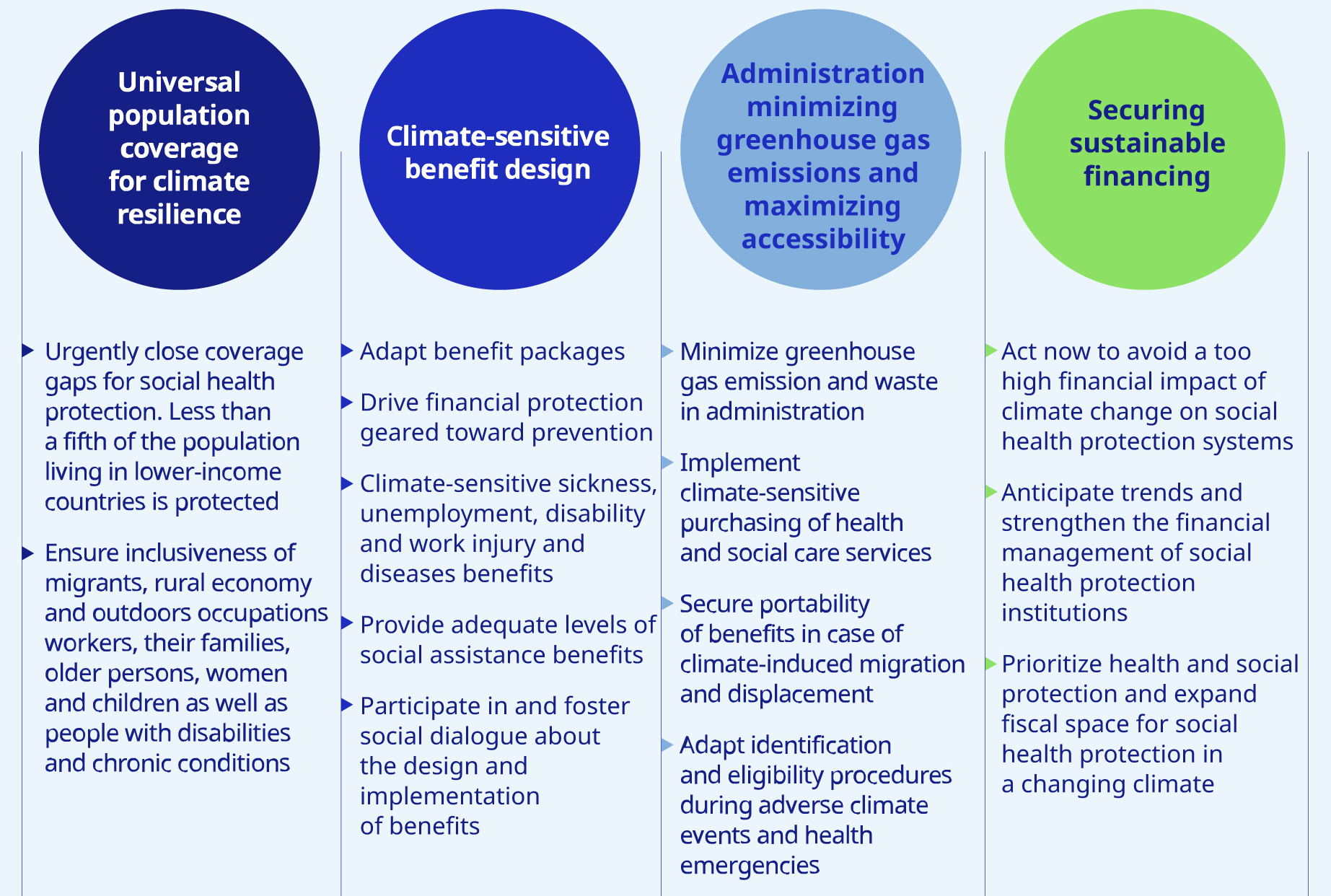
Source: ILO (forthcoming d).
Monitoring progress in social health protection requires considering population coverage and benefit adequacy (that is, the range of health services covered and the extent of financial protection), both in law and in practice. The SDG framework fosters additional data collection and provides proxies for such dimensions relating to effective coverage (WHO and World Bank 2020). Nevertheless, enhanced data are needed – particularly on legal coverage, public awareness and care quality – as they are all still poorly or unsystematically captured (Kruk et al. 2018). The complexity and interdependency of these dimensions, and lack of systematic data collection make monitoring social health protection difficult. Available indicators and important data gaps are discussed below.
4.4.2 Population coverage
Legal coverage
Social health protection is anchored in the human rights framework and entitlements to it must be enshrined in national legislation. Based on a legal review in 164 countries, 83.6 per cent of the global population is legally entitled to access healthcare services without hardship (see figure 4.41). Therefore, almost one in five individuals live in countries that do not legally recognize such entitlements. This proportion is twice as high in low-income countries and concerns only slightly more than half of Southern Asia’s population. Interestingly, several countries, in particular in Africa, expanded the scope of legal coverage in the last decade. Some countries, such as Comoros, Côte d’Ivoire, Morocco and Sierra Leone materialized their commitment through the recent ratification of Convention No. 102, including the part on medical care provisions.
Figure 4.41 Share of the population legally entitled to access healthcare services without hardship, by region, subregion, income level and type of mechanism, 2023 (percentage)
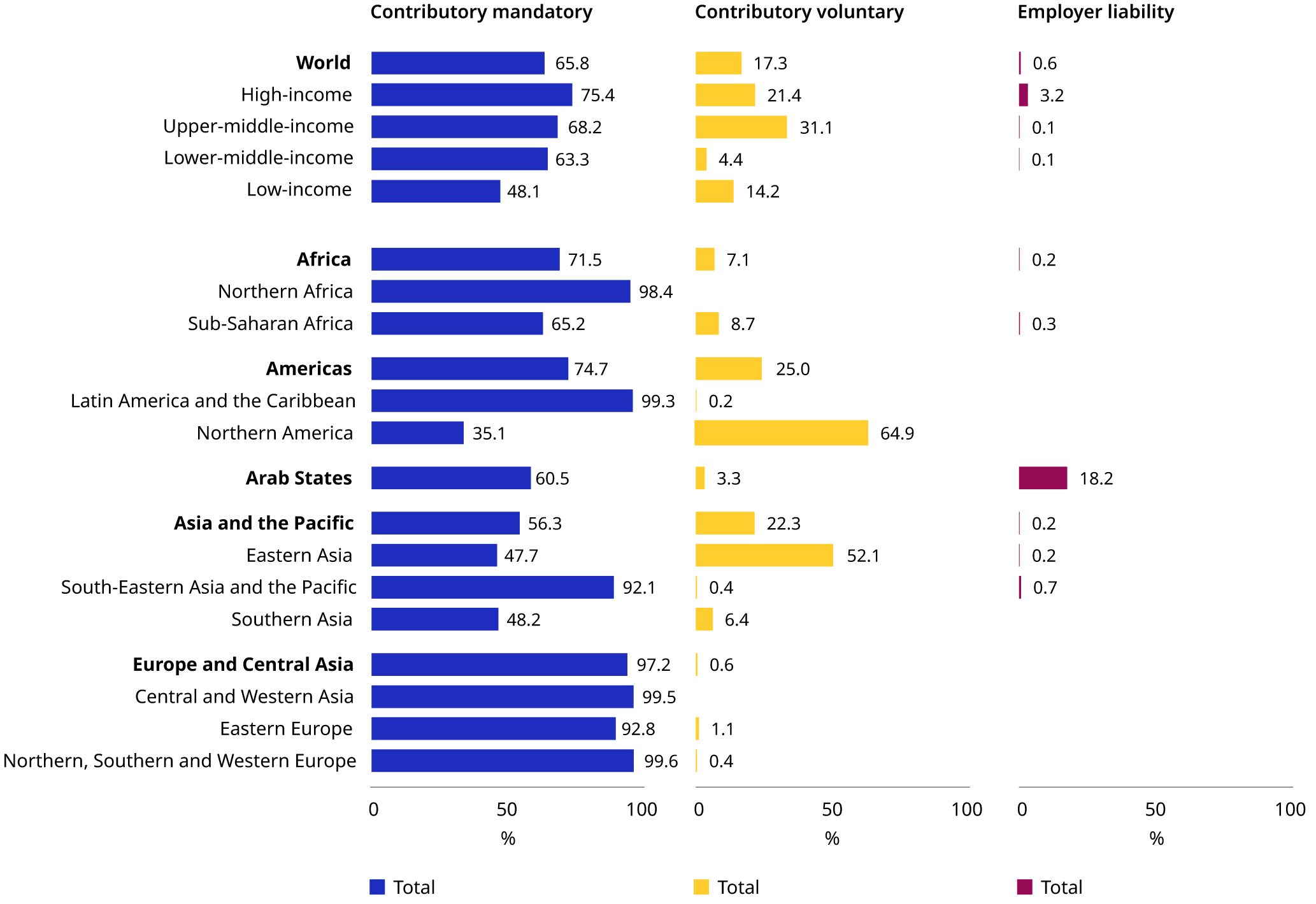
Note: Global and regional aggregates are weighted by population.
Sources: ILO estimates; World Social Protection Database, based on the Social Security Inquiry; ISSA Social Security Programs Throughout the World; ILOSTAT; national sources.
In some regions of the world, countries rely on voluntary rather than mandatory provision for some population groups. For instance, this concerns two thirds of Northern America’s population and half of Eastern Asia’s. In the United States, the workforce is largely left to access health insurance through voluntary provision, despite reforms. Countries with such guarantees in the law – as well as those where mandatory or automatic coverage is not effectively enforced – face difficulties in implementing universal population coverage in practice for several reasons, including a lack of adequate financing mechanisms and awareness (ILO 2021d). This can lead to either requesting contributions from protected persons that are incommensurate with their financial means32 and/or to reducing benefit adequacy through less comprehensive benefit backages, lower cost coverage and/or low-quality service. This effectively makes them unattractive or inaccessible to right-holders (ILO 2021d).
Some countries place an obligation on the employer to either pay for the healthcare costs incurred by their employees or contract voluntary private insurance on their behalf. In the Arab States, the high proportion of the population legally covered through this mechanism – almost one in five persons – mainly comprises migrant workers (ILO 2023s; 2023r). These workers are typically engaged in sectors that are poorly protected from both labour and migratory standpoints (ILO, ISSA and ITCILO 2021). As evidenced throughout this chapter, employer liability is not a robust substitute for social protection mechanisms. When it comes to healthcare expenditure, such mechanisms play a small role globally and do not allow broad risk pooling (WHO 2021). Furthermore, employer liability provisions may reinforce asymmetric contractual arrangements for migrant workers (ILO 2020b; 2023r).
A greater effort is needed to translate international commitments to human rights and international social security standards into national legislation. Inequalities between country income groups and regions in this respect need to be urgently addressed. In some contexts of extreme fragility, international protection has been awarded to populations under the mandate of the Refugee Convention, 1951. The climate crisis is likely to create conflicts over resources which may sometimes be of a protracted nature. Strong national legal frameworks aligned with international instruments are thus needed more than ever. They hold the potential to help bridge the humanitarian-development nexus, as they encompass solutions adapted to the entire migration cycle (see section 2.1.2).
Effective protection and awareness of entitlements
For individuals to effectively access health services without hardship when needed, it is important for such access to be considered a right and to be embedded in the legal framework. It is equally important for individuals to be aware of their legal entitlements and the modalities to avail themselves of such entitlements. A proxy indicator is the share of population protected by a social health protection scheme, based on a combination of administrative and survey data (see Annex 2). In striving for universal protection, a large number of countries across all income levels have made laudable progress in extending the effective reach of social health protection mechanisms over the past decades, resulting in 60 per cent of the world’s population being protected by a scheme (figure 4.42).
The global coverage rate has stalled, with almost no progress since 2020. Coverage varies strongly across economic development levels, showing stark inequalities and an uneven trend between 2020 and 2023 (figure 4.42). Coverage in low-income countries even decreased slightly. Therefore, more than four in five persons in low-income countries are left unprotected. Slight progress in high-income countries was driven by the implementation and progressive take-up of the amendments to the Affordable Care Act adopted in the United States. While coverage slightly increased in lower-middle-income countries, there was a setback in the upper-middle-income category, driven by a decrease in coverage in China, where it remains voluntary for some population groups. Southern Asia and sub-Saharan Africa remain far below global averages. Low-and lower-middle-income countries, as well as sub-Saharan Africa and Southern Asia, experience the largest gaps between legal coverage and effective protection, illustrating difficulties in enforcing legal frameworks and in giving effect to people’s rights in practice.
A better measure of effective coverage must include within-country inequalities across different population groups. Indeed, coverage gaps tend to mirror social, economic and geographical inequalities. For instance, analysis of available data for 58 countries shows that a lack of money to pay for health services is invoked as a reason for forgoing care among women aged 15 to 49 across the household income spectrum. The pattern follows a clear social gradient, with over 65 per cent of women in the lowest income quintile invoking the same explanation, while almost 30 per cent invoke it in the richest quintile (WHO and World Bank 2023). Distance to a health facility was also invoked by almost half of the rural women surveyed, while having to take transportation was invoked for 40 per cent of them (WHO and World Bank 2023). Upholding the right to social health protection is therefore of utmost importance in countries’ endeavours to address health-related gender inequality.
Figure 4.42 Share of the population protected by social health protection (protected persons), by region, subregion and income level, 2023 or latest available year (percentage)
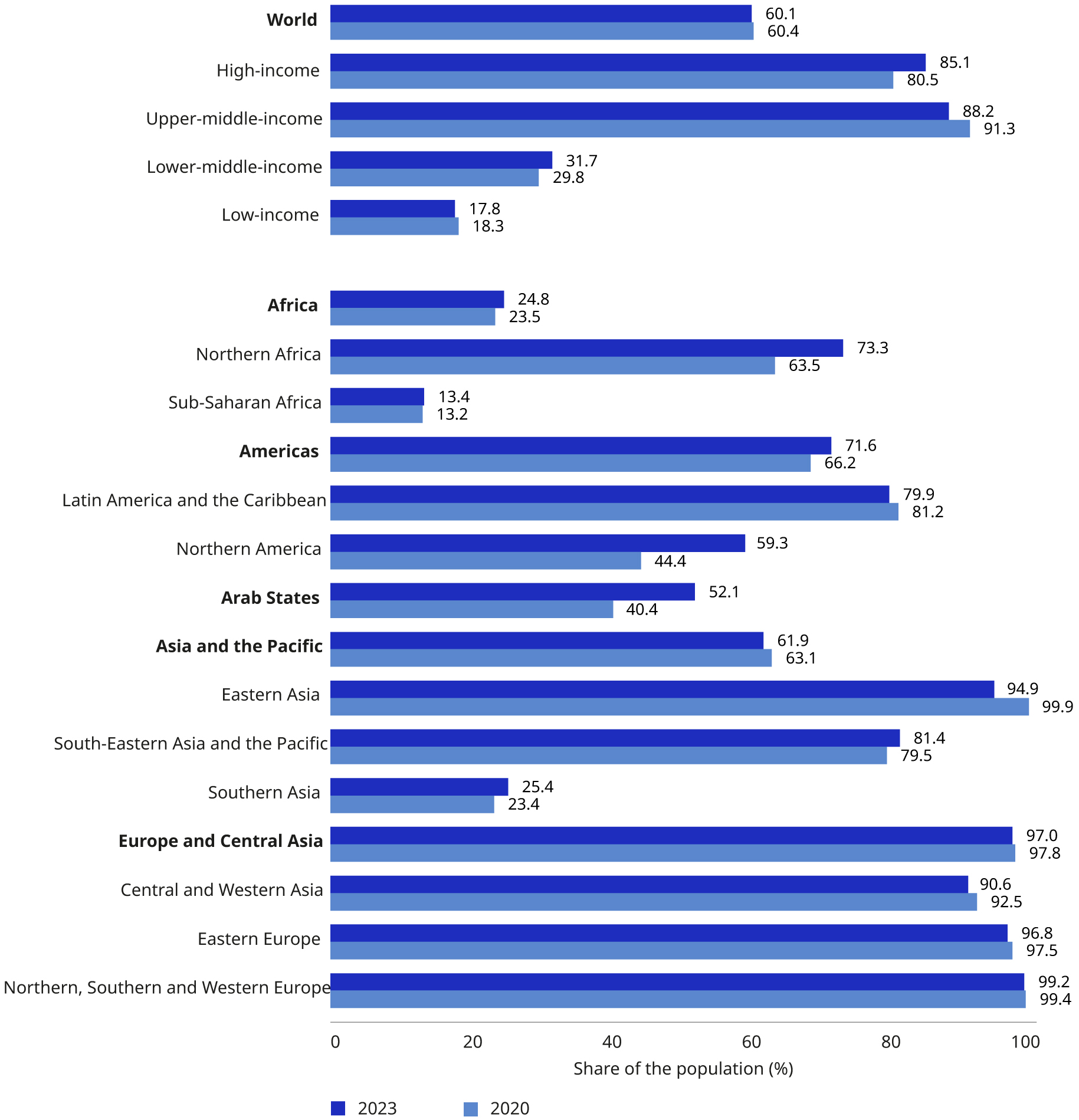
Notes: Based on data collected for 127 countries and territories representing over 90 per cent of the world’s population. Regional estimates are weighted by the total population. The figure represents the best estimate of people protected by a healthcare scheme for their primary coverage. Mechanisms include: national health insurance; social health insurance mandated by the State (including subsidized coverage for the poor); national healthcare services guaranteed for free or with small co-payments; and other programmes (such as user fee waivers and vouchers). For primary coverage, 202 schemes were identified and included. This is substantially more than in 2020. Therefore, in order to generate trends, the 2020 estimates were recalculated, including the new countries and schemes for which data points are available in both periods. Only public or publicly mandated privately administered primary healthcare schemes were included. Supplementary public and private programmes were not included.
Sources: ILO estimates; World Social Protection Database, based on the Social Security Inquiry; and OECD Health Statistics 2023; national administrative data published in official reports; information from regular national surveys of target populations on awareness of rights.
What creates gaps in population coverage?
Gaps in population coverage can be rooted in legal provisions, implementation and, most often, a combination of both, compounded by lack of adequate financial resources. Such gaps largely overlap and reinforce existing socio-economic inequalities. Social health protection policies should aim primarily at addressing these gaps, levelling the playing field with regard to financial protection when accessing healthcare.
Eligibility restrictions
Employment or income status
In some countries, especially in sub-Saharan Africa and Southern Asia, legal frameworks still exclude some population groups based on employment or income status. Provisions often exist for employees in the formal sector (or sometimes only civil servants) and for the poor and/or children under a certain age threshold, but not for the entire population. For instance, in India, several public schemes cover different categories of the population: civil servants, railway personnel, and military and private sector salaried workers are mandatorily covered by different schemes. The population below the poverty line is registered in the PM-JAY scheme, while the rest of the population is left without public options in many states (ILO 2021d).
Even when legal provisions exist, countries that rely largely on voluntary legal provisions, such as the United States, also have greater difficulties in making progress in practice. Among the countries that rely on voluntary mechanisms in the law or in practice, most only do so for specific groups, often based on employment status, and often excluding some workers in temporary, part-time and self-employment (ILO 2021d).
Contribution or premium payment by the individual
International social security standards promote collectively financed mechanisms, in particular taxes, and social contributions made by workers, employers and governments. Scheme-level data indicate that most countries rely on a diversity of financing mechanisms, and that both social contributions and taxes play a strong role in financing social health protection.
While it is advisable to combine various sources of funding to ensure the maximum allocation of public resources for the population to access health services without hardship, it is crucial that financing arrangements should not create barriers to eligibility. International social security standards recognize the principle of universality, stipulating that access to healthcare services without hardship should be secured for all, “whether or not they are gainfully occupied” (ILO Recommendation No. 69). Countries wishing to use social security contributions or regulated insurance premiums must put in place non-contributory mechanisms that guarantee mandatory coverage for all.
It is equally important that countries wishing to collect social security contributions or regulated insurance premiums as part of their social health financing mix (a) consider the needs of workers in diverse employment situations and (b) avoid putting the burden of contributions solely on households, which would impact disproportionately low-income earners. Contribution levels need to be based on actual ability to contribute and be part of a wider financing mix that avoids regressive taxation (see section 3.4.3).
Migration status
Eligibility for social health protection is often restricted for non-nationals, in law or in practice. This is of growing public health concern, since human mobility, whether voluntary or forced, within or across countries, is happening on an unprecedented scale and is anticipated to grow with climate change (UNHCR 2023; IOM 2023). It is therefore imperative to extend social health protection entitlements to non-nationals based on equality of treatment. It is also necessary to ensure the portability of healthcare entitlements for migrants, including refugees, and to provide adapted ser vices (see section 2.1.2) (IOM 2019; Orcutt et al. 2020; ILO, ISSA and ITCILO 2021). Some countries are making efforts towards the inclusion of refugees in their social health protection system, despite numerous challenges (see box 2.9). This tends to be more difficult for countries with large influxes and/or weak or nascent social health protection systems with low coverage and low institutional capacities (ILO and UNHCR 2020).
Low awareness of rights
Raising public awareness of rights and entitlements, combined with efforts to improve health literacy, is essential for empowering people to demand healthcare services. Entitlements can only play a role in improving quality, accountability and trust in the system when people understand them and how to avail themselves of them. Institutions in charge of social health protection can and should contribute to this effort (see box 4.20). Such steps should coincide with interventions to improve benefit adequacy (see section 4.4.3), scheme accountability and the associated perceptions of fairness and trust in the system (ILO 2021h).
Box 4.20 Efforts to monitor the satisfaction of public health insurance beneficiaries in India
|
The Employees’ State Insurance Corporation, which is one of the biggest public health insurance schemes in India, conducted a study capturing the health-seeking behaviour of protected persons and registered employers as well as their awareness and attitude. The findings underscore the differential experiences and perceptions of beneficiaries in the diverse implementation contexts of four states. The results highlight that, while the Employee State Insurance Corporation beneficiaries appreciate the extensive benefit package, they would gain from stronger awareness of their entitlements. An important area of focus for increasing overall service utilization would be the provision of primary healthcare services. The scheme can contribute in a larger way to universal health coverage by increasing outpatient and inpatient healthcare service utilization at its facilities. One option, as the study indicates, would be to actively track and improve the levels of beneficiary satisfaction. |
Source: ILO (2022a).
Moreover, institutions in charge of social health protection have a fundamental duty to ensure accessibility and inclusivity by adapting information on rights and entitlements for vulnerable population groups, such as persons with disabilities, ethnic minorities and the illiterate. This adaptation involves employing various communication channels, formats and languages to effectively reach these communities. By doing so, these schemes can empower individuals within these groups to better understand and exercise their entitlements, thereby promoting equitable access to healthcare services. Ultimately, this proactive approach fosters a more inclusive and fair social health protection system for all.
Unattractiveness due to complex administrative procedures, perception of low quality of healthcare services, or a combination of those factors
Geographic distance, complex and lengthy administrative procedures, cultural differences, administrative illiteracy, issues related to identification documents, can be important barriers. They disproportionately affect rural populations and vulnerable population groups such as persons in precarious employment and migrants (ILO 2021d).
When investments in the supply of healthcare services that are included in social health protection mechanisms (usually public healthcare providers, and sometimes also private ones) are insufficient and affect users’ perceptions of quality, the incentive for people to use such mechanisms is low. Lack of geographical accessibility, lack of perceived quality or ill-adapted services are all elements of benefit adequacy that strongly impact the attractiveness and use of social health protection. Consequently, strategies to reduce the financial barriers of access cannot be devised without also considering the need for health system strengthening.
4.4.3 Adequacy
Legal entitlements as well as registration or regular monitoring of entitlement awareness presented in the previous section do not automatically translate into effective access to available, accessible, acceptable and quality healthcare services at times of need. Many barriers can remain, compromising adequacy:
-
The availability, accessibility, acceptability and quality of healthcare services may be poor, not allowing effective access in practice or access at a level that would allow improvements in health status.
-
Benefit packages may be limited, covering few services and leaving patients to cover high out-of-pocket expenses.
-
High official co-payments or informal payments may be requested, leaving an important share of the total costs of care to be borne by patients.
A systematic way of collecting data is urgently needed to understand the extent to which core elements of adequacy (benefit packages, costs covered and network of providers) are guaranteed by law. Nonetheless, data available for SDG indicators 3.8.1 and 3.8.2 provide some insights into the effective coverage for these aspects, as displayed below. Improving the national and global monitoring of quality of care and patient experience indicators is equally important (Kruk et al. 2018).
Legal entitlements to adequate healthcare services and financial protection
Given the importance of the range of services and level of benefit offered for social health protection to be effective, their grounding in the national legal framework should be a matter of priority to guarantee people’s rights to health and social security. Bridging the current data gap for these dimensions is urgently needed. While some systematic information collection exists for European countries, it is not the case for other countries and regions (see Annex 2).
When legal frameworks provide differentiated entitlements in terms of benefit packages, cost coverage and/or dedicated network of healthcare providers, they can reinforce inequalities and fail to contribute to social cohesion. Some countries have made progress in defining a unique benefit package to be accessed by their entire population without co-payment or with low co-payments for all in a unified network of service providers. Other countries, however, have not yet overcome a segmentation in entitlements embedded in their legal frameworks. For instance, a review of legal frameworks for social health protection in El Salvador, Guatemala and Honduras showed that, despite legal entitlements for the entire population, the nature of those entitlements in terms of the range of services covered, and/or the network of service providers from which to avail services, is different across population groups (ILO, forthcoming c). For social health protection mechanisms to maximize their contribution to health equity, the careful design of legal entitlements is crucial. When people are entitled to access the same services in the same facilities, a clear pathway towards greater equity is laid out. This needs to be done in a way that levels the playing field towards higher levels of protection and avoids levelling down benefits.
Effective service coverage
Despite the adoption of a dedicated SDG on health and well-being, more than four decades after the Declaration of Alma-Ata on primary healthcare, over half of the world’s population do not receive essential health services when they need them, with large disparities across countries (WHO and World Bank 2023). Though more data is needed to analyse the situation across a wider range of services, the monitoring provided by SDG indicator 3.8.133 clearly shows that the basic package guaranteed by ILO standards34 is inaccessible for the majority of the world’s population (figure 4.43).
Figure 4.43 SDG 3.8.1 Universal Health Coverage Service Coverage Index – Average coverage of essential health services, 2021 or latest year available (percentage)
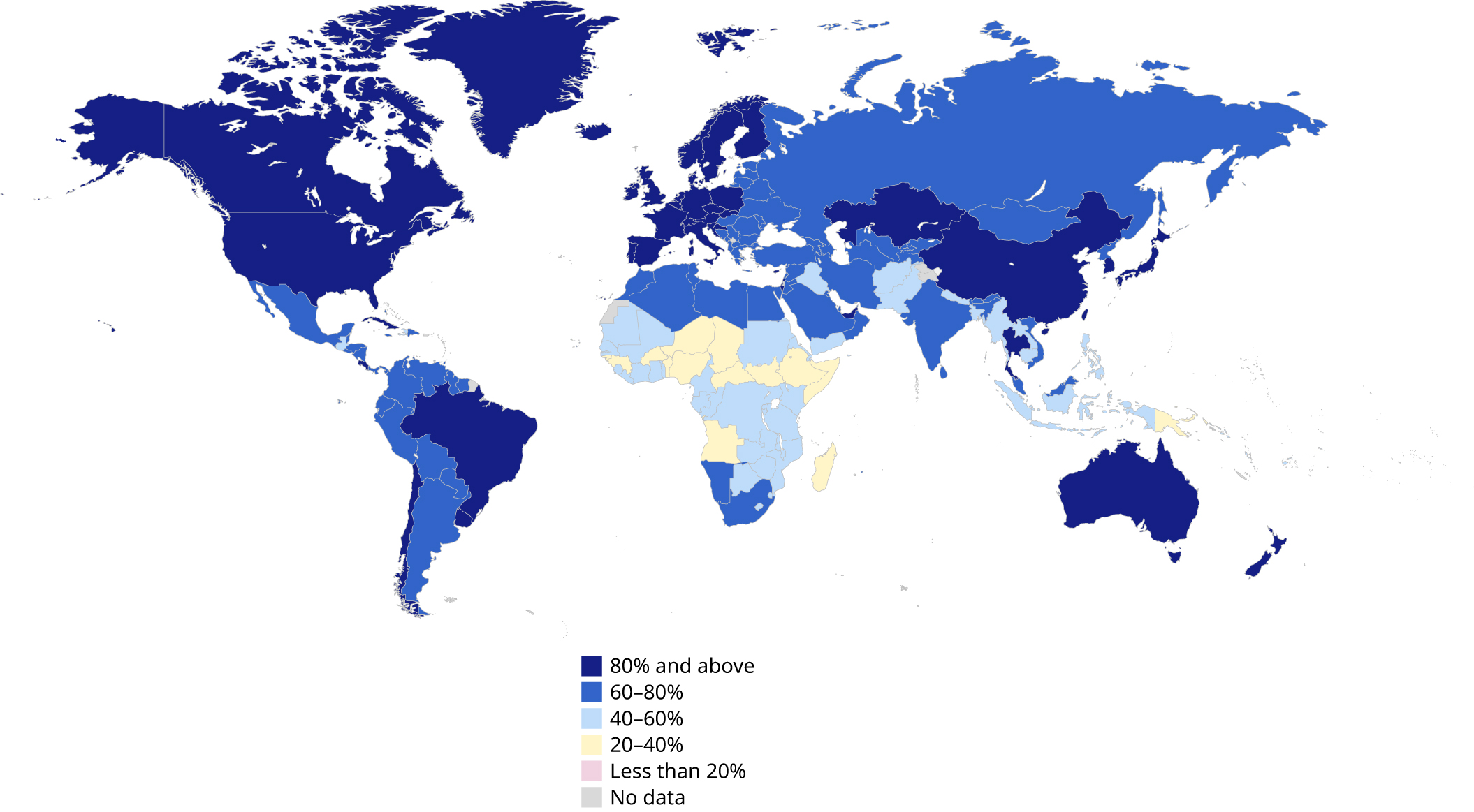
Disclaimer: Boundaries shown do not imply endorsement or acceptance by the ILO. See full ILO disclaimer.
Source: Based on data from the WHO Global Health Observatory.
The Service Coverage Index, measured by SDG 3.8.1, increased as essential interventions were made accessible to an estimated 10 additional percentage points of the global population over the past decades. Yet, progress is largely due to improved access to services related to communicable diseases, and particularly greater availability of HIV anti-retroviral treatment (WHO and World Bank 2023). The related health spending tends to rely on international sources for a number of low-income countries, meaning that the progress achieved may be threatened by decreasing international aid budgets. Efforts towards the integration of single-disease programmes within existing health schemes and systems would ensure sustainability of these health gains.
Analysis shows that progress in the other subindices was slower and even stagnated after 2015 ( WHO and World Bank 2023). Remaining service coverage deficits are unevenly distributed across geographical locations, income levels, population groups and types of health interventions (Lozano et al. 2020). For instance, deficits are particularly severe for interventions addressing non-communicable diseases, while there is a shift towards these conditions in the global burden of disease due to lifestyle changes and population ageing, which is worsened by climate change effects (Vos et al. 2020; Tessier, De Wulf and Momose 2022). Similarly, progress in interventions that are considered particularly cost-effective, such as reproductive, maternal, newborn and child health, have been both slow and uneven across and within countries (see section 4.2.2).
Disaggregated data (by sex, age, location, migration status and income) is needed to identify more thoroughly the population groups left behind and devise inclusive policies (Lozano et al. 2020). Yet, recent analysis already illuminates the importance of the social gradient and the array of social, economic and geographic determinants of access to reproductive, maternal, newborn and child health services (see section 4.2.2). Important inequities in access remain both across regions (see figure 4.44) and wealth quintiles (see figure 4.45). More efforts are needed to ensure access to free, quality maternity care in line with ILO standards (see box 4.19), and to expand maternity cash benefits (see section 4.2.2). Access to both quality healthcare and income security is essential to ensure a healthy pregnancy, childbirth and post-partum period (Shaw et al. 2016). This reduces maternal and infant mortality, and ensures that pregnancy and childbirth do not jeopardize women’s rights, including their right to work and rights at work (see box 4.21).
Figure 4.44 Unequal advances in service coverage for reproductive, maternal, newborn and child health services, by region and type of service, 2023 or latest available year (percentage)
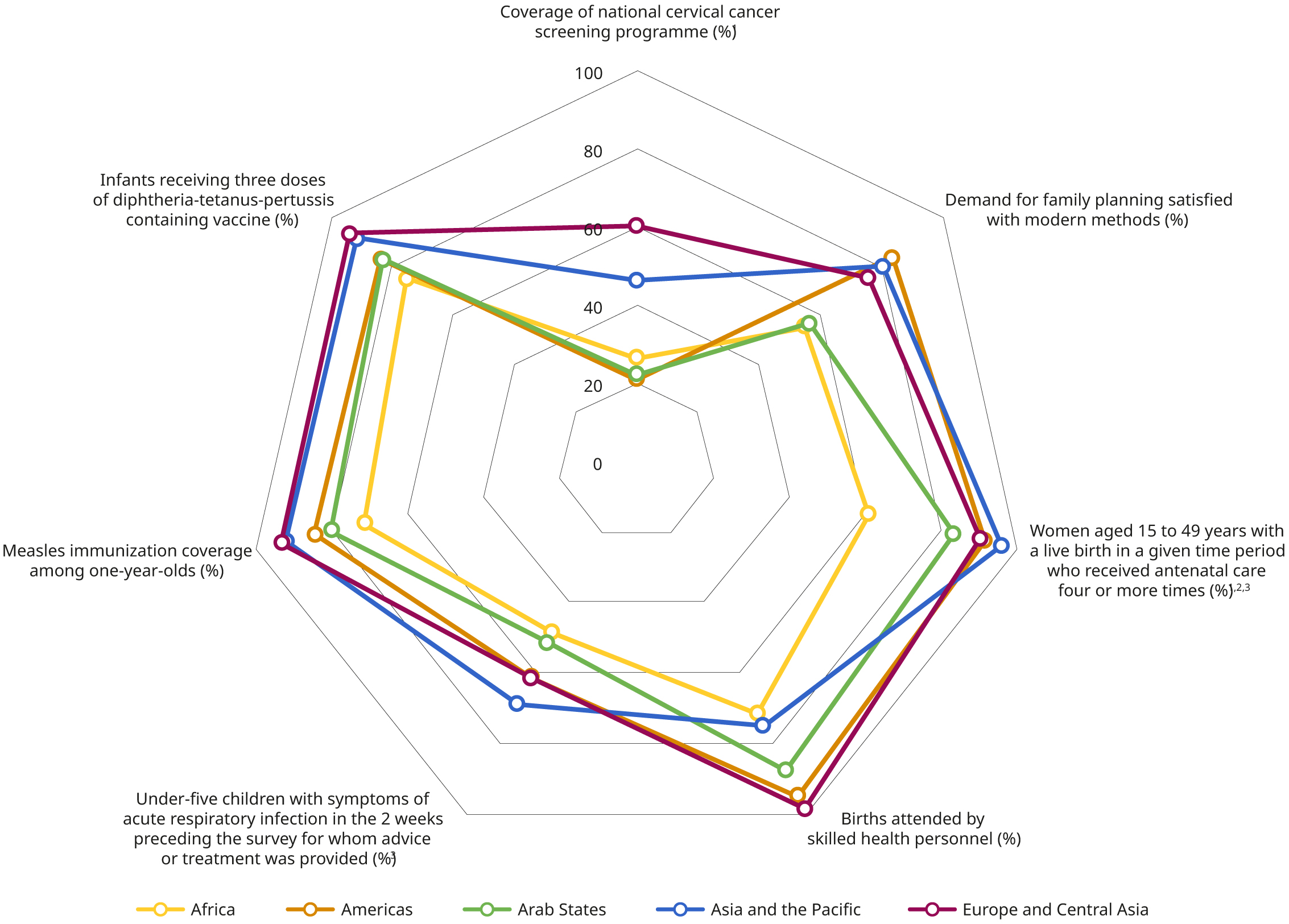
Notes: To be interpreted with caution – estimates based on reported data coverage below 40 per cent of the population: ¹ Africa and Arab States; ² Europe and Central Asia; ³ Asia and the Pacific, and Europe and Central Asia. Regional estimates are weighted by total population.
Source: ILO estimates based on data from the WHO Global Health Observatory.
Figure 4.45 Inequities in access to maternal healthcare services: Share of live births attended by skilled health personnel by wealth quintile, selected countries by region, 2019 or latest available data (percentage)
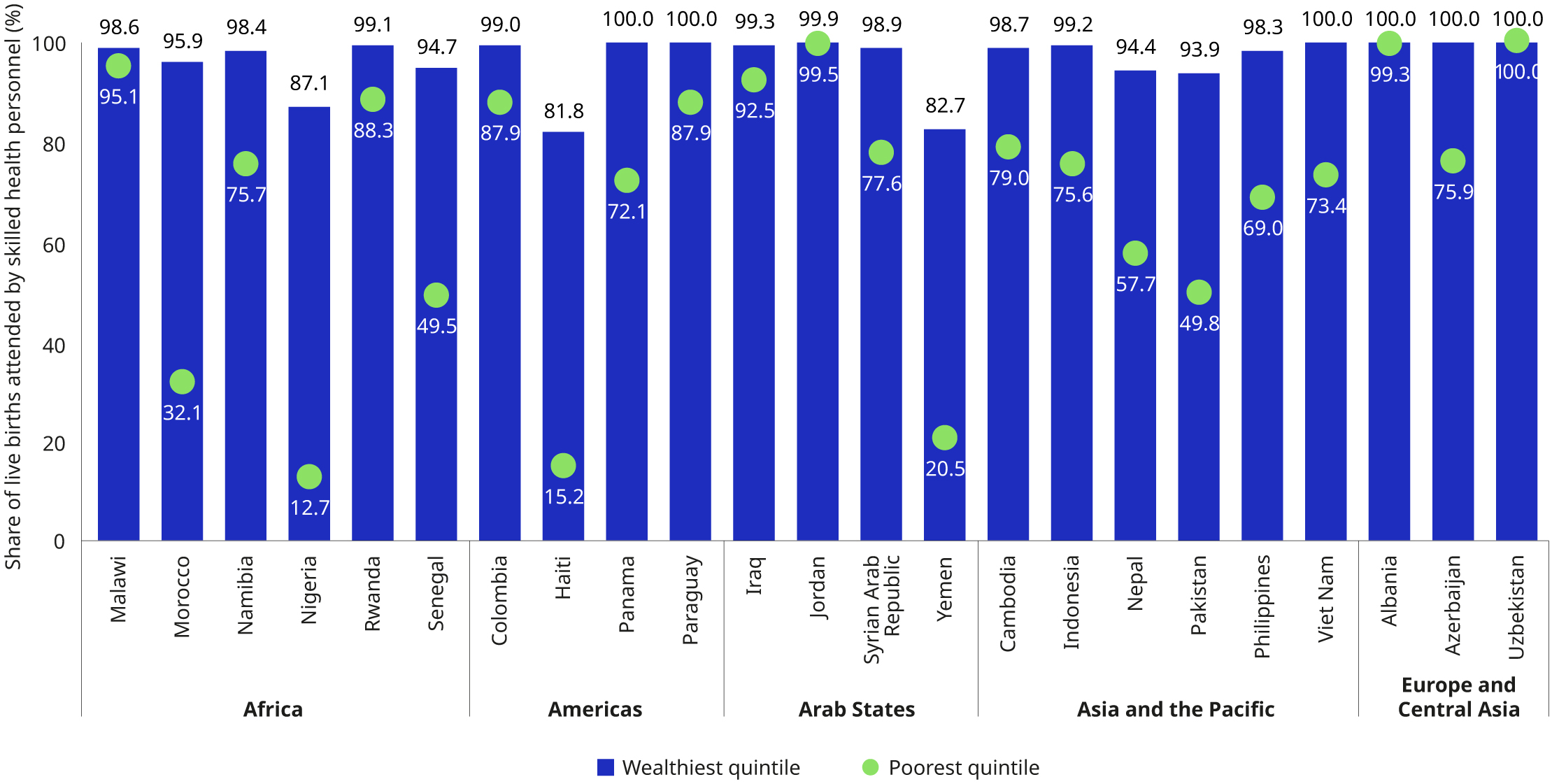
Source: ILO estimates based on data from the WHO Global Health Observatory.
Alongside medicine and medical devices, a central component of the availability of healthcare ser vices is investment in infrastructure and equipment, and the recruitment and retention of a qualified health workforce (ILO 2022k). This applies for both public and private health sectors (section 4.3.3 and box 4.22). Important inequalities persist across countries and regions, and between rural and urban areas when it comes to the availability of such physical and human resources (see figure 4.46).
Figure 4.46 Deficits in staff and infrastructure at the heart of inequalities in access to healthcare, 2022 or latest available year
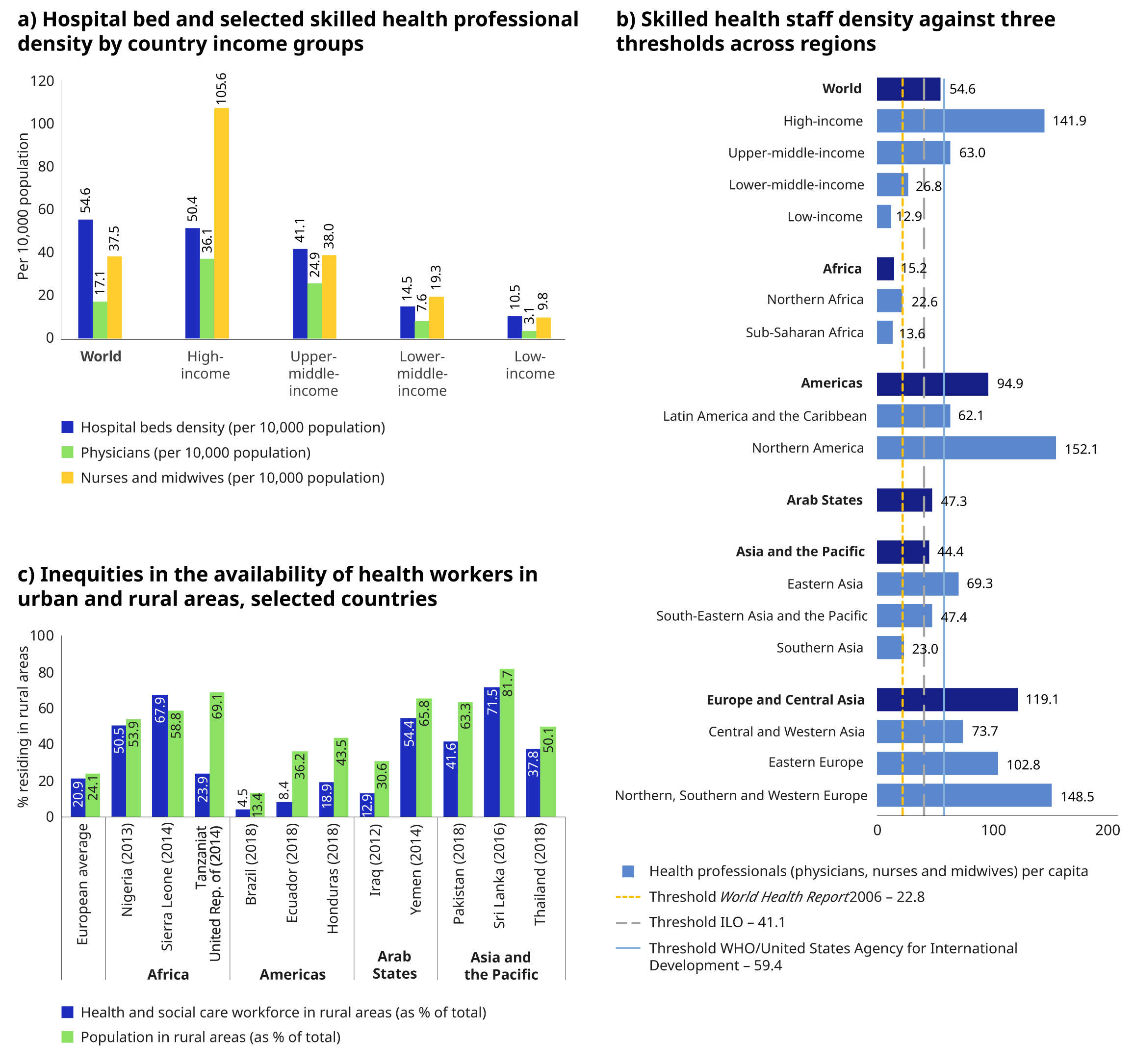
Notes: More details on the use of those reference points can be found in GHWA and WHO (2013). The European average represents 28 countries for which data were available (see Annex 2). See also: ILO (2023v). Regional and income level estimates are weighted by total population.
Source: ILO Labour Force Surveys, ILO-OECD-WHO Working for Health Programme and the WHO World Health Observatory.
Box 4.21 Strategies to reduce the cost of maternity care in Asia
|
Some countries exempt maternal or child healthcare services from co-payments, such as the Lao People’s Democratic Republic, Malaysia, the Republic of Korea and Viet Nam. In Malaysia, the majority of maternal health services are exempted from user fees that apply to other services. Success in reproductive, maternal, newborn and child health outcomes for Malaysia is attributed in part to this policy. A similar strategy has been adopted in Brunei Darussalam with comparable success. Similarly, the Philippines’ National Safe Motherhood initiative has been successful at ensuring availability of services and PhilHealth coverage for reproductive, maternal, newborn and child health services. Under this programme, all women about to give birth are automatically enrolled in PhilHealth through point-of-care enrolment at a health facility (Government of the Philippines 2015). Some countries have established co-payment exemptions for specific groups. Often policies that exempt or further reduce co-payment amounts for reproductive, maternal, newborn and child healthcare are embedded within broader exemption policies. Japan has a lower co-payment rate of 20 per cent for schoolchildren in the national health insurance scheme, while the Lao People’s Democratic Republic’s national health insurance scheme exempts pregnant women and children under 5 years old from co-payments. Some countries have set up additional cash support programmes. Subnational maternal health voucher schemes in Bangladesh and Myanmar have been designed to ensure that lower-income mothers and children receive the most essential reproductive, maternal, newborn and child health services. This has improved reproductive, maternal, newborn and child health indicators and reduced out-of-pocket health spending. However, it has also substantially increased caesarean section delivery in Bangladesh. In Singapore, efforts were made to include complicated deliveries within the benefit package of MediShield Life in 2019, though it remains subject to co-payments (Chen 2023). With a view to ensuring the greater ability of families to cover health and other costs related to childbirth, the Central Provident Fund Board put in place a cash payment for newborns. |
Source: ILO (2021d).
Box 4.22 Private health services
|
The provision of health services may be realized by public or private entities and, in practice, health systems are often pluralistic, combining both (Mackintosh et al. 2016). In some countries, private sector involvement can allow additional investments in infrastructure and service expansion. Nevertheless, a strong regulatory role of ministries of health is essential to ensure quality care and equitable access to health as a public good for all. It is also important that social health protection agencies tasked with purchasing health services closely align their incentives with the national vision for service provision. Where a large share of health services are provided by the private sector (including health interventions essential to the guaranteed benefit package), efforts should be deployed to ensure financial protection. Indeed, evidence from Bangladesh, India and Nigeria indicates that dominant private sector provision without appropriate social health protection mechanisms often goes hand in hand with high out-of-pocket expenditure on health (Mackintosh et al. 2016; Islam, Akhter and Islam 2018). |
Ensuring available and quality care requires decent jobs creation in the health sector, which faced a deficit of ten million workers before the COVID-19 pandemic, projected to further increase by 2030 (High-Level Commission on Health Employment and Economic Growth 2016; WHO 2022b). A large number of these jobs are needed in nursing and midwifery. Nurses and midwives play a key role in improving service coverage and are central to progress in reproductive, maternal, newborn and child health service coverage, alongside community health workers. These workers often face the most severe decent work deficits, including higher risks of violence and harassment, as indicated in Recommendation No. 206 (ILO 2022k). Hiring, training and retaining nurses and midwives, including in rural areas, is a key building block to availability, accessibility, acceptability and quality of care in line with ILO standards (ILO 2018a). Nurses and midwives account for nearly half the global health workforce, and are predominantly women (WHO 2019a). Investing in improving their working conditions, in line with the Medical Care Recommendation (No. 69), the Nursing Personnel Convention, 1977 (No. 149) and its Recommendation (No. 157), is urgent and requires adopting a gender lens to also ensure the delivery of non-stigmatizing and woman-centred health services (ILO2022k). The ILO in collaboration with the OECD and the WHO, through the Working for Health (W4H) Programme, supports the implementation of the recommendations of the United Nations Secretary-General’s High-Level Commission on Health Employment and Economic Growth (2016) and assists countries in scaling up health workforce investments.
The COVID-19 pandemic highlighted the essential role of these front-line care workers and the need to secure decent work for them, including social protection and occupational safety and health (ILO 2020a; 2023x). Some health and care workers still lack social protection themselves, yet paradoxically are delivering every day on the promise for universal health coverage (ILO 2022k). In some subsectors, such as long-term care services, issues of attractiveness and retention were highlighted by the COVID-19 pandemic in several countries with ageing populations (Tessier, De Wulf, and Momose 2022).
Financial protection
One billion people worldwide faced catastrophic health spending in 2019, defined as out-of-pocket expenditure exceeding 10 per cent of total yearly household consumption or income. This posed a major poverty risk and significant disparities across regions (see figure 4.47) and country income groups remain (WHO and World Bank 2023). Globally, the share of the global population who faced catastrophic health expenditures – exceeding 10 per cent of household income or consumption – has risen by almost 4 percentage points between 2000 and 2022, with a particularly pronounced increase in middle-income countries (WHO and World Bank 2023). At the same time, low catastrophic health spending and, more broadly, low out-of-pocket expenditure could stem from foregone care (due to insufficient service coverage and/or additional barriers) rather than being the result of improved financial protection. This reinforces the need to analyse all dimensions of coverage in tandem (ILO 2021d).
Figure 4.47 SDG 3.8.2 Incidence of catastrophic health spending (at more than 10 per cent of household income or consumption), 2021 or latest available year
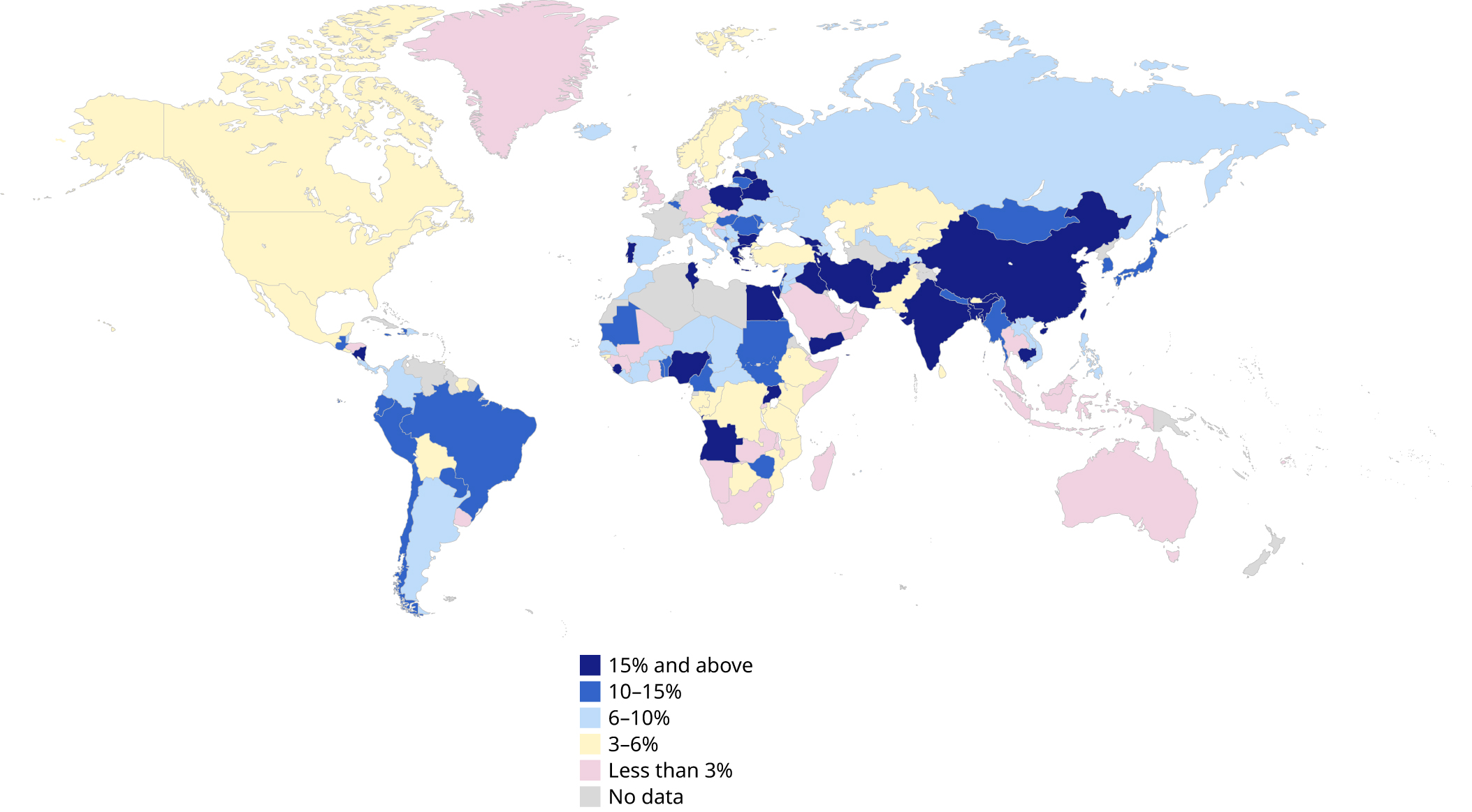
Disclaimer: Boundaries shown do not imply endorsement or acceptance by the ILO. See full ILO disclaimer.
Source: Based on data from the WHO Global Health Observatory.
Inequality also prevails within countries. Available survey data shows important disparities across age of the household head and household age composition more generally. Households headed by older persons and households composed only of older persons have a significantly higher incidence of catastrophic health spending (WHO and World Bank 2023). Various factors are at play, including both higher needs for acute and potentially high-cost care in the last years of life, and lower income in old age. Thus, it is crucial to have social health protection, an adequate old-age pension and long-term care without hardship, although important gaps remain in this respect (Tessier, De Wulf and Momose 2022).
Households globally bear a significant share of healthcare costs, owing to a combination of factors operating at the country level:
-
The absence of universal entitlements to social health protection and/or their ineffective implementation pushes the costs of healthcare onto households, creating incentives to delay or forgo necessary care, and directly impacting health outcomes. Low public expenditure on health correlates with higher rates of impoverishment due to out-of-pocket expenses (figure 4.48).
-
Limited benefit packages (covering few services) push individuals to pay out-of-pocket expenses for any other services they require. This is increasingly common in emerging economies where service coverage has increased since 2000, but social health protection policies lag in updating their benefit packages. Benefit packages must be adapted to population needs as well as developments in the disease burden and in service availability, and must therefore be periodically updated in line with international social security standards.
-
Limited benefit levels (with remaining official user fees and/or co-payments) or the existence of high informal payments represent a significant share of the total cost of care borne by patients. Therefore, even non-catastrophic health expenditure has a significant impoverishing effect (WHO and World Bank 2023). Convention No. 102 stipulates that benefit levels need to be periodically reviewed to stay responsive to population needs.
Since 2000, the share of the global population pushed to the relative poverty line has continuously increased, accounting for almost 1.3 million people in 2019 (WHO and World Bank 2023). Yet, these impoverishing effects are unevenly felt across geographical locations and household composition. Indeed, analysis shows that this indicator’s incidence is three times higher in rural areas than in urban areas, and highest in households that are multigenerational or mostly composed of youth (WHO and World Bank 2023). These realities underline the relevance of guaranteeing the right to social health protection for all as an urgent priority.
It is noteworthy that out-of-pocket spending on health does not include the costs of care seeking (such as transportation costs and lost working time) or lost income due to incapacity to work while convalescing (WHO and World Bank 2023). Therefore, when considering these costs, the impoverishment impact is likely to be much higher. This was demonstrated, for instance, by tuberculosis patient cost surveys supported by the WHO (WHO 2017; 2023a). This evidence led to the integration of social protection in the global strategy to end tuberculosis and the development of guidance in that regard by the WHO and the ILO (WHO 2015a; WHO and ILO 2024).
Figure 4.48 Impoverishment due to out-of-pocket healthcare expenses: Share of general government and out-of-pocket expenditure in total health expenditure, and share of population pushed below a relative poverty line (60 per cent of income or consumption), by region, subregion and income level, 2021 or latest available year (percentage)
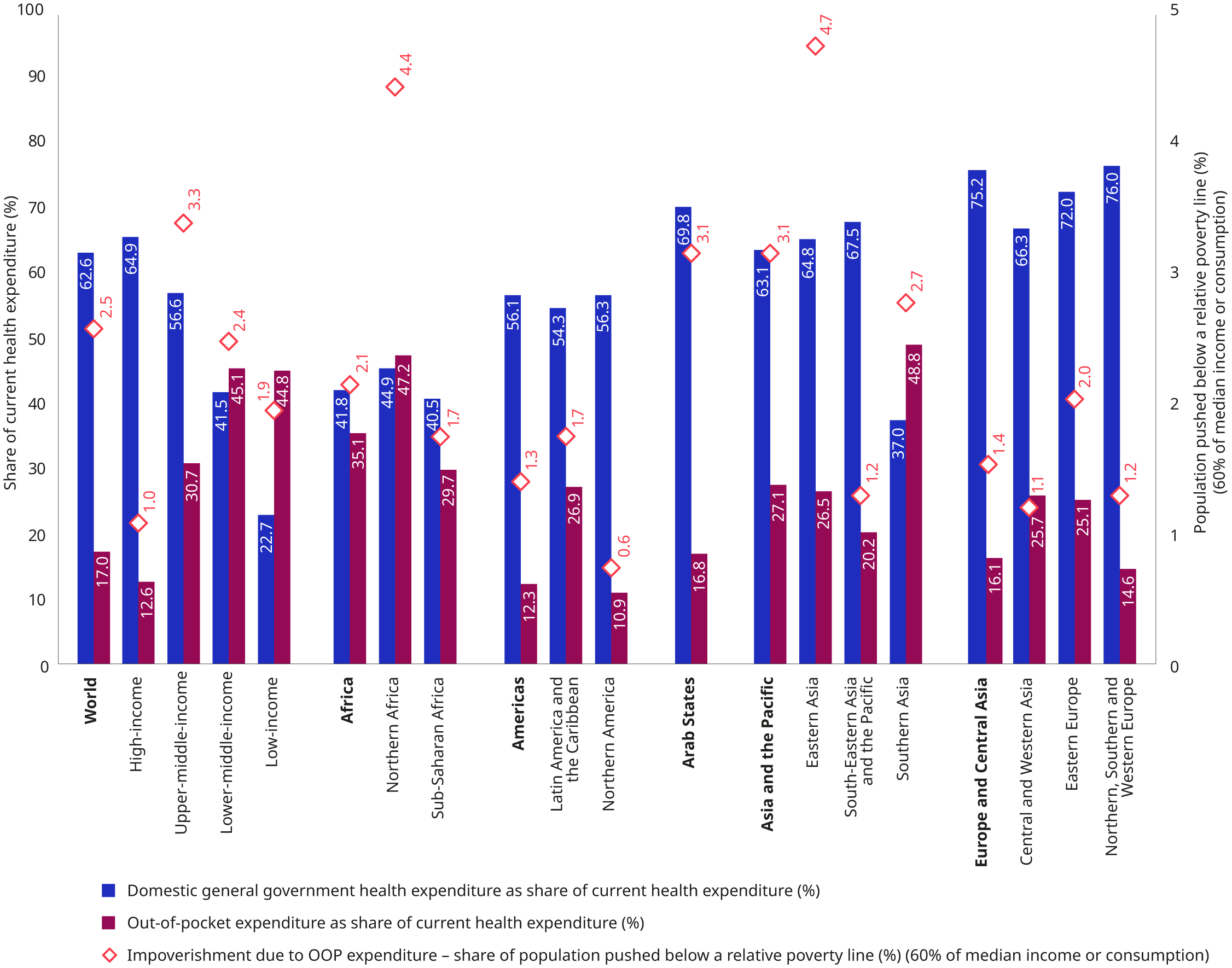
Note: Global and regional estimates are weighted by current health expenditure for domestic general government health expenditure and out-of-pocket expenditure, and by population for the impoverishment due to OOP expenditure.
Source: ILO estimates based on data from the WHO Global Health Expenditure Database and the World Bank World Development Indicators.
4.4.4 Persistent gaps in public financing for health
Insufficient funding is a key determinant of persistent deficits in access to healthcare without hardship. It increases financial hardship risks and lack of effective access to adequate healthcare services. Both taxes and social contributions are captured within general government health expenditure, which represented 62.6 per cent of current health expenditure globally in 2022, with significant regional disparities (figure 4.49).
Figure 4.49 Current health expenditure (CHE) (percentage of GDP) and its composition (percentage), by region, subregion and income level, 2022
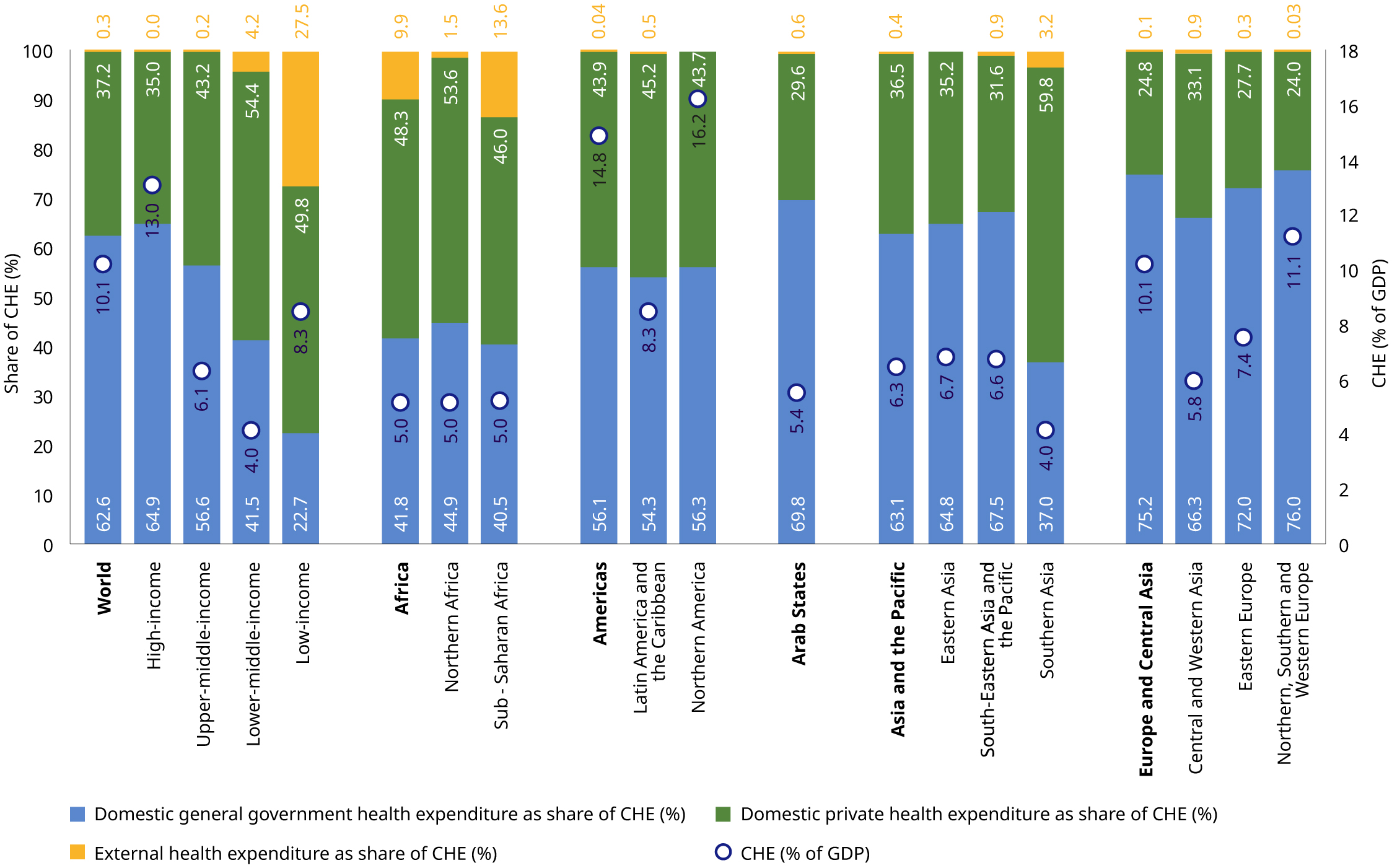
CHE = current health expenditure.
Source: ILO estimates based on data from the WHO Global Health Expenditure Database.
Public domestic financing is the largest source of health financing globally. External health expenditure has a much smaller role, but can be significant in Africa and in the Arab States. International solidarity plays a role in addressing the immediate health needs of the most vulnerable in many humanitarian settings (box 4.23). Consequently, greater alignment with social health protection programmes – and health and social protection policies in general – can support efforts to bridge the humanitarian-development nexus. It can also increase the positive synergies between external and domestic expenditure on health and social protection system strengthening (ILO and UNHCR 2020).
Box 4.23 Accessing healthcare without hardship in the context of protracted crises: Bridging the humanitarian development nexus
|
With multiple ongoing conflicts in their immediate vicinity, Lebanon and Jordan are among the countries with the highest share of refugees hosted within their populations. This situation poses important challenges to the existing medical infrastructure, arrangements in place for social health protection and, more broadly, for social policies to secure the well being of those populations at par with nationals. In both countries, the UNHCR and the UNWRA have taken measures, based on the mandate of the Refugee Convention, 1951, to avoid catastrophic health spending by covering some secondary and tertiary care interventions, at least for the most vulnerable. Those measures are not counted as part of the coverage for social health protection as they are not directly rooted in national law and are largely managed under separate mechanisms from the ones applicable to nationals. Nevertheless, refugees represent an important share of the population, which makes these parallel mechanisms an important purchaser of healthcare services at the national level (ILO 2021e). For instance, coverage under the medical assistance programme for Palestinians represented almost 15 per cent of the population in Jordan and almost 20 per cent in Lebanon in 2021. While this holds true and contributes to saving lives every day, the parallel and temporary nature of these measures, as well as the fact that they are entirely funded out of external sources, tend to act as barriers to their contribution to broad risk pooling and improved purchasing practices of public providers in these countries (ILO 2021e). Moving towards greater alignment with national social health protection policies could contribute to bridging the humanitarian development nexus and reinforcing these policies towards higher levels of inclusiveness and strengthened primary levels of care. |
Although there is consensus that the efficient allocation of resources should be prioritized and geared towards quality care for positive health outcomes, various reports have noted that guaranteeing universal health coverage with appropriate levels of financial protection is challenging if general government health expenditure is below 5 per cent of GDP (Jowett et al. 2016; Røttingen et al. 2014). The regions of Africa, the Arab States, and Asia and the Pacific fall below this target; a tendency most pronounced in Southern Asia, Northern and sub-Saharan Africa, and South-Eastern Asia and the Pacific (figure 4.50).
Figure 4.50 Current health expenditure (CHE) per capita and domestic general government health expenditure (GGHE-D) per capita, by region, subregion and income level, 2022 (US$ PPP)
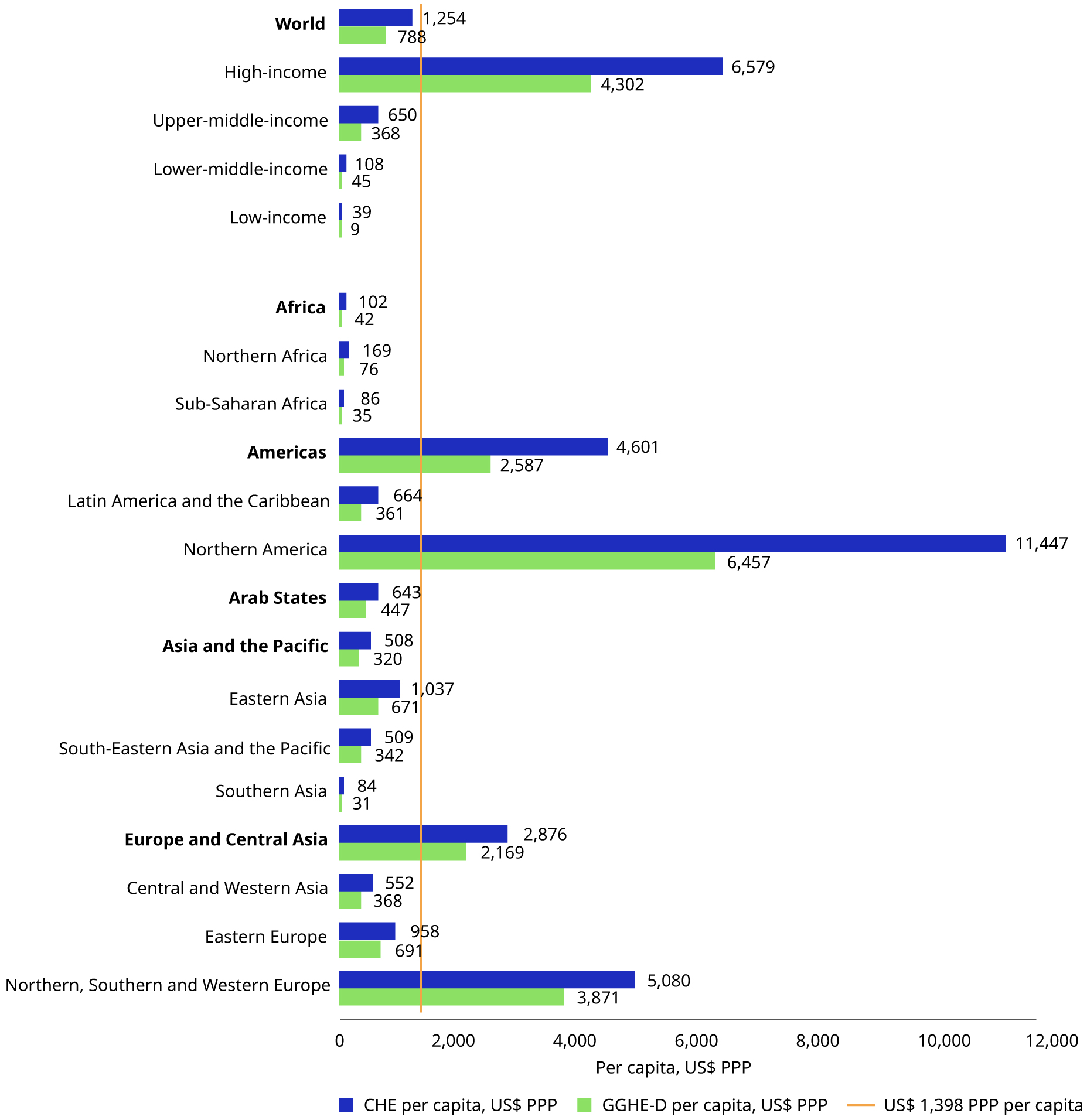
CHE = current health expenditure, GGHE-D = domestic general government health expenditure, US$ PPP = US$ purchasing power parity.
Note: Analysis suggests that countries need to allocate US$1,398 PPP per capita in pooled health spending to reach 80 in the Service Coverage Index (Kruk, Ataguba and Akweongo 2020). Regional estimates are weighted by total population.
Source: ILO estimates based on data from the WHO Global Health Expenditure Database.
Increased public spending on health from pooled sources (such as earmarked and non-earmarked taxes, and social contributions) positively correlates with lower out-of-pocket expenditure on health, while no such correlation was found with funding from voluntary private health insurance (WHO and World Bank 2020). This suggests that publicly mandated schemes, aligned with ILO standards, provide the most appropriate pathway towards financial protection inclusive of the poorest and most vulnerable. Moreover, Northern America, largely driven by the United States, has the lowest share of its population with both mandatory legal entitlements to healthcare benefits and effective protection by a publicly led social health protection scheme within high-income countries (figures 4.41 and 4.42). Yet, it also has the highest current health expenditure as percentage of GDP globally, suggesting that publicly led schemes grounded in a legal framework are also an important catalyst of efficient resource allocation.
